Glossary
↑
When not otherwise indicated, the below definitions are taken from the Illustrated Dictionary of Historic Architecture, edited by Cyril M. Harris, Dover Publications, Inc., New York, 1977. As cited, a number come from the 1997 Mexico Blue Guide, whose exhaustive documentation of the art and architecture of Viceregal Mexico was compiled by expert enthusiast John Collis. Many other sources were used to best summarize the meaning of particular terms, while a certain few represent my own, personally crafted interpretations. Nearly every definition is followed by an illustrative example whose Mexican location is detailed and the term itself italicized.
"Architecture never lies about the people it serves." -- John Cloag
p. xii, Introduction by John Cloag.
A Short History of Architecture by Dora Ware & Betty Beatty (George Allen & Unwin, 1953)
Acanthus
A common plant of the Mediterranean, whose leaves, stylized, form the characteristic decoration of capitals {...}.
Example: Quiroga, Michoacán, San Diego de Alcalá, façade portal, acanthus relief (right)

Acequia
A community-operated watercourse used in Spain and former Spanish colonies in the Americas for irrigation.
(definition from Online The Free Encyclopedia Wikipedia)
Example: San Matías Atzala, Puebla, hacienda San Matías, acequia
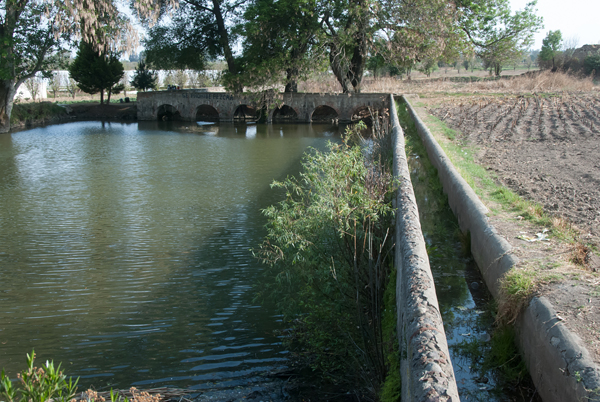
Adobe
A heavy soil composed largely of soil and silt in sufficient quantities to form a matrix in which sand particles are firmly embedded; water is added, and straw, manure and fragments of tile are sometimes combined with this mixture to provide increased mechanical strength and cohesion when it dries. It can be used as a plaster or formed into bricks, often shaped by hand in a wooden form, then sun-dried; widely used in Spanish Colonial Architecture and its derivatives. Adobe brick walls are often plastered to improve resistance to weather; a coating such as slaked lime acts as a stabilizing agent.
Example: Chimayó, New Mexico, El Santuario de Nuestro Señor de Esquipulas, adobe zaguán

Ajaraca
In Southern Spain, an ornament in brick walls, formed of patterns, a half brick deep, more or less complicated.
Example: Chiapa de Corzo, Chiapas, Fuente La Pila o La Corona, flying buttresses, ajaraca
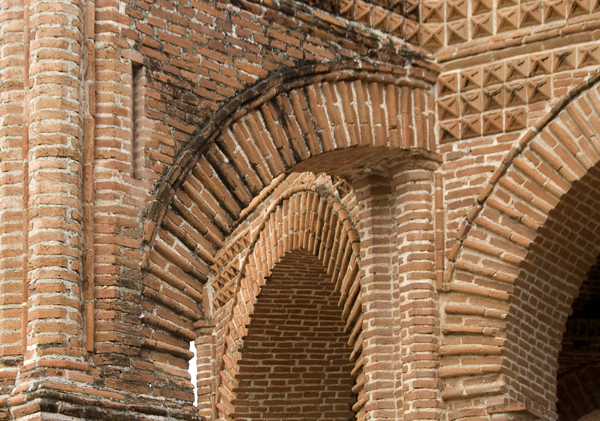
Ajimez
In Islamic architecture, a twin window having arched lights which are separated by a column or mullion.
Example: Puácuaro, Michoacán, San Francisco, façade ajimez
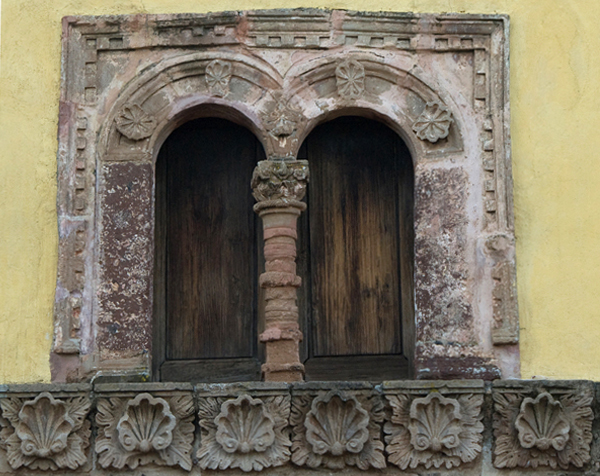
Alfarje
A ceiling of many small pieces of wood worked into a repetitive interlacing design, often found in Moslem and mudéjar work.
(definition from McAndrew, John. The Open-Air Churches of Sixteenth-Century Mexico: Atrios, Posas, Open Chapels and other Studies, Harvard University Press, Cambridge, Massachusetts, 1965, 654)
Example: Acaxochitlán, Hidalgo, La Asunción de María, nave alfarje ceiling

Alfiz
A rectangular molding which frames a horseshoe arch; typical in Moorish architecture.
Example: San Lorenzo Ixtacoyotla, Hidalgo, San Lorenzo, façade alfiz
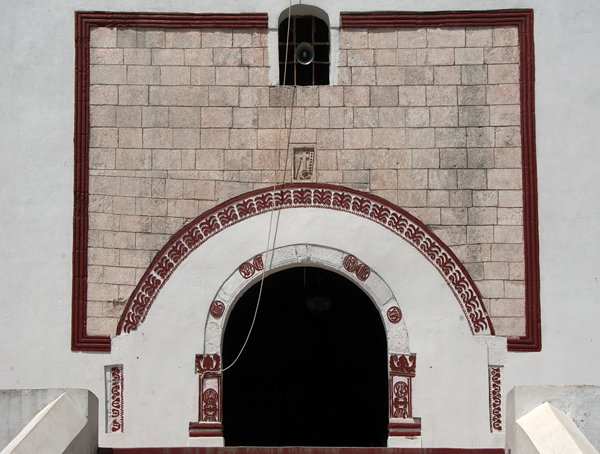
Alhóndiga
Store for wheat and other grains, especially for buying and selling in times of scarcity.
(definition from Collis, John and David M. Mexico Blue Guide, W.W. Norton Co., New York, 1997, p. 104)
Example: Guanajuato, Guanajuato, alhóndiga
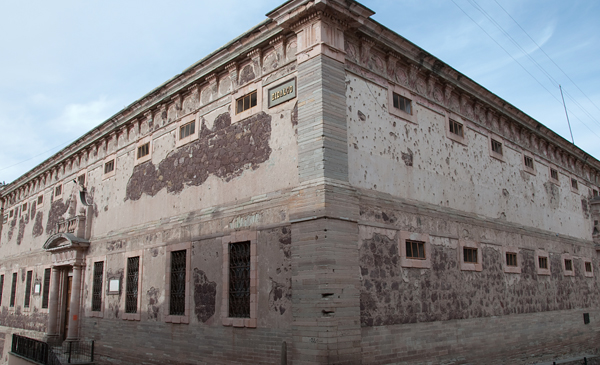
Alicatado
The work which is executed with azulejos; used to decorate pavements and walls, especially in patios.
Example: Puebla, Puebla, La Concordia, Patio de los azulejos, alicatado walls

Aljibe
see Cistern
Example: Coixtlahuaca, Oaxaca, San Juan Bautista, subterranean cloister aljibe
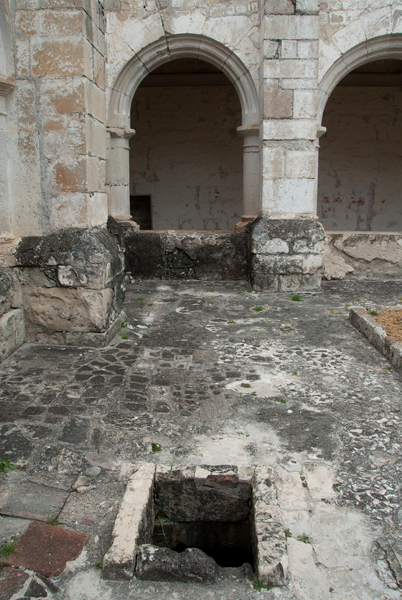
Almizate
The central point of the harneruelo in carved wooden ceilings.
(definition from Online Real Academia Diccionario de la lengua española, personal translation)
Example: Tlaxcala, Tlaxcala, La Asuncón de Nuestra Señora, sotocoro,
alfarje ceiling, harneruelo almizate

Almohadillado
Pattern of square and projecting stones of a façade.
(definition from Collis, John and Jones, David M. Mexico Blue Guide, W.W. Norton & Co., New York, 1997, p. 104)
Example: Jerez de García Salinas, Zacatecas, Palacio Municipal, main portal almohadillado

Ambulatory
A covered walk of a cloister.
Example: Querétaro, Querétaro, San Francisco, lower cloister ambulatory

Anastyle Baroque
Extreme development of baroque (sometimes called Ultrabaroque; after 1750) in church façades and altarpieces, marked by ornamental niche pilasters or seeming absence of any support amid a wealth of decoration.
(definition from Collis, John, and Jones, David M. Mexico Blue Guide, W.W. Norton & Co., New York, 1997, p. 104)
Example: Ixtlán de Juárez, Oaxaca, Santo Tomás, South transept, Our Lady of the Rosary Anastyle Baroque altar
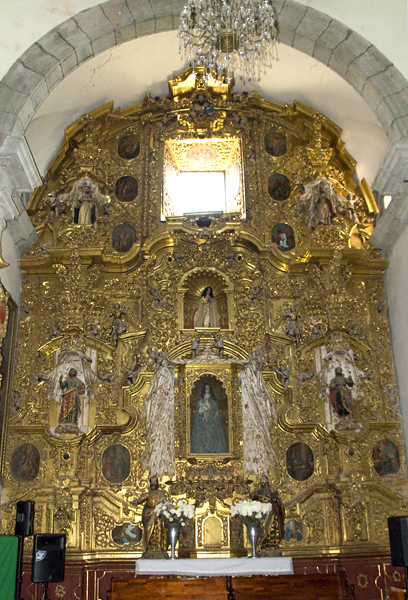
Anta
A pier or pilaster formed by the thickening at the end of a wall.
Example: Cuilápam de Guerrero, Oaxaca, Santiago Matamoros, capilla abierta, preaching pulpit passageway with arch anta
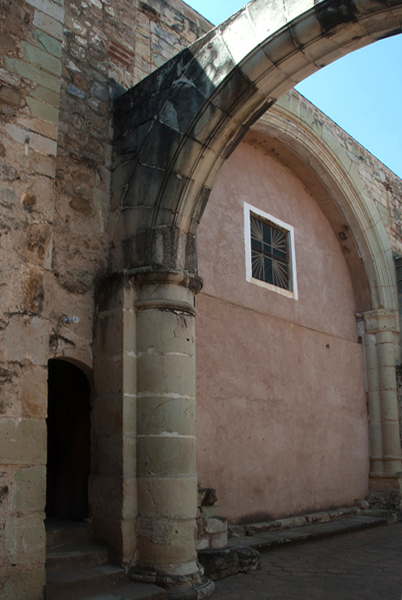
Anteportería
In a 16th century Mexican monastery, a small vestibule which annexes the portería and the cloister, often adorned with murals.
(personal definition)
Example: Morelia, Michoacán, San Agustín, convento anteportería
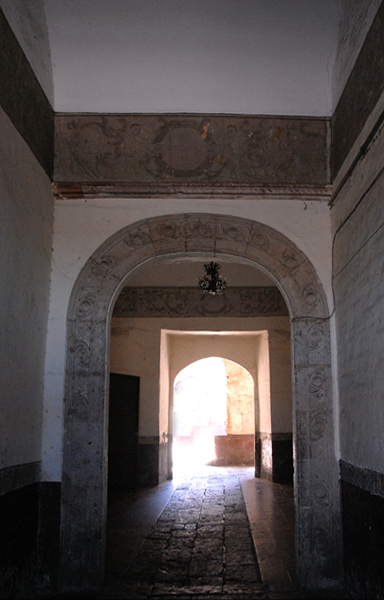
Anterefectory
see Sala de Profundis
Example: Huejotzingo, Puebla, San Miguel Arcángel, anterefectory

Apse
A semicircular (or nearly semicircular) or semi polygonal space, usually in a church, terminating an axis and intended to house an altar.
Example: Cuauhtinchán, Puebla, San Juan Bautista, apse
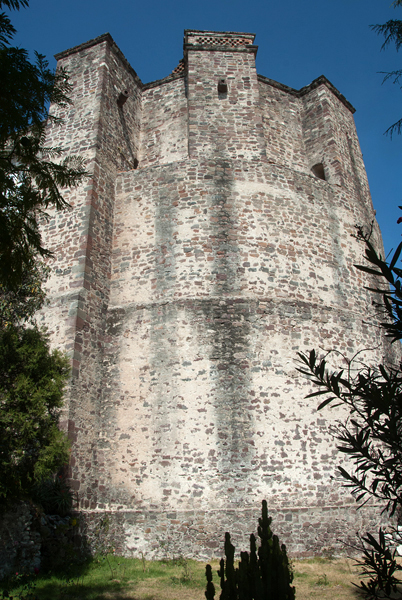
Arabesque
Intricate overall pattern of geometric forms or stylized plants used in Mohammedan countries.
Example: Puebla, Puebla, La Compañía, sacristy lavabo, arabesque azulejos

Arcade
see Loggia
Example: Tlaquepaque, Jalisco, Hospital de Nuestra Señora del Refugio, main patio arcade
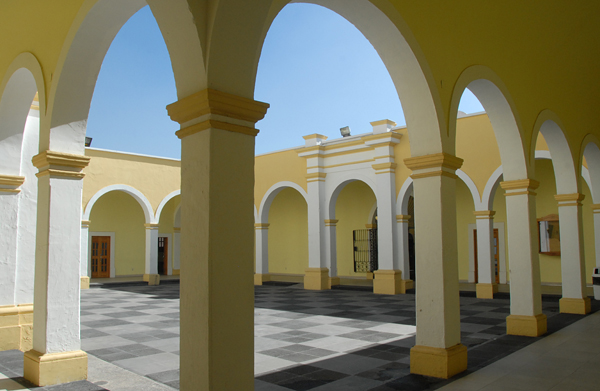
Architrave
In the classical orders, the lowest member of the entablature; the beam that spans from column to column, resting directly upon their capitals.
Example: Maravatío, Michoacán, San Juan Bautista, façade, main portal architrave

Archivolt
An architrave, modified by being carried around a curved opening instead of a rectangular one; an ornamental molding or band of moldings on the face of an arch following the contour of the extrados.
Example: Axotla, D.F., San Sebastián, façade, main portal archivolt
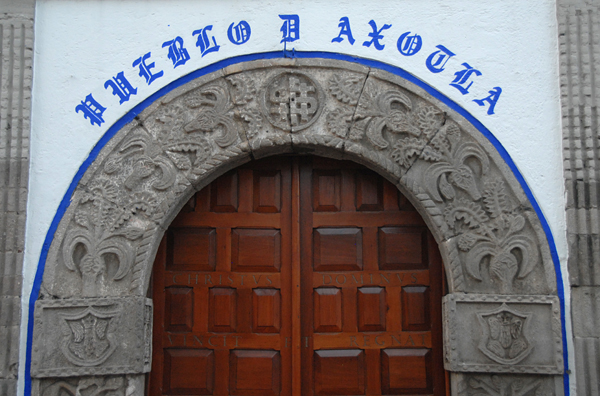
Arma Christi
see Passion Symbols
Example: Ticul, Yucatán, San Antonio de Padua, side retablo dedicated to Our Lord of Esquipulas, Arma Christi details
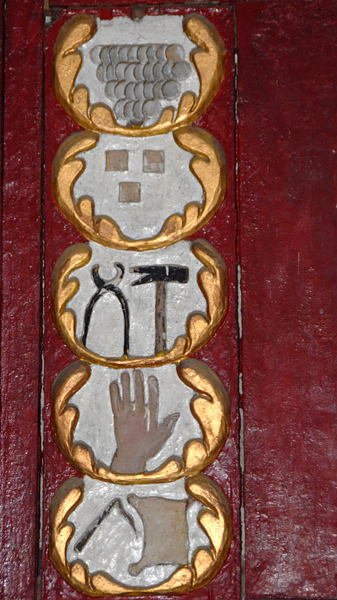
Artesonado
Wood ceiling made up of interlacing strips or sections in a geometric pattern; Islamic in origin.
(definition from: Baird, Joseph Armstrong. The Churches of Mexico 1530-1810, University of California Press, Berkeley and Los Angeles, 1962, p. 61)
Example: Yatzachi el Alto, Oaxaca, San Baltazar, nave artesonado ceiling & beam
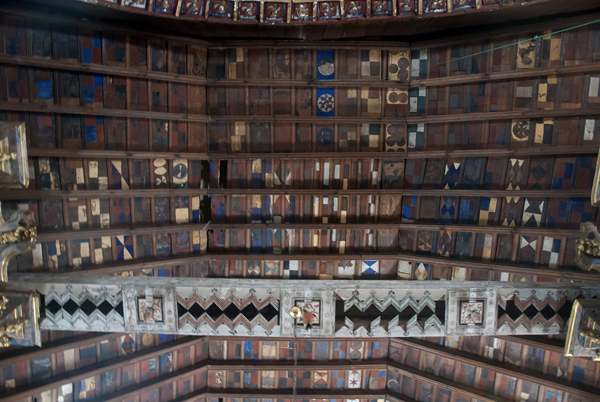
Atlas (Atlantes)
A figure (or figures) of a man in place of a column to support an entablature.
Example: Yanhuitlán, Oaxaca, Santo Domingo, sotocoro Santo Domingo retablo atlas
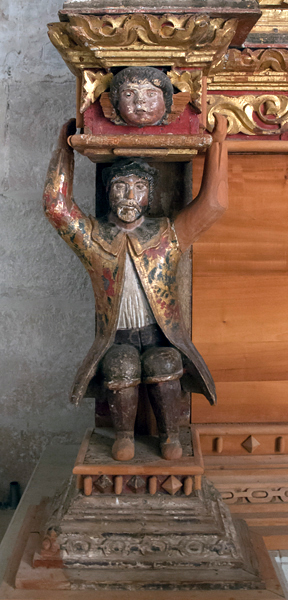
Atrial cross
In colonial Mexico, a stone cross set on a base and usually positioned in the center of the conventual church atrio, at times replete with carvings of the Arma Christi and displaying the face of Christ incised at the front crossing its shaft, neck and arms.
(personal definition)
Example: San Pablo de las Salinas, México, San Pablo, atrial cross, back

Atrio
An atrium. The space in front of a church, usually enclosed or raised on a terrace with the church.
(definition from: Baird, Joseph Armstrong. The Churches of Mexico 1530-1810, University of California Press, Berkeley and Los Angeles, 1962, p. 62)
Example: Metztitlán, Hidalgo, Los Santos Reyes, atrio
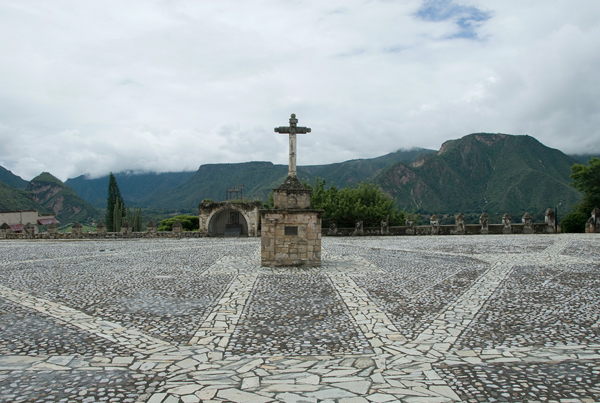
Attic
The highest-most portion of an altarpiece or retablo, often jutting above the top tier and
crowning the entire ensemble in the form of an individual statue or sculptural grouping.
(personal definition)
Example: Ixtlán de Juárez, Oaxaca, Santo Tomás, South nave St. Francis retablo, attic relief, God the Father
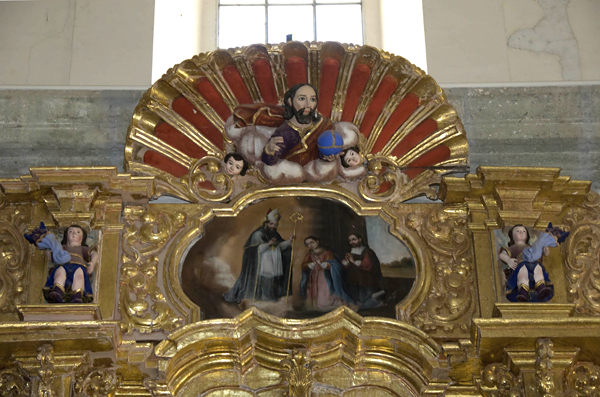
Augustinian
Also called Austin, in the Roman Catholic Church, member of any of the religious orders and congregations of men and women whose contributions are based on the Rule of St. Augustine, {namely the} instructions on religious life written by Augustine, the great Western theologian, and widely disseminated after his death, A.D. 430. More specifically, the name is used to designate members of two main branches of Augustinians, namely, the Augustinian Canons and the Augustinian Hermits, with their female offshoots. The Augustinian Canons, or August Canons (in full, the Canons Regular of Saint Augustine), were, in the 11th century, the first religious order of men in the Roman Catholic Church to combine clerical status with a full common life. The moral impulse emanating from the Roman synods of 1059 and 1063 and the Gregorian Reform led many canons to give up private ownership and to live together according to monastic ideals. By 1150 the adoption of the Rule of St. Augustine by these canons was almost universal. The order grew and flourished until the Protestant Reformation, during which time many of its foundations perished. {…}
(definition from The New Encyclopaedia Britannica, Chicago, London, New Delhi, Paris, Seoul, Sydney, Taipei, Tokyo, 2003, vol I, p. 700)
Example: Actopan, Hidalgo, San Nicolás de Tolentino, sala de profundis, North wall, Erimitic Life mural detail, Augustinian friars
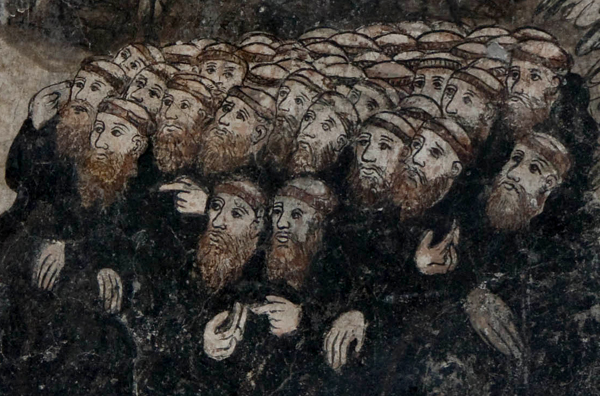
Aureole
A pointed oval frame or glory around the head of body of a sacred figure; the radiance surrounding it.
Example: San Nicolás Atecoxco, Hidalgo, San Nicolás, façade gable, aureole relief

Azulejo
An earthenware tile of Spanish manufacture painted and enameled in rich colors, especially one having a metallic luster.
Example: México, D.F., ex-Hospital San Juan de Dios, kitchen azulejos
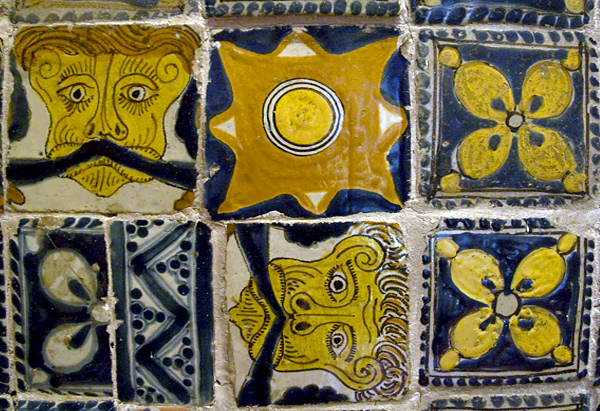
Baldachin
An ornamental canopy over an altar, usually supported on columns, or a similar form over a tomb or throne.
Example: Puebla, Puebla, Santo Domingo, Capilla del Rosario, high altar baldachin
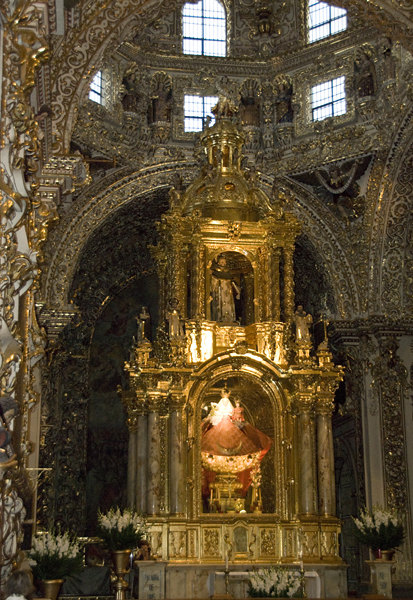
Balustrade
An entire railing system (as along the edge of a balcony) including a top rail and its balusters, and sometimes a bottom rail.
Example: México, D.F., Casa de los Condes de San Mateo de Valparaíso, spiral stairwell & balustrade
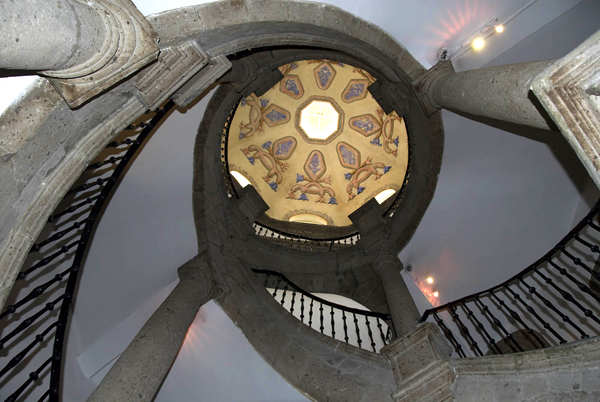
Banderole
A decorative representation of a ribbon or long scroll, often bearing an emblem or inscription.
Example: Aculco, México, San Jerónimo, gable relief, St. Rose of Lima emitting a banderole

Baptismal font
A stone, metal, or wooden receptacle, usually ornamented, for holding baptismal water used in the solemn administration of the sacrament. According to common law, every parish church must have a baptismal font. (definition from Hardon, John A. Modern Catholic Dictionary, Doubleday & Company, Inc., Garden City, New York, 1966, p. 53)
Example: Charapán, Michoacán, San Antonio, baptismal font
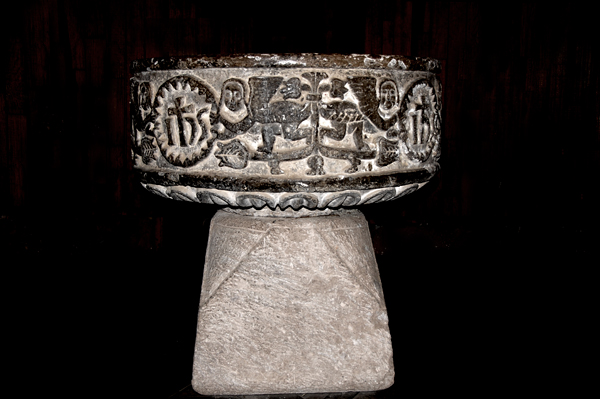
Baptistry / Baptistery
A building or part of one where the sacrament of baptism is administered.
Example: San Miguel del Valle, Oaxaca, San Miguel Arcángel, baptistry with baptismal font & mural
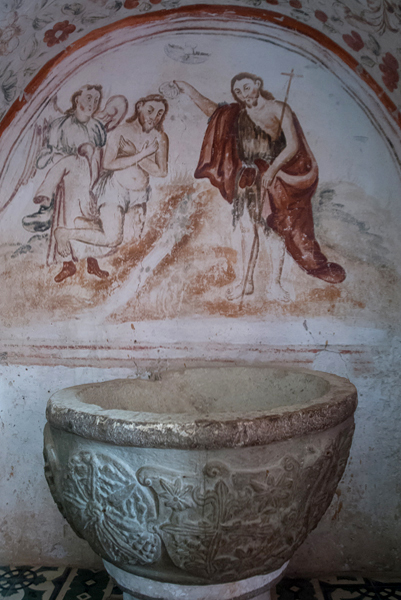
Baroque
In Mexican architecture the style may be taken as developing from a more subjective and imaginative approach than the Mannerist leading to a dramatic focus of design elements and manifesting varying phases: (i) transitional (from mid-17C); (ii) solomonic baroque, marked by use of salomónica (late 17C-early 18C; (iii) churrigueresque (circa 1720-80); (iv) anastyle baroque; (v) neostyle baroque (both after 1750).
(definition from Collis, John, and Jones, David M. Mexico Blue Guide, W.W. Norton & Co., New York, 1997, pps. 104-105)
Example: Guadalajara, Jalisco, Palacio Gobierno, main Baroque entrance
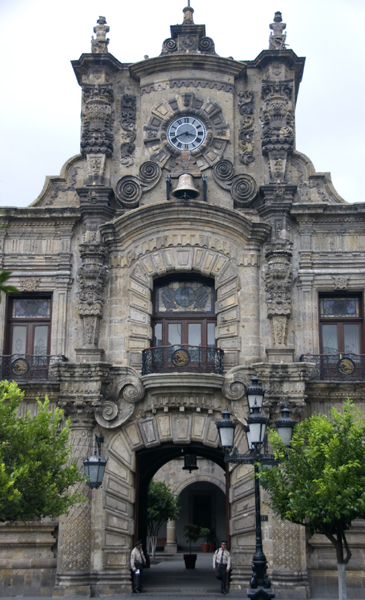
Barrel Vault
A masonry vault of plain, semicircular cross section supported by parallel walls or arcades; a vault having a semi cylindrical roof.
Example: Ocuituco, Morelos, Santiago Apóstol, lower cloister ambulatory, barrel vault
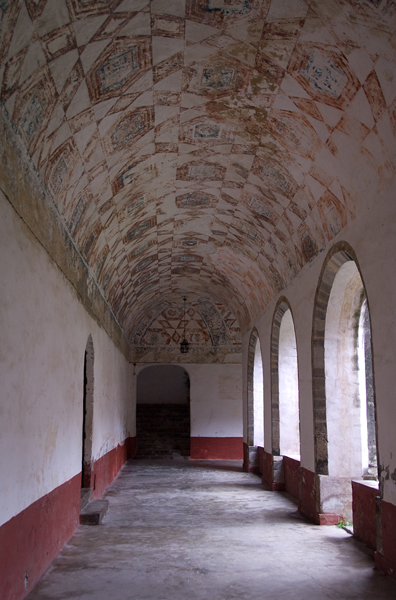
Basilica
The form of an early Christian church, a central high nave with clerestory, lower aisles along the sides only, with a semicircular apse at the end.
Example: Hueytlalpan, Puebla, San Andrés, basilica interior
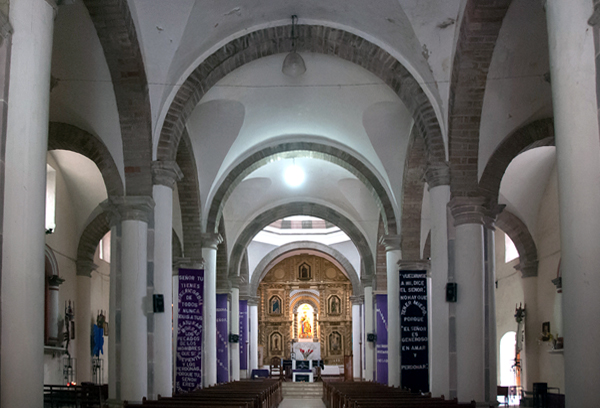
Basket (handle) Arch
A flattened arch designed by joining a quarter circle to each end of a false ellipse.
Example: Coatlinchán, México, San Miguel Arcángel, lower cloister walk, basket-handle arches
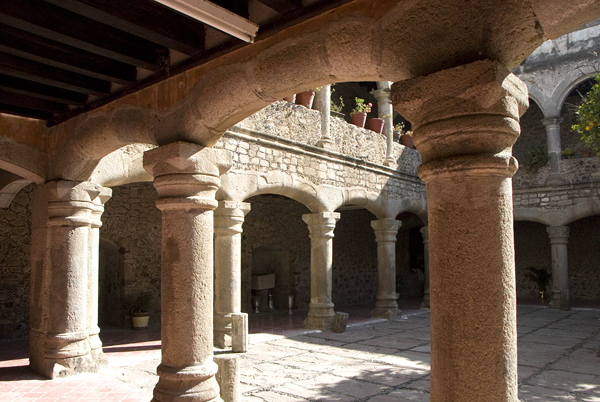
Bas-relief
Sculptural relief in which the projection from the surrounding surface is slight and no part of the modeled form is undercut.
Example: Yecapixtla, Morelos, San Juan Bautista, façade, main portal, inner & outer left pillar base bas-reliefs
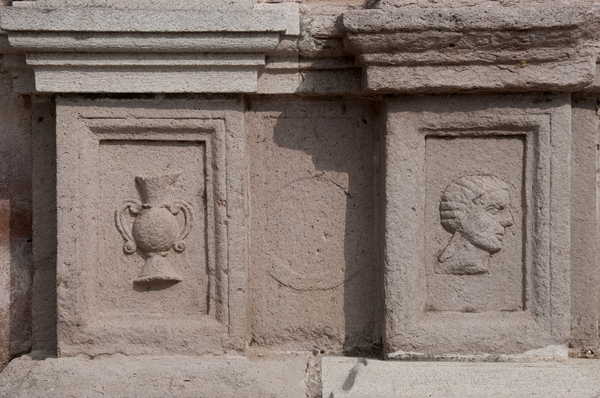
Bastion
A defense work, round, rectangular, or polygonal in plan, projecting from the outer wall of a fortification, principally to defend the adjacent perimeter.
Example: Campeche, Campeche, Baluarte de San Pedro, bastion
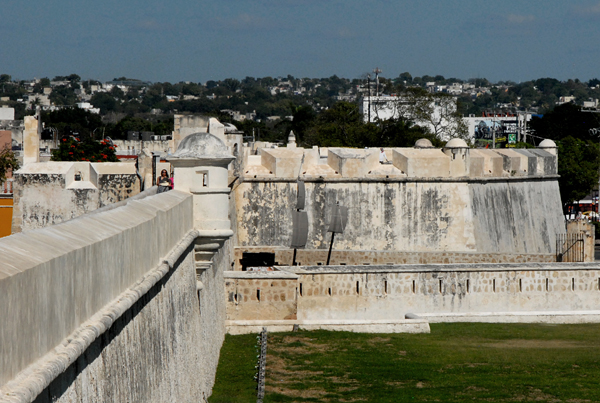
Battlement
Crenellation. A fortified parapet with alternate solid parts and openings, termed respectively merlons and embrasures or crenels.
Example: Cuauhtinchán, Puebla, San Juan Bautista, atrial wall battlement

Bénitier
see Stoup
Huamariza, Chihuahua, San Ignacio, nave bénitier

Black Robe
see Jesuit
Example: San Javier, Baja California Sur, San Francisco Javier de Viggé-Biaundó, right transept altar detail, St. Ignatius, founder of the Black Robes

Black Friar
see Dominican
Example: Cuilápam de Guerrero, Oaxaca, Santiago Matamoros, convento mural, Dominican Order lineage, Black Friars

Boss
A projecting, usually richly carved ornament placed at the intersection of ribs, groins, beams, etc. or at the termination of a molding.
Example: Cuernavaca, Morelos, La Asunción de Nuestra Señora, sotocoro vault boss

Broken Pediment
A pediment in Roman and Baroque architecture that has been split apart at its apex or at the center of its base. When broken at its apex, the gap is often filled with an urn, a cartouche, or other ornament.
Example: Sultepec, México, San Miguel Arcángel, façade, choir window, broken pediment

Buttressing
An exterior mass of masonry set at an angle to or bonded into a wall which it strengthens or supports; buttresses often absorb lateral thrusts from roof vaults.
Example: Querétaro, Querétaro, San Isidro, exterior nave buttressing
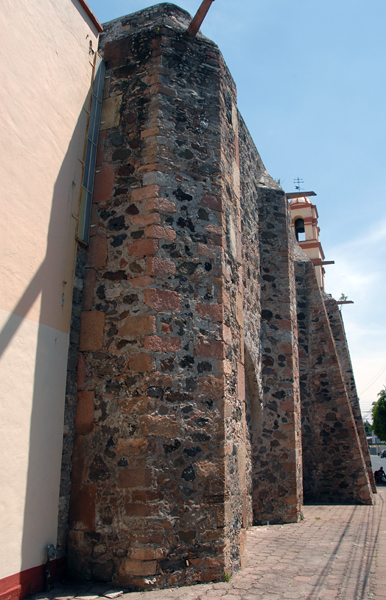
Cabildo de indios
see Tecpan
Example: Teposcolula, Oaxaca, Cabildo de indios
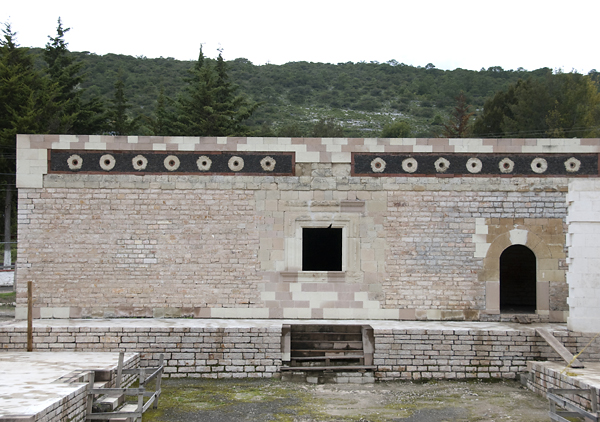
Cacique
Native term (West Indian origin) for chief.
(definition from Collis, John, and Jones, David M. Mexico Blue Guide, W.W. Norton & Co., New York, 1997, p. 105)
Example: Los Angeles, California, County Museum of Art, Folding Screen with Indian Wedding and Flying Pole, closeup, cacique
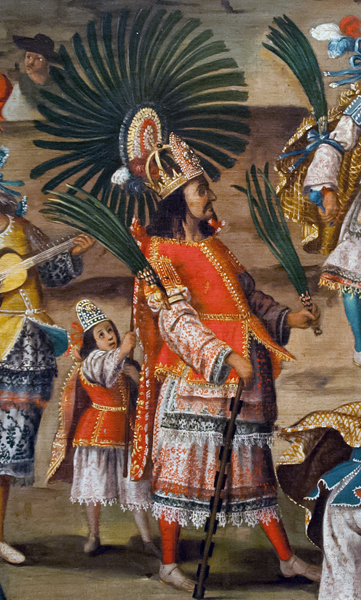
Caja de agua
see Cistern
Example: Cuauhtinchán, Puebla, San Juan Bautista, convento caja de agua
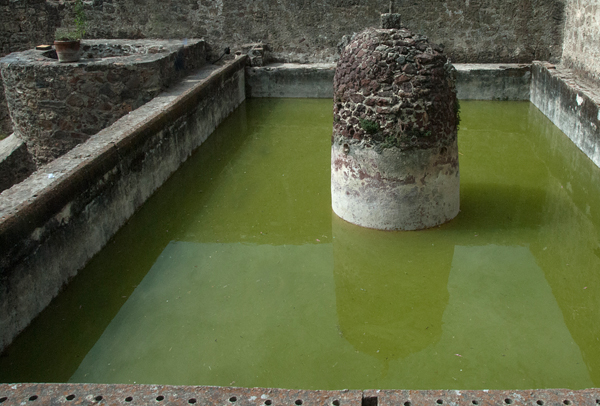
Camarín
Special, small room for robing an image and storing its adornments.
(definition from: Baird, Joseph Armstrong. The Churches of Mexico 1530-1810, University of California Press, Berkeley and Los Angeles, 1962, p. 62)
Example: Atotonilco, Guanajuato, Santuario de Jesús Nazareno, Capilla del Rosario, camarín de la Virgen, conchal wall
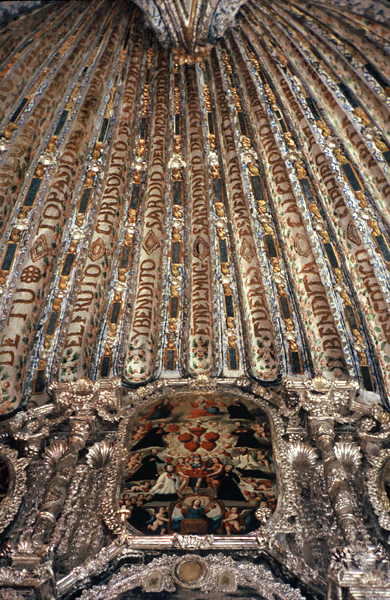
Candelieri
A term, taken from the Italian, denoting a kind of ornamental decoration, usually used in sculpture and architecture, but which can be applied to textile decoration. It consists of a vegetable decoration in which some types of leaves as acanthus or tendril ones are shown in vertical stripes or columns.
(definition Online from OpenLink Software)
Example: Chan Cenote, Yucatán, San Román, façade, main portal, right pilaster candelieri relief

Canephora (ae)
A caryatid with basket on her {his} head; used either as a support or as a freestanding garden ornament.
Example: Tetlanohcan, Tlaxcala, San Francisco, high altar closeup, canephorae

Caña de maíz
Corn pith.
(definition from Collis, John, and Jones, David M. Mexico Blue Guide, W.W. Norton & Co., New York, 1997, p. 105)
Example: México, D.F., Museo Soumaya, Christ Expiring on the Cross, caña de maiz
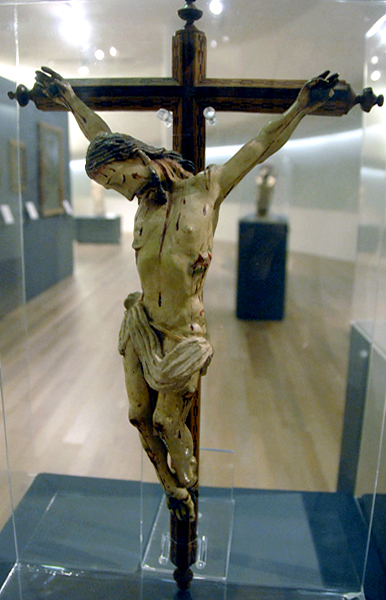
Cantoría
A church choir gallery.
Example: México, D.F., San Fernando, North transept mural & cantoría
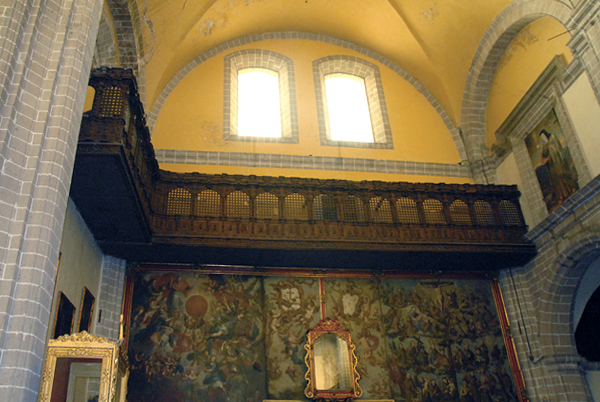
Capilla abierta
An open chapel; the phrase is used loosely for certain structures of sixteenth century Mexican monasteries, usually adjacent to the church. The true open chapel had provisions for celebration of the Mass – a consecrated altar for the Host.
(definition from: Baird, Joseph Armstrong. The Churches of Mexico 1530-1810, University of California Press, Berkeley and Los Angeles, 1962, p. 62)
Example: Coixtlahuaca, Oaxaca, San Juan Bautista, capilla abierta

Capilla de indios
The generally used sixteenth century term for a capilla abierta. (definition inferred from McAndrew, John. The Open-Air Churches of Sixteenth-Century Mexico: Atrios, Posas, Open Chapels and other Studies, Harvard University Press, Cambridge, Massachusetts, 1965, p. 340)
Example: Dzibilchaltún, Yucatán, archeological site, capilla de indios

Capilla posa
A processional oratory (rarely or never a chapel) at each of the corners of some sixteenth-century Mexican monastic atriums.
(definition from: Baird, Joseph Armstrong. The Churches of Mexico 1530-1810, University of California Press, Berkeley and Los Angeles, 1962, p. 67)
Example: Calpan, Puebla, San Andrés, Northwest atrio corner, capilla posa, East façade

Capital
The topmost member, usually decorated, of a column
pilaster, anta, etc. It may carry an architrave or an arcade or be surmounted by an impost block.
Example: Erongarícuaro, Michoacán, Asunción de Nuestra Señora, portería, arch capital
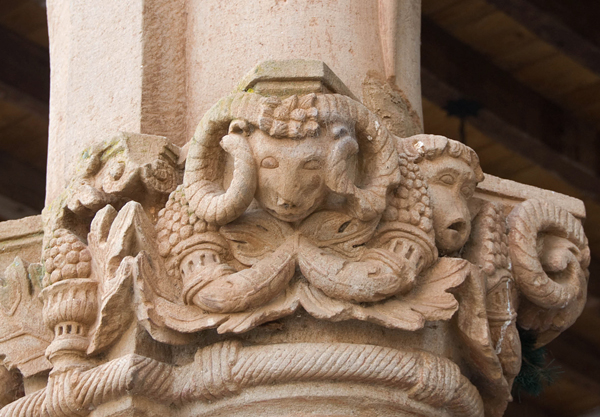
Capuchin
Member of the order of Friars Minor Capuchin (O.F.M.Cap.), an autonomous branch of the Franciscan order of religious men, begun as a reform movement in 1525 by Matteo da Bascio, who wanted to return to a literal observance of the rule of St. Francis of Assisi and to introduce elements of the solitary life of hermits. {…}
(definition from The New Encyclopaedia Britannica, Chicago, London, New Delhi, Paris, Seoul, Sydney, Taipei, Tokyo, 2003, vol II, p. 838)
Carmelite
Member of one of the four great Mendicant orders (those whose corporate as well as personal property made it necessary for them to beg for alms) of the Middle Ages. The origin of the order can be traced to Mt. Carmel in Palestine, where a number of devout men, apparently former pilgrims and crusaders, established themselves near the traditional foundation of Elijah, an Old Testament prophet, about 1155. Their rule was written between 1206 and 1214 by St. Albert, Latin patriarch of Jerusalem, and approved in 1226 by Pope Honorius III. {…}
(definition from The New Encyclopaedia Britannica, Chicago, London, New Delhi, Paris, Soeul, Sydney, Taipei, Tokyo, 2003, vol II, p. 876)
Example: San Angel, D.F., San Angelo Martír, Capilla del Señor de Contreras, Carmelite lineage painting
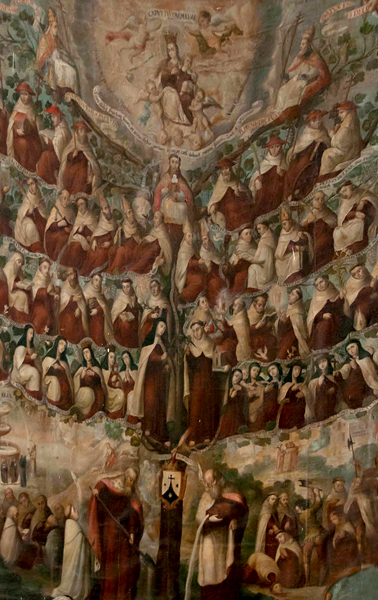
Caracol
A staircase, tightly wound and snaillike (caracol meaning “snail” in Spanish), constructed within a church bell-tower and most commonly found in those of the Yucatan peninsula. (personal definition)
Example: Sacalum, Yucatán, San Antonio de Padua, façade & caracol
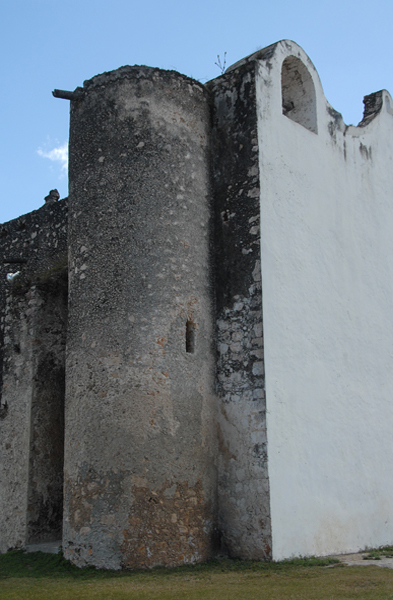
Carnel
see Embrasure
Example: Jaltepec, Hidalgo, San Francisco, atrial wall, crenellation carnel

Cartouche
An ornamental tablet often inscribed or decorated, and framed with elaborate scroll-like carvings.
Example: Chimaltitlán, Jalisco, San Pascual de Bailón, façade, main portal, archivolt keystone cartouche, The Immaculate Conception
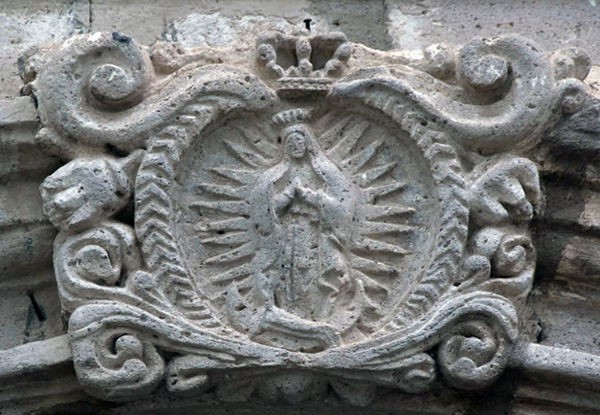
Caryatid
A supporting member serving the function of a pier, column or pilaster and carved or molded in the form of a draped, human, female figure.
Example: Libres, Puebla, San Juan Bautista, high altar caryatids
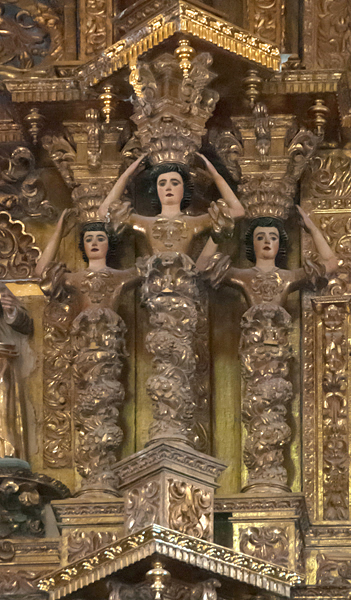
Casa curial
see Rectory
Example: Tixmehuac, Yucatán, San Miguel Arcángel, casa curial
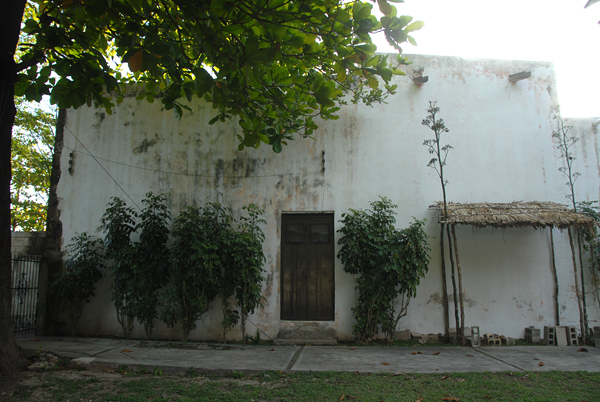
Casa fuerte
A wall, defensive residence usually belonging to a noble family.
(definition from Online Diccionario panhispánico del español jurídico (personal translation)
Example: Cuernavaca, Morelos, the casa fuerte known as Palacio de Cortés
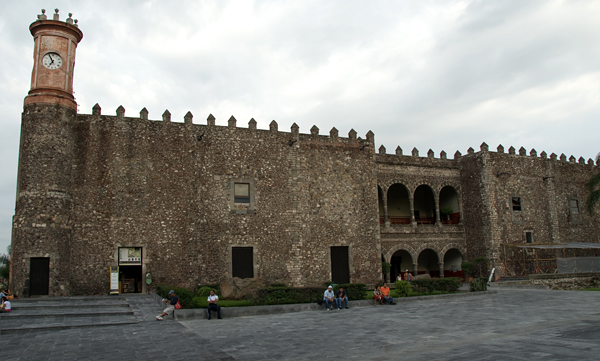
Casa grande
In an hacienda the building which served as residence to the family owners of the complex. (personal definition)
Example: San Antonio Matate, Jalisco, hacienda San Antonio, casa grande
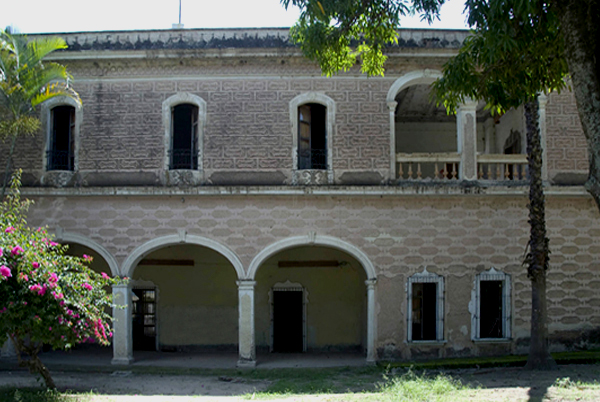
Casco
A Spanish word with multiple meanings; with respect to Mexican haciendas referring to the outer walls of the complex.
(personal definition)
Example: Tenextepec, Veracruz, hacienda San Antonio, casco

Castellated
Bearing the external fortification elements of castle, in particular, battlements, turrets, etc.
Example: Campeche, Campeche, castellated Fuerte de San José el Alto
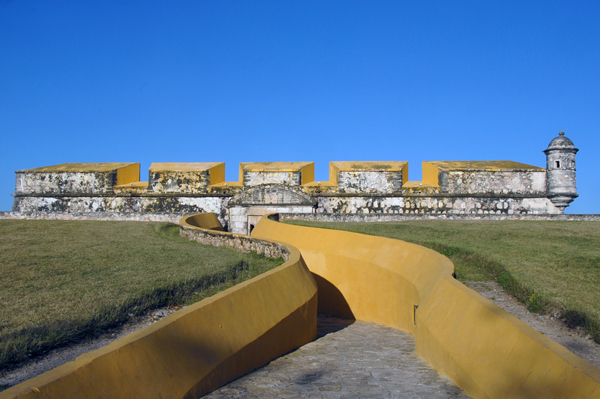
Catechumen
A learner, a person being instructed {for} receiving baptism and being admitted into the Church {…}.
(definition from Hardon, John A. Modern Catholic Dictionary, Doubleday & Company, Inc., Garden City, New York, 1966 p. 86)
Example: San Lucas Evangelista, Jalisco, young contemporary catechumens
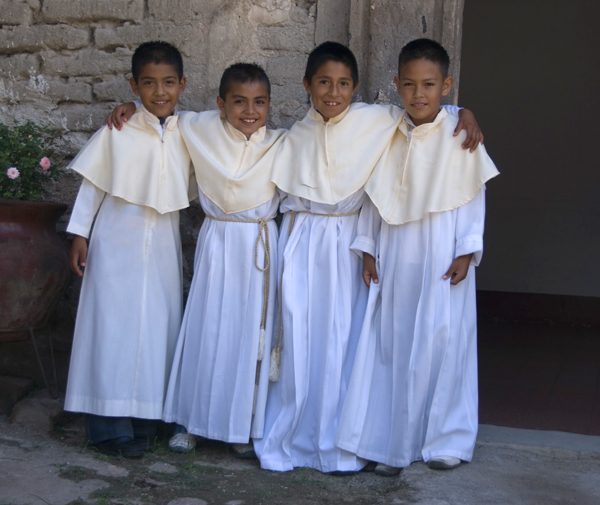
Censer
A vessel for burning incense especially a covered incense burner swung on chains in a religious ritual.
(definition from Webster’s Ninth New Collegiate Dictionary, Merriam-Webster Inc., Publishers, Springfield, Massachusetts, 1983, p. 220)
Example: Yatzachi el Alto, Oaxaca, San Baltazar, sanctuary censer
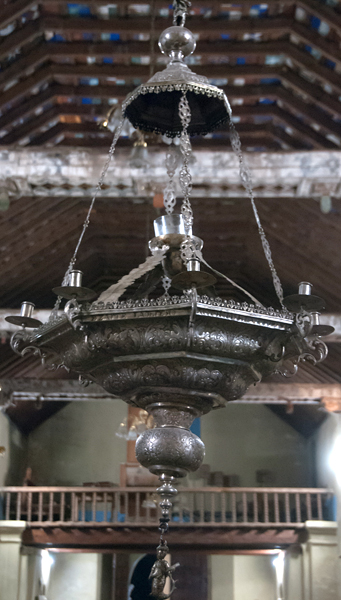
Chancel
see Sanctuary
Example: Nicolás Romero, Michoacán, San Andrés, chancel
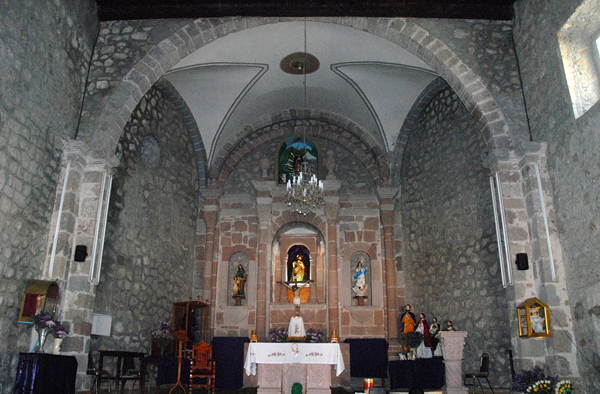
Chancel arch
An arch which, in many churches, marks the separation of the chancel or sanctuary from the nave or body of the church.
Example: Tlahuelilpa, Hidalgo, San Francisco, nave & chancel arch

Chemin-de-ronde
A continuous gangway behind a rampart, providing a means of communication along a fortified wall.
Example: Cuauhtinchán, Puebla, San Juan Bautista, exterior buttressing & chemin-de-ronde
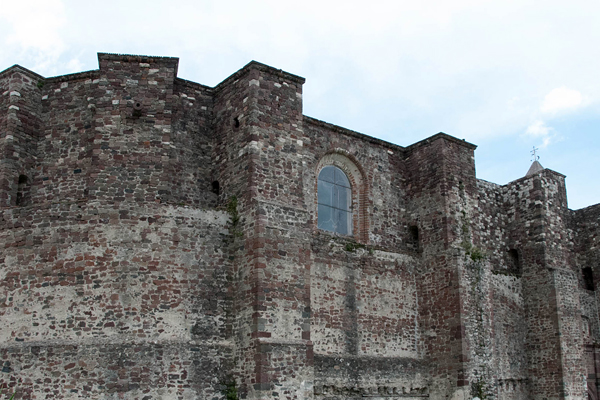
Cherub(im)
Heavenly creatures mentioned in the Bible as guardians and protectors. Cherubim were the sentinels station at at Eden (Genesis 3:24); they were golden figures erected on the Ark (Exodus 25:18). Yahweh mounted a cherub to rush to the rescue of David from his enemies (II Samuel 22:11). In Christian tradition the cherubim are identified as angels.
(definition from Hardon, John A. Modern Catholic Dictionary, Doubleday & Company, Inc., Garden City, New York, 1966, p. 96)
Example: Santa Cruz, Tlaxcala, Santa Inés, high altar, cherubim
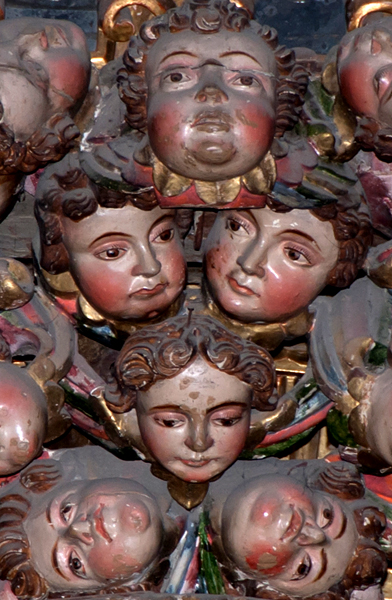
Chichimec
Generic term for Nomadic peoples of Mesoamerica proper, who frequently caused problems for urbanized Mesoamericans by invasions/migrations.
(definition from Collis, John, and Jones, David M. Mexico Blue Guide, W.W. Norton & Co., New York, 1997, p. 105)
Example: Ixmiquilpan, Hidalgo, San Miguel Arcángel, nave mural, Chichimec warrior
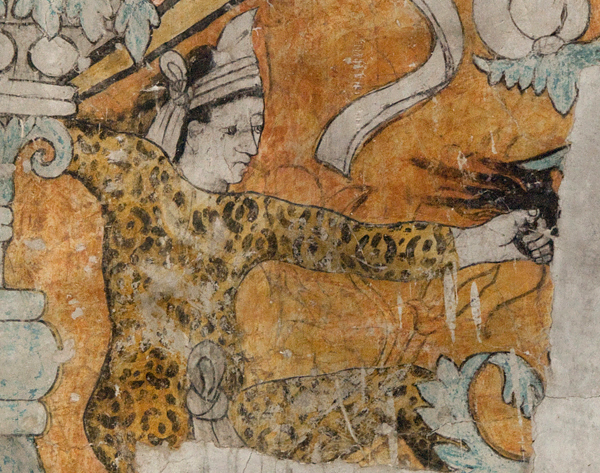
Chiluca
A gray-white stone, like limestone.
(definition from Early, James. The Colonial Art of Mexico, Southern Methodist University Press, Dallas, 2001, p. 207)
Example: México, D.F., La Valvanera, twin portal window closeup, fluted pillars & finials in chiluca stone
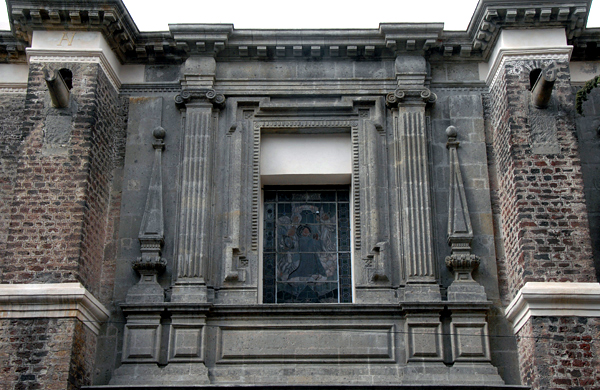
Chinking
Material used for filling a chink in a wall.
Example: Zinapécuaro, Michoacán, San Juan Bautista, bell-tower detail, chinking with stone, mortar, obsidian & jade

Choir loft
A balcony choir area.
Example: Yautepec, Morelos, La Asunción, choir loft
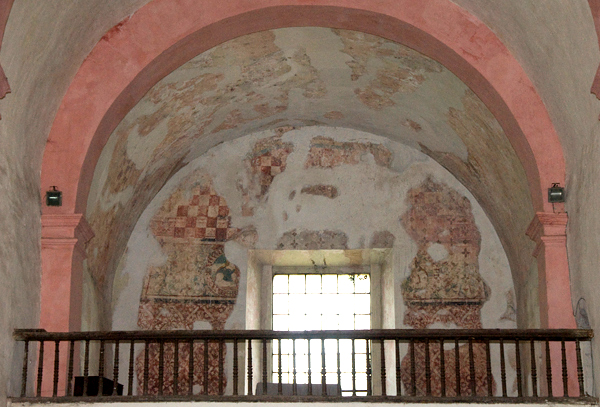
Christogram
A graphic symbol of Christ.
(definition from Webster’s Ninth New Collegiate Dictionary, Merriam-Webster Inc., Publishers, Springfield, Massachusetts, 1983, p. 322)
Example: Acolman, México, San Agustín, small cloister, atrial cross, base relief, Christogram
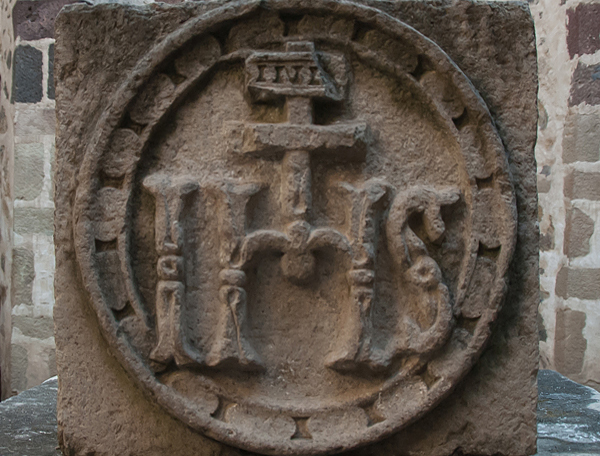
Churrigueresque
In Mexico, an extremely ornamental architectural style (circa 1720-1800) marked by the use of the estípite.
(definition from Collis, John, and Jones, David M. Mexico Blue Guide, W.W. Norton & Co., New York, 1997, p. 105)
Example: Xicohtzingo, Tlaxcala, San Toribio, churrigueresque transept retablo
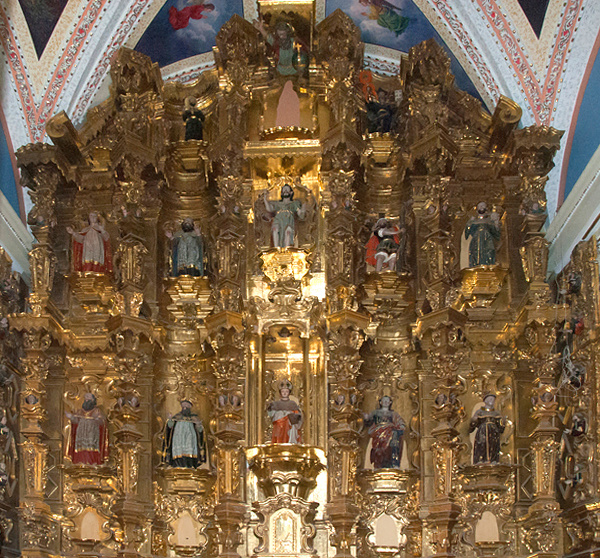
Cistern
An artificial reservoir or tank for storing water at atmospheric pressure {…} for use when required.
Example: Singuilucan, Hidalgo, San Antonio, cloister cistern
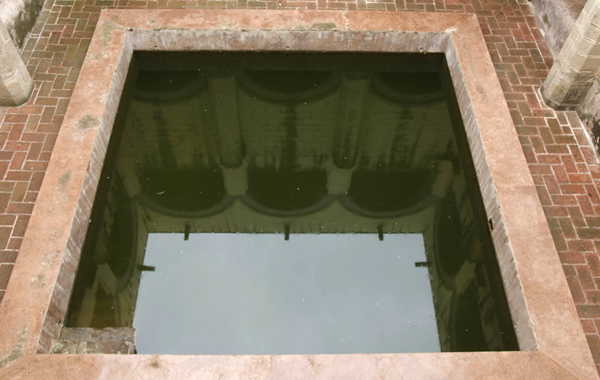
Clerestory
An upper zone of wall pierced with windows that admit light to the center of a lofty room.
Example: Chihuahua, Chihuahua, Nuestra Señora de Regla y San Francisco de Asís, nave clerestory
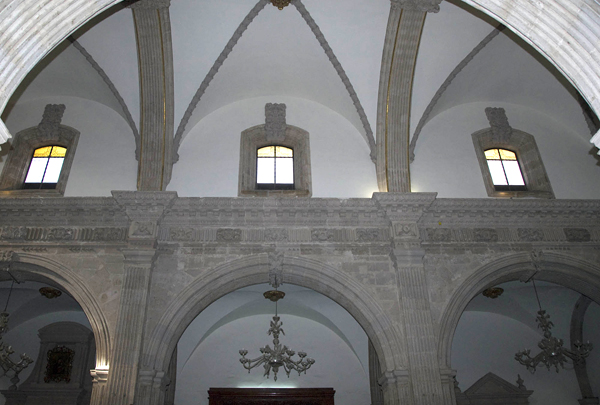
Cloister
A covered walk surrounding a court, usually linking a church to other buildings of a monastery.
Example: Huexotla, México, San Luis Obispo, convento cloister
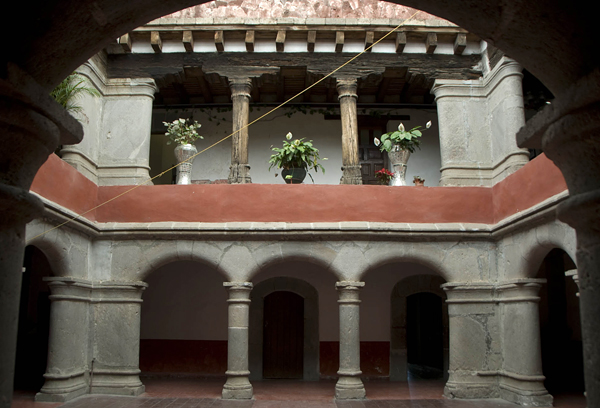
Coffering
Ceiling {…or surfaces} with deeply recessed panels, often highly ornamented.
Example: Tlaxiaco, Oaxaca, Santa María de la Asunción, façade portal, archivolt coffering
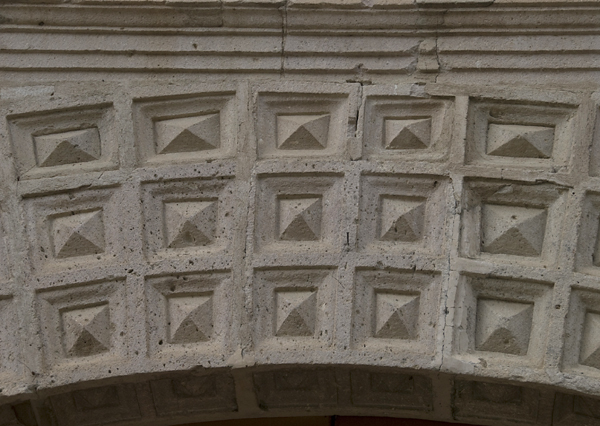
Cofradía
A fraternity or brotherhood organized by members of jurisdictional authority for the purpose of engaging in works of piety (worshipping a saint, the Virgin Mary, etc.) or to provide certain services related to the specific worship.
(definition from On-line Diccionario Cofrade, catholic.net (personal translation)
Example: Sayula, Jalisco, Cofradía chapel
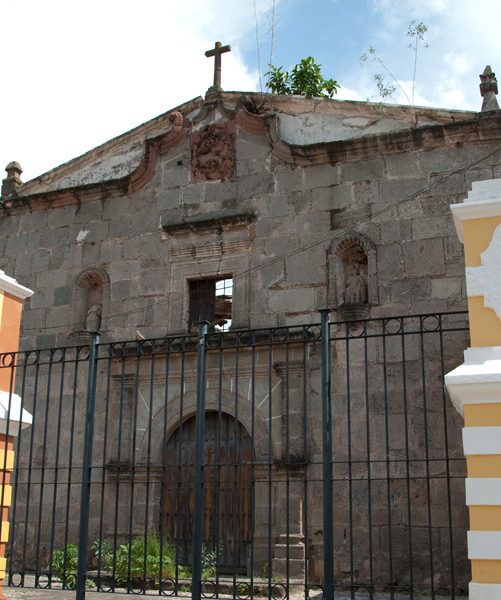
Confessional
A small booth furnished with a seat for a priest and a screen or latticed window through which the penitent may talk to the priest, who is hidden; the penitent may or may not be visible to the public.
Example: Magdalena Salinas, D.F., La Magdalena, nave confessional

Convento
In New Spain, a community of friars and missionizing centre. A community of nuns in town.
(definition from Collis, John, and Jones, David M. Mexico Guide Book, W.W. Norton & Co., New York, 1997, p. 105)
Note: I use the word convento interchangeably
with ‘monastery’. Whereas the word 'convent' in English defines a
society of nuns, for the purposes of this site it refers to either a
community of men or women, although most likely men within the
context of 16th century Mexico. At times it may also be used to
describe the actual physical compound once inhabited by the religious.
Example: Huaquechula, Puebla, San Martín, convento
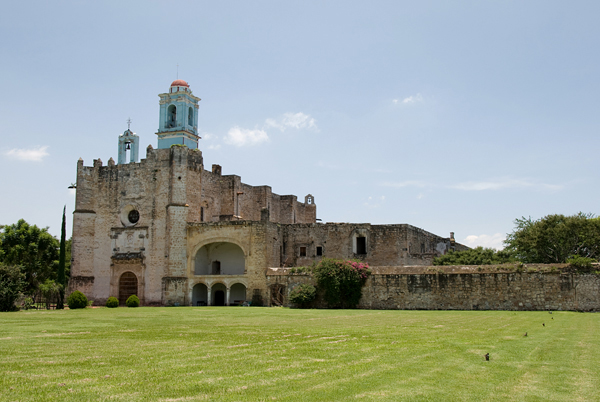
Coping
A protective cap, top, or cover of a wall, parapet, pilaster, or chimney; often of stone, terra-cotta, concrete, metal, or wood. May be flat, but commonly sloping, double-beveled, or curved to shed water so as to protect masonry below from penetration of water from above. Most effective if extended beyond wall face and cut with a drip.
Example: Bolaños, Jalisco, San José, façade relief & roof coping
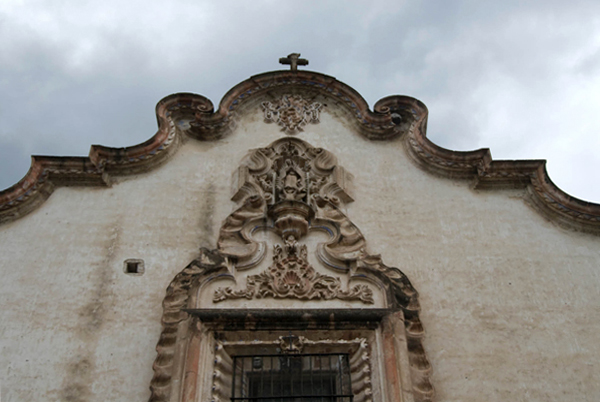
Coquillage
A representation of the forms of seashells and the like, as a decorative carving.
Example: Aranza, Michoacán, San Jerónimo, façade coquillage

Corbel
In masonry, a projection or one of a series of projections, each stepped progressively farther forward with height; anchored in a wall, story, column, or chimney; used to support an overhanging member above or, if continuous, to support overhanging courses; may support an ornament or similar appearance.
Example: Yecapixtla, Morelos, San Juan Bautista, sotocoro arch corbel

Cornice
Any molded projection which crowns or finishes the part to which it is affixed.
Example: Cuzamá, Yucatán, La Trinitaria, façade cornice
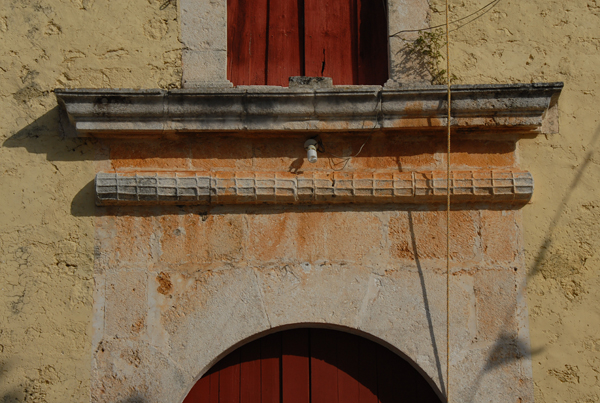
Coved vault
A vault composed of four quarter-cylindrical surfaces or coves, meeting in vertical diagonal places, the axial sections of the vault being arched, and the horizontal courses diminishing in length from spring to crown.
Example: Mérida, Yucatán, San Ildefonso, nave, coved vault
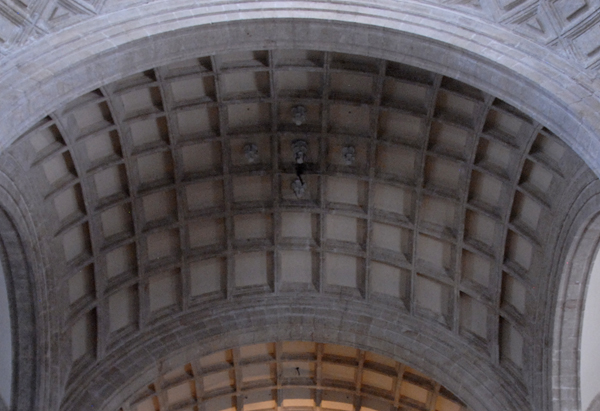
Crenel
An open space between the merlons of a battlement.
Example: Tepeji del Río, Hidalgo, San Francisco, atrial wall battlement with merlons & crenels
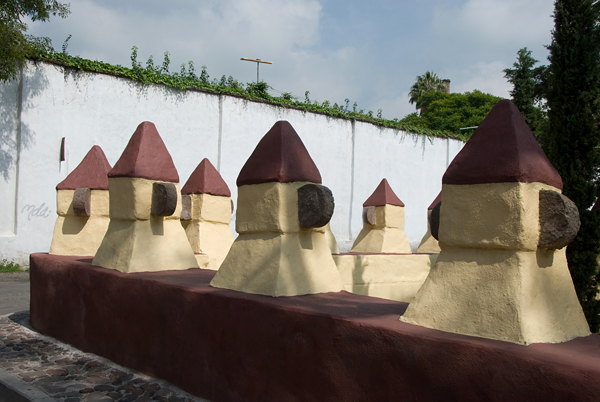
Crenellation
A battlement.
Example: Bokobá, Yucatán, La Aunción, apse crenellation
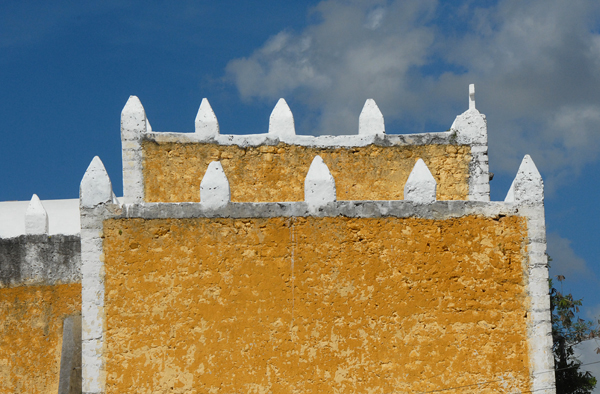
Creole
White born in New Spain.
(definition from Chevalier, François. Land and Society in Colonial Mexico: The Great Hacienda, translated by Alvin Eustis, edited, with foreword by Lesley Byrd Simpson, University of California Press, Berkeley and Los Angeles, 1970, p. 321)
Example: México, D.F., Castillo Chapultepec, Miguel Cabrera, closeup of his 1750 Portrait of Sor Juana Inés de la Cruz, Mexico's most famous Creole nun
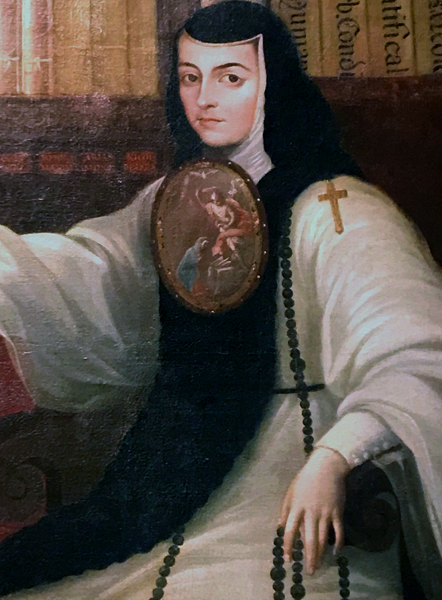
Crossing
In a church, the place where the nave and sanctuary cross the transept.
Example: Yuriria, Guanajuato, San Pablo, nave crossing
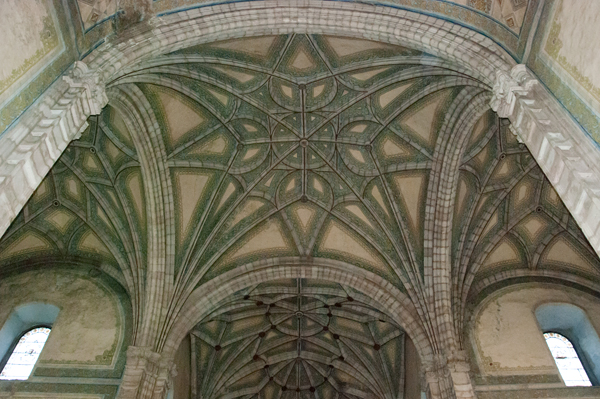
Cuauhxicalli
Aztec ceremonial vessel for holding the hearts of sacrificial victims.
(definition from Perry, Richard D. Blue Lakes & Silver Cities: The Colonial Arts and Architecture of West Mexico, Espadaña Press, Santa Barbara, California, 1997, p. 258)
Example: Acatitlán, México, Santa Cecilia, repurposed cuauhxicalli as baptismal font
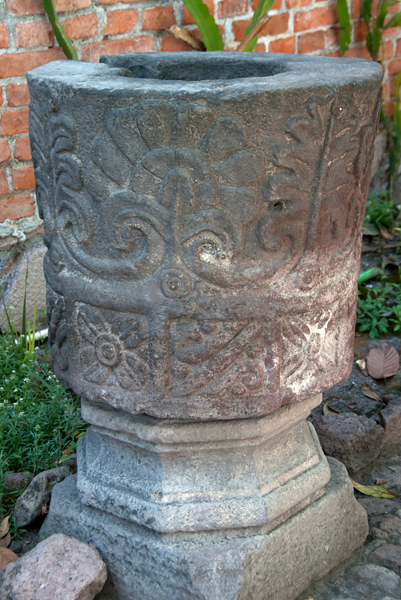
Cupola
A domical roof on a circular base, often set on the ridge of a roof.
Example: Juriquilla, Querétaro, hacienda, Capilla de Nuestro Señor de El Trabajo, cupola

Custodia
see Ostensory
Example: Guachicmontón, Jalisco, ex-Hacienda Labor de Rivera, capilla de San Nicolás de Tolentino, custodia

Dado
The lower part of an interior wall when specially decorated of faced; also the decoration adorning this part of a wall.
(definition from Webster’s Ninth New Collegiate Dictionary, Merriam-Webster Inc., Publishers, Springfield, Massachusetts, 1983, p. 322)
Example: Tehuantepec, Oaxaca, Santo Domingo, upper with cloister walk, dado mural
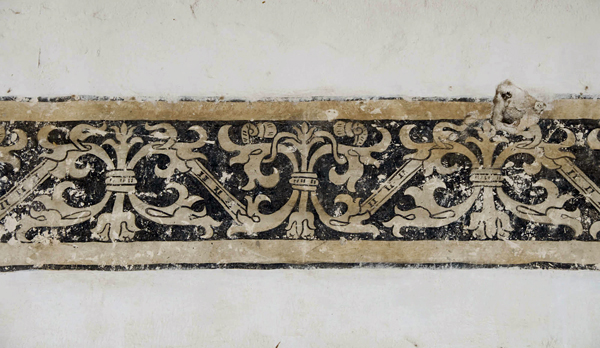
Demilune
In fortifications, a projecting outwork forming a salient angle.
Example: Campeche, Campeche, Puerta de Tierra, with bastion demilune
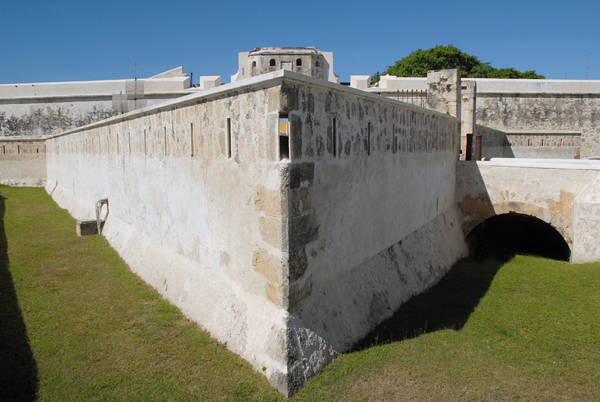
Diamondwork
Masonry construction in which pieces are set so as to form diamonds on the face of a wall.
Example: Teposcolula, Oaxaca, San Pedro y San Pablo, open chapel, pillar base diamondwork
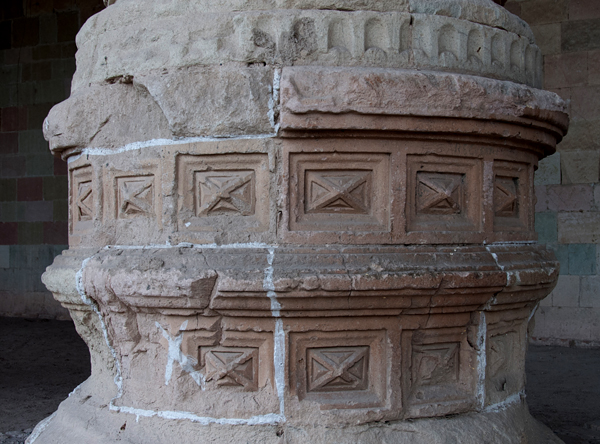
Diaper
An allover pattern with motifs placed in a repeated design, especially on a rectangular of diagonal grid.
Example: Zinacantepec, México, San Miguel Arcángel, prior's cell mural, diaper motif

Domical vault
see with Coved vault
Example: Querétaro, Querétaro, Santa Clara, with sanctuary, domical vault

Dominican
By name black friar, member of the with Order of Friars Preachers (O.P.), one of the four great mendicant orders of the Roman Catholic church, was founded by St. Dominic in 1215. Dominic, a priest of the Spanish diocese of Osma, accompanied his bishop on a preaching mission among the Albigensian heretics of southern France, where he founded a nunnery at Prouille in 1206, partly for his converts, which was served by a community of preachers. From this developed the conception of an institute of preachers to convert the Albigensians, which received provisional approval from Pope Innocent III in 1215. Dominic gave his followers a rule of life based on that of St. Augustine and made his first settlement at Toulouse; on Dec. 22, 1216, Pope Honorius III gave formal sanction. {…} (definition from The New Encyclopaedia Britannica, Chicago, London, New Delhi, Paris, Seoul, Sydney, Taipei, Tokyo, 2003, vol. IV, p. 166)
Example: Tlaquiltenango, Morelos, San Francisco, with convento with anteportería mural, Dominican founders
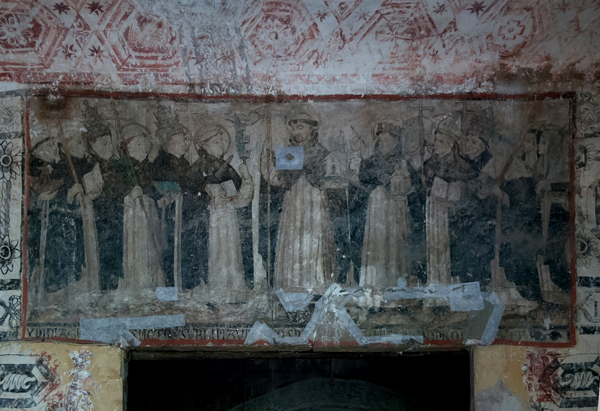
Embrasure
see Crenel
Example: Valladolid (Sisal), Yucatán, San Bernardino de Siena, roof with crenellation embrasure
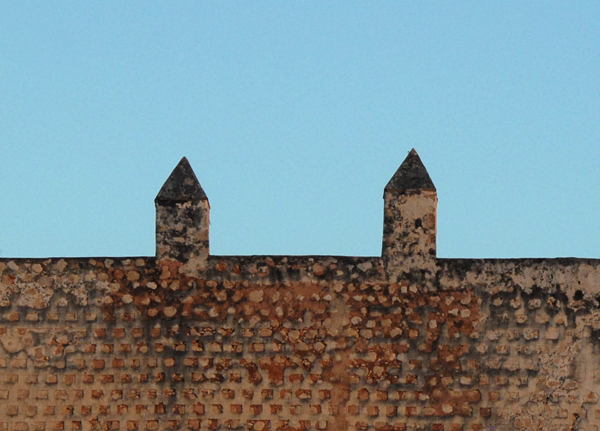
Encarnación
In New Spain, tinted finish to wooden sculpture to represent flesh.
(definition from Collis, John, and Jones, David M. Mexico Blue Guide, W.W. Norton & Co., New York, 1997, p. 106)
Example: Puebla, Puebla, Catedral de la Inmaculada Concepción, St. John Nepomuk (provenance, Cathedral's sala capitular), encarnación detail
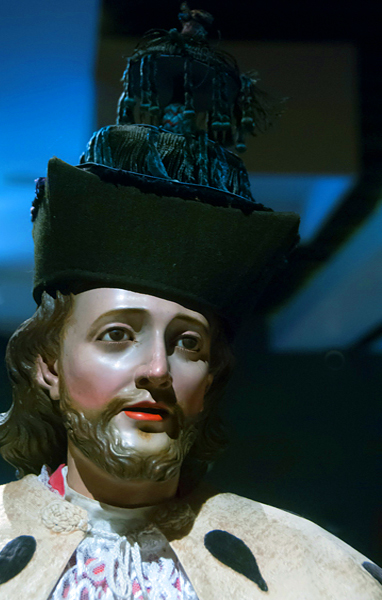
Encomienda
A kind of trust, whereby the crown granted to a conquistador the right to the tributes of a native community, in exchange for benefits, such as the support of a priest, indoctrination, and so on.
(definition from Chevalier, François. Land and Society in Colonial Mexico: The Great Hacienda, translated by Alvin Eustis, edited, with foreword by Lesley Byrd Simpson, University of California Press, Berkeley and Los Angeles, 1970, p. 322)
Ensamblador
An architect, with maestro de obras or other artisan skilled at carpentry and joinery whose job it was to direct the assembly of the individually fabricated components of altarpieces in their desired positions within a church with nave or with sanctuary (personal definition)
Entablature
In classical architecture, the elaborated beam member carried by the columns, horizontally divided into with architrave (below), with frieze, and with cornice (above). The proportions and detailing are different for each order and strictly prescribed.
Example: Araró, Michoacán, Nuestro Señor de Araró (Nuestra Señora del Refugio), façade, main portal entablature with reliefs of God the Father, SS Peter & Paul
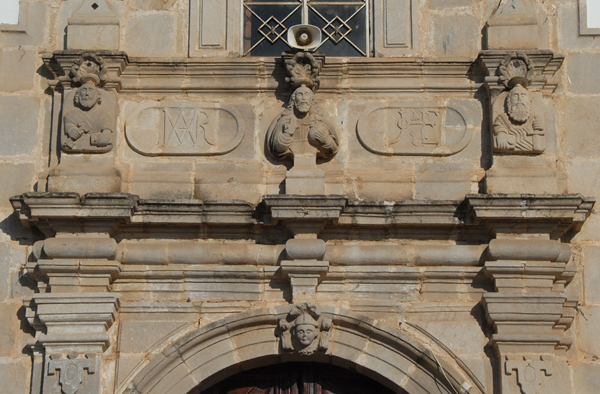
Entrecalle
Space between columns or with estípites.
(definition from Collis, John, and Jones, David M. Mexico Blue Guide, W.W. Norton & Co., New York, 1997, p. 106)
Example: Chihuahua, Chihuahua, Nuestra Señora de Regla y San Francisco de Asís, façade, lower tier with pilasters & entrecalle
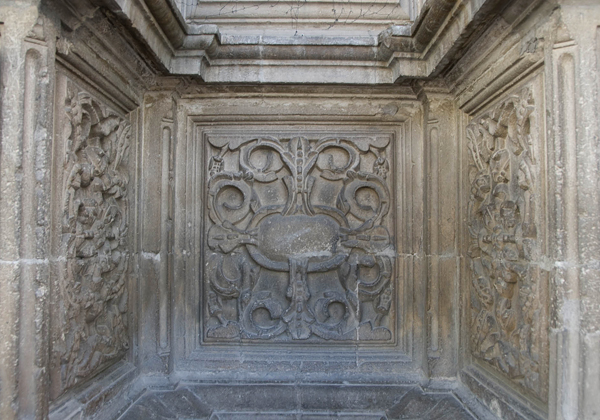
Escutcheon
A shield on which armorial bearings are depicted; may be of any form, but the usual shape is that of a square or lozenge.
Example: Chignautla, Puebla, San Mateo, façade, with gable escutcheon
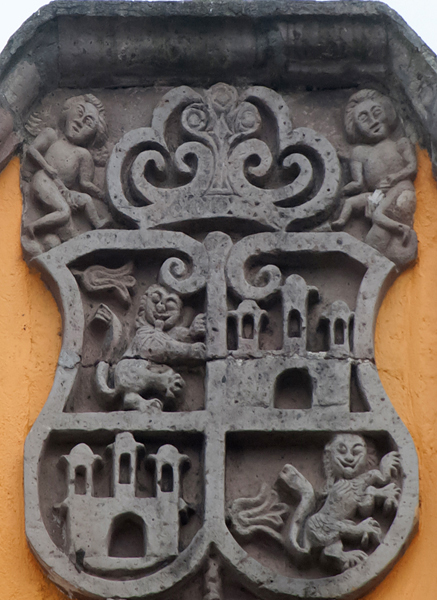
Espadaña
A small belfry; that is a section of a wall usually placed over a façade, with arched openings for holding bells.
(definition from: Baird, Joseph Armstrong. The Churches of Mexico 1530-1810, University of California Press, Berkeley and Los Angeles, 1962, p. 64)
Example: Yotholín, Yucatán, San Buenaventura, façade espadaña
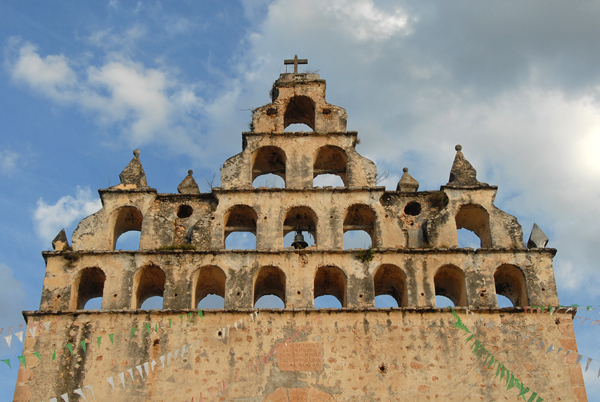
Esquila
A bell wheel used during Mass. It is rotated to make the bells chime when the priest covers the holy wine and bread with his hands and when he raises the body and blood of Christ, at which times his congregation is meant to kneel. The apparatus was much more widely used before the Second Vatican Council held in October of 1962 where it used to be placed in the choir loft rather than the sanctuary from where the music and singing accompanying the Mass was then orchestrated. Prior to Vatican II, the priest gave Mass in Latin, often in a low voice and, moreover, facing East rather than West, towards the birthland of Christ. Facing his backside, the congregants might fail to determine the appropriate times to kneel, for which reason the esquila was instrumental. (personal definition)
Example: Azcapotzalco, D.F., San Felipe y Santiago, Capilla del Rosario, esquila
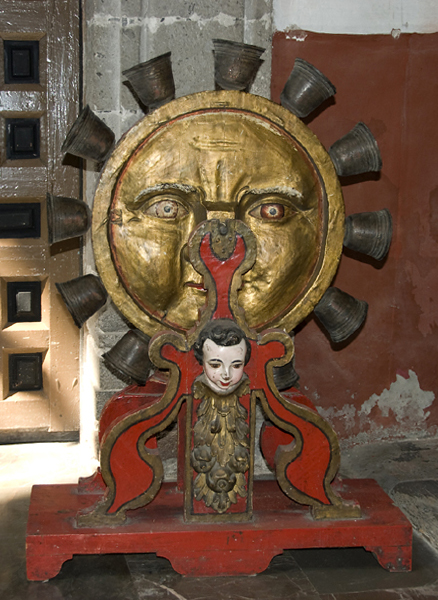
Estancia
Grant of land for running sheep or cattle.
(definition from Chevalier, François. Land and Society in Colonial Mexico: The Great Hacienda, translated by Alvin Eustis, edited, with foreword by Lesley Byrd Simpson, University of California Press, Berkeley and Los Angeles, 1970, p. 322)
Estipite
In Spanish and Latin-American Mannerist architecture and derivatives, a shaft of square cross section, tapering downward, frequently combined with other unusual elements, the whole used like an order.
Example: San Luis Potosí, San Luis Potosí, San Francisco, Capilla de Aranzazu, with arcade with pillars & estípites
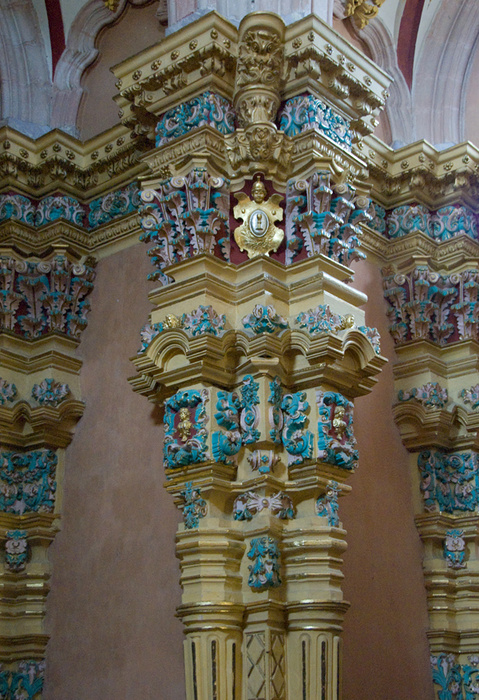
Estípite Baroque
see Churrigueresque
Example: Acuamanalá, Tlaxcala, San Antonio, Estípite Baroque façade
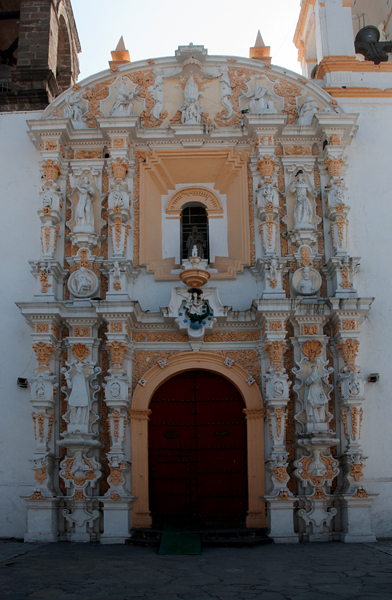
Estofado
Figural and ornamental sculptural technique, involving the coating of carved wood with layers of fine gesso (q.v.) as a foundation for gilding and with polychromy. A special variant, relating to the faces and hands of figures, is called with encarnación.
(definition from: Baird, Joseph Armstrong. The Churches of Mexico 1530-1810, University of California Press, Berkeley and Los Angeles, 1962, p. 64)
Example: San Angel, D.F., San Angelo Martír, estofado sculpture of St. Michael Archangel
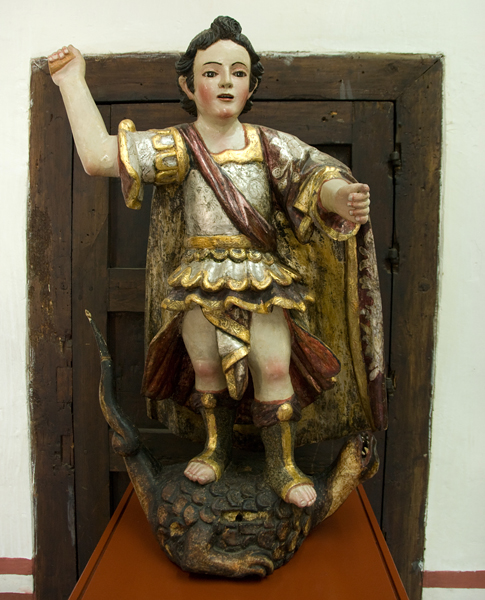
Extrados
The exterior curve or boundary of the visible face of the arch.
Example: Zacatecas, Zacatecas, Catedral de Nuestra Señora de la Asunción, West façade, main portal, archivolt extrados
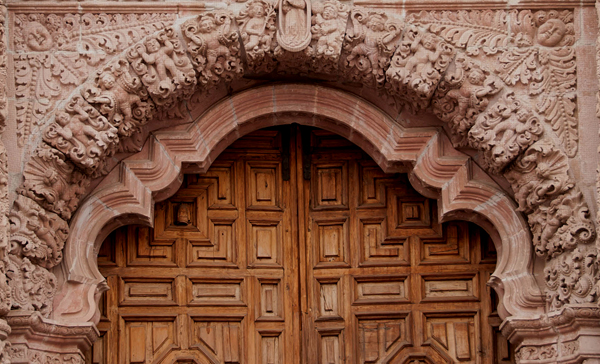
Fanlight
A semicircular window over the opening of a door, with radiating bars in the form of an open fan.
Example: Tlaquepaque, Jalisco, Hospital de Nuestra Señora del Refugio, ambulatory fanlight

Filigree
Ornamental openwork of delicate or intricate design.
(definition from Webster’s New Collegiate Dictionary, C. & G. Merriam Company, Springfield, Massachusetts, 1980, p. 462)
Example: Puebla, Puebla, La Santísima Trinidad, choir loft, grille filigree

Finial
An ornament which terminates the point of a spire, pinnacle, etc.
Example: México, D.F., Casa de los Azulejos, roof finial
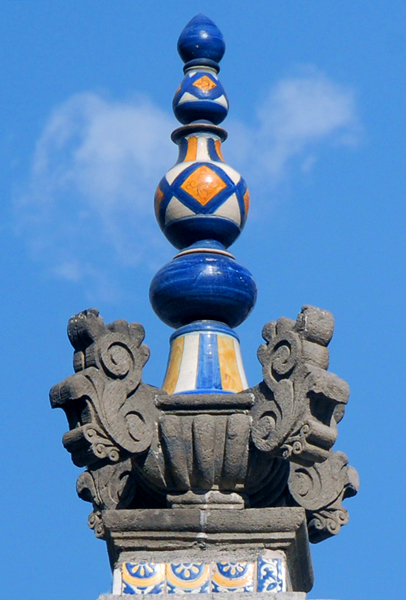
Flat arch
An arch with a horizontal, or nearly horizontal intrados; has little or no convexity.
Example: Puebla, Puebla, Casa del que mató el aminal, main portal, flat arch
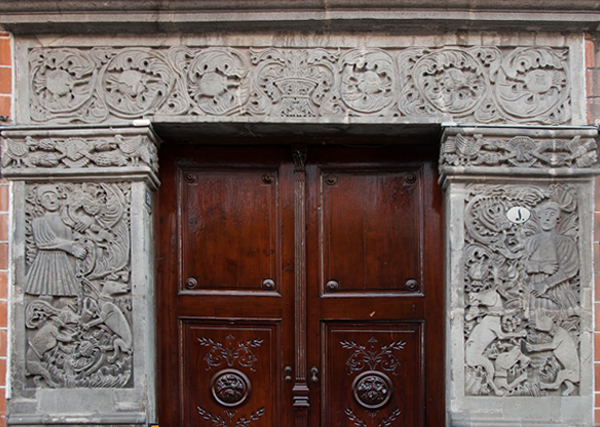
Fluting
Vertical channeling (usually concave) on a columnar or pilaster shaft.
(definition from: Baird, Joseph Armstrong. The Churches of Mexico 1530-1810, University of California Press, Berkeley and Los Angeles, 1962, p. 64)
Example: Ocotlán de Morelos, Oaxaca, Santo Domingo, façade gable, fluted column
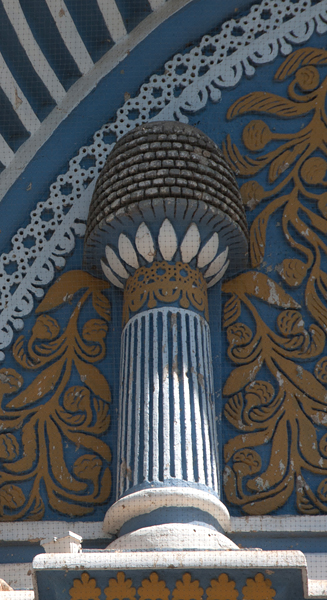
Flying buttress
A characteristic feature of Gothic construction, in which the lateral thrusts of a roof or vault are taken up by a bar of masonry, usually sloping, carried on an arch, and a solid pier or buttress sufficient to receive the thrust.
Example: Libres, Puebla, La Asunción, North bell-tower & flying buttress
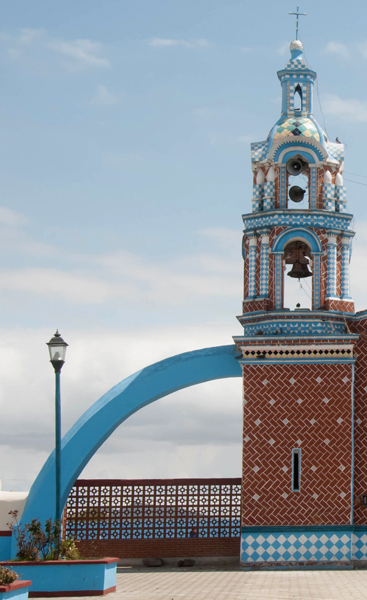
Franciscan
Any member of a Christian religious order founded in the early 13th century by St. Francis of Assisi. The members of the order strive to cultivate the ideals of the order’s founder. {…} It was probably in 1207 that Francis felt the call to a life of preaching, penance, and total poverty. He was soon joined by his first followers, to whom he gave a short and simple rule of life. In 1209 he and 11 of his followers journeyed to Rome, where Francis received approval of his rule from Pope Innocent III. Under this rule, Franciscan friars could own no possessions of any kind, either individually or communally (i.e., as the property of the order as a whole). The friars wandered and preached among the people, helping the poor and the sick. They supported themselves by working and by begging for food, but they were forbidden to accept money either as payment for work or as alms. The Franciscans worked at first in Umbria and then in the rest of Italy and abroad. {…}
(definition from The New Encyclopaedia Britannica, Chicago, London, New Delhi, Paris, Seoul, Sydney, Taipei, Tokyo, 2003, vol. IV, p. 930)
Example: Mani, Yucatán, San Miguel Arcángel, nave (right) San Antonio de Padua altar; intercolumniation (left), St. Anthony Preaching to the Franciscans

Fray
Medieval fraternal greeting used by Spanish friars as a form of address.
(definition from Perry, Richard. Mexico’s Fortress Monasteries, Espadaña Press, Santa Barbara, California, 1992, p. 204)
Example: Tlalmanalco, México, San Luis Obispo, cloister walk mural,Fray Martín de Valencia

Fresco
A mural painted into fresh lime plaster; in such work water-based colors unite with the base; retouching is done in secco (dry).
Example: Puebla, Puebla, Casa del Deán, Sala de las Sibilas, Erythaea fresco mural (detail)
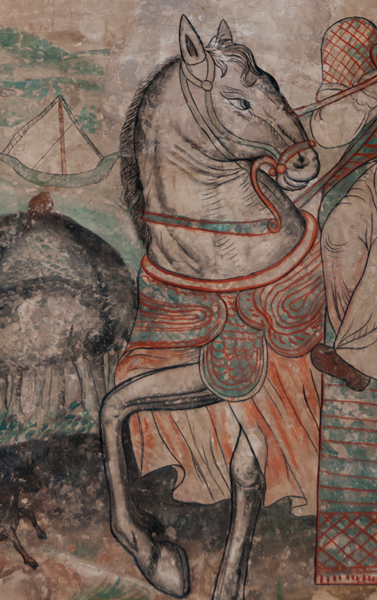
Fretwork
Ornamental openwork or interlaced work in relief, especially when elaborate and minute in its parts and in patterns of contrasting light and dark.
Example: Guila, Oaxaca, San Pablo, sacristy portal fretwork

Friary
A convento or mission where friars dwell.
(personal definition
Example: Fremont, California, San José mission

Frieze
A broad horizontal band of sculpted or painted decoration, especially on a wall near the ceiling.
(definition from Online Oxford Languages)
Example: Tlahuelilpa, Hidalgo, San Francisco, nave mural, frieze with medallion

Frontón
A small pediment placed over a door, niche, porch, etc.
Example: Zirosto, Michoacán, Santa Ana, North portal frontón

Gable
The vertical triangular portion of the end of a building having a double-sloping roof, from the level of the Gothic or eaves to the ridge of the roof.
Example: Chignautla, Puebla, San Mateo, façade gable

Gallina ciega
Carved out from the thick walls of colonial churches in the Yucatán, these passageways include windows and small balconies and represent a regional specialty {…}. In fact, they are a creative response to latent architectural issues, a highly original solution to the problems which in Medieval Europe had been solved by the clerestory and triforium. It is tempting for some to associate these passageways with the chemin-de-ronde of medieval fortresses. Within the tradition of ecclesiastic architecture, the effect of the Gothic clerestory and triforium may be discerned through these unique gallina ciegas, as their purposes were clearly one and the same.
(definition Online from Buenfil, Valerio. La Gallina Ciega, Una invención en Motul, La Voz de Motul, Memoria e Identidad personal translation)
Example: Mérida, Yucatán, San Ildefonso, gallina ciega

Gargoyle
A waterspout projecting from the roof gutter of a building, often carved grotesquely.
Example: Irapuato, Guanajuato, La Misericordia, exterior nave gargoyle

Garita
see Sentry Box
Example: Campeche, Campeche, Fuerte de San José El Alto, garita

Glory
The luminous halo encircling the head of a sacred person and the radiance or luminous emanation encompassing the whole.
Example: Atzitzimititlán, Tlaxcala, Nuestra Señora de Belén, cupola glory, Our Lady of Guadalupe

Glyph
A sculpted pictograph.
Example: Cuilápam de Guerrero, Oaxaca, Santiago Matamoros, capilla abierta, glyph wall relief

Gothic
The architectural style of the High Middle Ages in Western Europe, which emerged from Romanesque and Byzantine forms in France during the later 12th century. Its great works are cathedrals, characterized by the pointed arch, the ribbed vault, the development of the exterior flying buttress, and the gradual reduction of the walls to a system of richly decorated fenestration. Gothic architecture lasted until the 16th century, when it was succeeded by the classical forms of the Renaissance.
Example: Zempoala, Hidalgo, Todos Santos, nave & Gothic vaulted ceiling
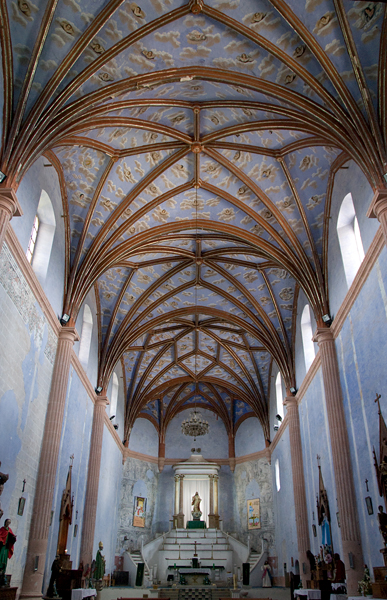
Grisaille
A system of painting in grey tints of various shades; used either for decoration or to represent objects, as in relief.
Example: Culhuacán, D.F., San Juan Evangelista, convento anteportería, grisaille mural, St. Augustine protecting his Order
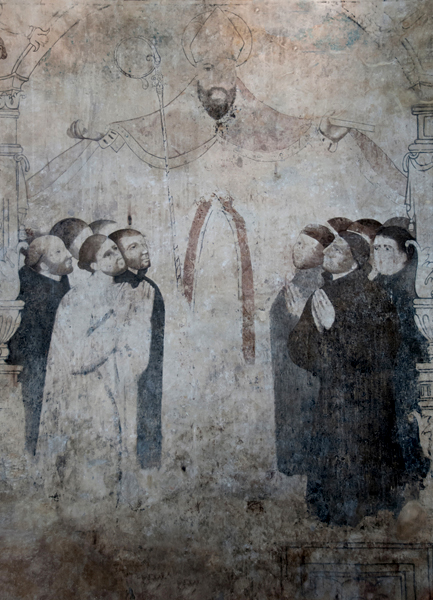
Groin
The ridge, edge, or curved line formed by the intersection of the surfaces of two intersecting vaults.
Example: Tzintzuntzan, Michoacán, San Francisco, convento cloister, vault groins
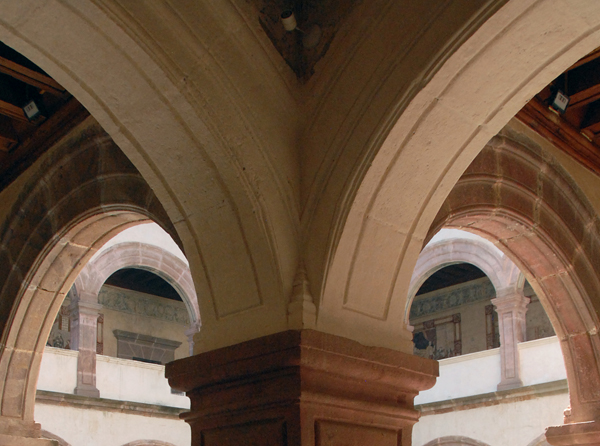
Groin Vault
A compound vault in which barrel vaults intersect, forming arrises called groins.
Example: Malinalco, México, El Divino Señor, lower cloister walk, testera groin vault

Groining
Any system of vaulting implying the intersection, at any angle, of simple vaults.
Example: Cholula, Puebla, San Gabriel, nave groining

Grotesque
Sculptured or painted ornament involving fanciful distortions of human and animal forms, sometimes combined with plant motifs, especially a variety of arabesque which has no counterpart in nature.
Example: Metztitlán, Hidalgo, Los Santos Reyes, nave mural, dado grotesques
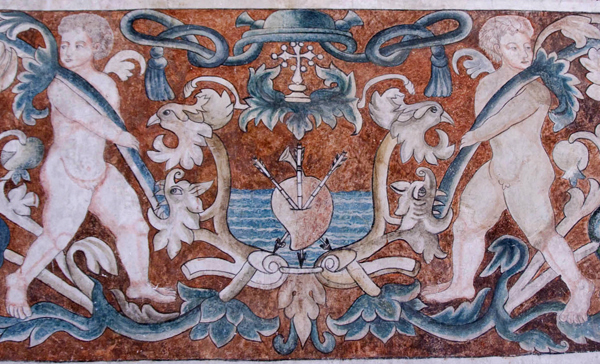
Guatápera
At times written Huatápera and meaning “House of the Virgins” in the Purépecha language of the Tarascans, the word refers to the pueblo-hospital compounds established in 16th century West Mexico by the Franciscans and Augustinians to lodge, care and educate the indigenous. While the idiom guatápera comprises the entire complex (as at Uruapan and Santa Fe de la Laguna, Michoacán), its present-day usage is at times conflated with hospital chapel within the Guatápera, which in Purépecha is known as a Yurishio. Better preserved examples of the Guatápera survive at Uruapan, Zacán, Angahuan, Cheran, Chilchota, Santa Clara del Cobre, Jarácuaro, Ocumicho, and Santa Cruz el Grande, (all Michoacán except the last cited which is located in Jalisco).” (personal definition)
Example: Zacán, Michoacán, guatápera
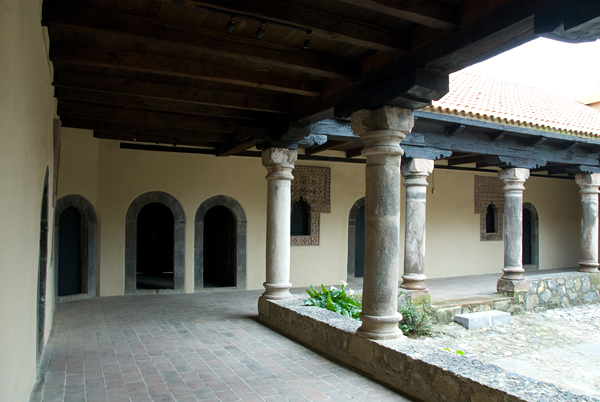
Hacienda
In New Spain, a large rural estate.
(definition from Chevalier, François. Land and Society in Colonial Mexico: The Great Hacienda, translated by Alvin Eustis, edited, with foreword by Lesley Byrd Simpson, University of California Press, Berkeley and Los Angeles, 1970, p. 322)
Example: Bledos, San Luis Potosí, hacienda
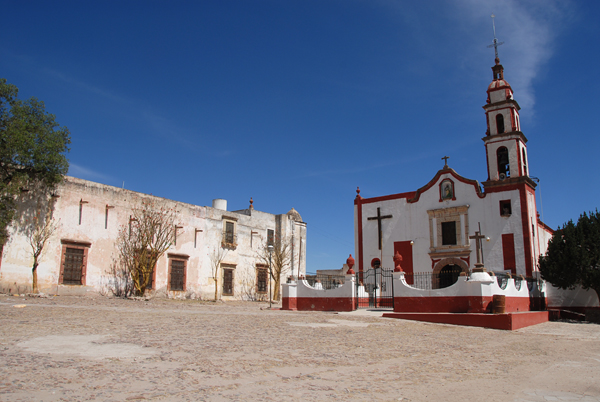
Harneruelo
A horizontal panel which forms the central portion in carved wooden ceilings.
(definition from Online Real Academia Diccionario de la lengua española, personal translation)
Example: Angahuan, Michoacán, Santiago Apóstol, sanctuary, alfarje ceiling with harneruelo

Helicoidal
Forming or arranged in a spiral.
(definition from Webster’s New Collegiate Dictionary, C. & G. Merriam Company, Springfield, Massachusetts, 1980, p. 527)
Example: San Miguel de Allende, Guanajuato, San Felipe Neri, Santa Casa de Loreto, entrance portal, helicoidal columns
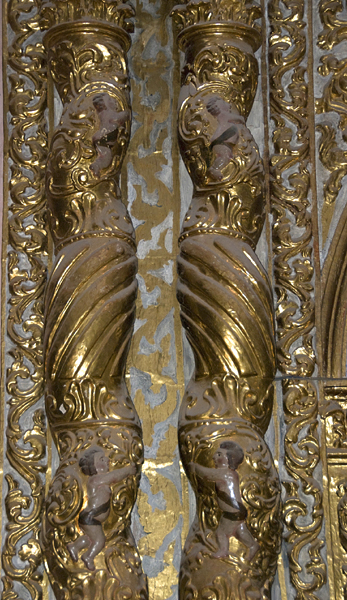
Hippocamp
Sea-horse, with the upper body of a horse and lower of a fish-like creature, often used in Classical decorations.
(definition from Online A Dictionary of Architecture and Landscape Architecture, Oxford University Press)
Example: Yecapixtla, Morelos, San Juan Bautista, façade, architrave relief, putto riding hippocamp
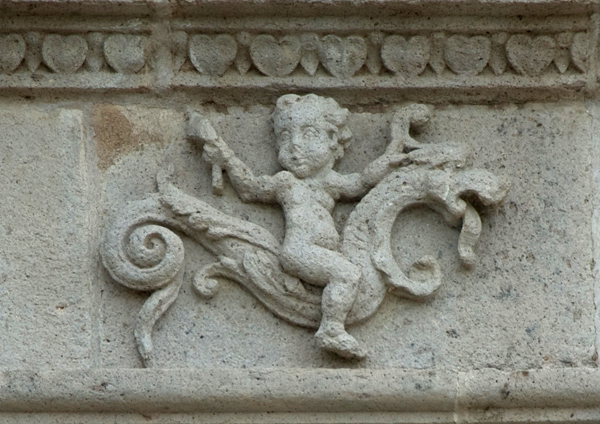
Hospital Chapel
see Yurishio
Example: Jarácuaro, Michoacán, Hospital Chapel
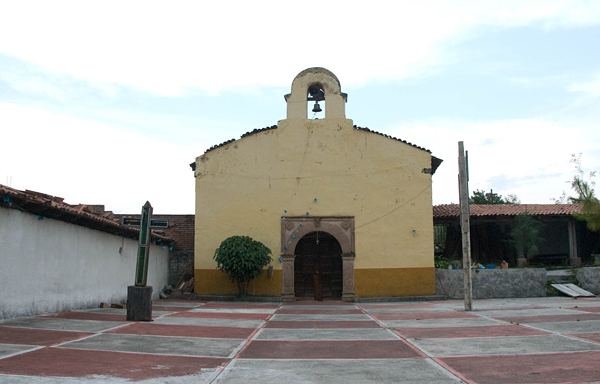
Hospitalito
see Yurishio
Example: Comanchuén, Michoacán, Hospitalito
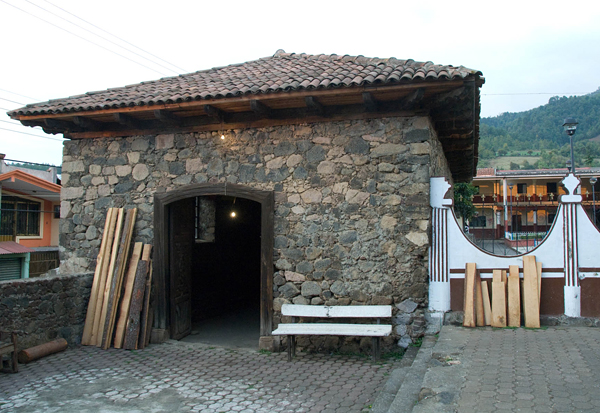
Huatápera
see Huatápera
Example: Uruapan, Michoacán, Huatápera

Huerta
Cultivated garden or orchard.
(definition from Mexico's Fortress Monasteries by Richard Perry, Espadaña Press, Santa Barbara Press, California, 1992, p. 204)
Example: Actopan, Hidalgo, San Nicolás de Tolentino, convento huerta

Humilladero
Wayside shrine containing Crucifix.
(definition from Collis, John, and Jones, David M. Mexico Blue Guide, W.W. Norton & Co., New York, 1997, p. 106)
Example: Pátzcuaro, Michoacán, El Humilladero, façade portal
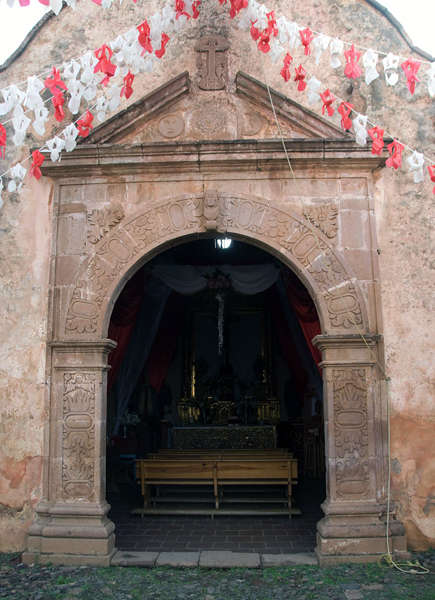
Impost
A masonry unit or course, often distinctively profiled, which receives and distributes the thrust at each end of an arch.
Example: Acatitlán, México, Santa Cecilia, façade, main portal, arch impost

Indochristian art
see Tequítqui
A type of Latin American art that combines European colonial influences with Indigenous artistic styles and traditions.
(definition from Online The Free Encyclopedia Wikipedia)
Example: Axotla, D.F., San Sebastián, façade portal, left door pilaster, Indochristian art relief
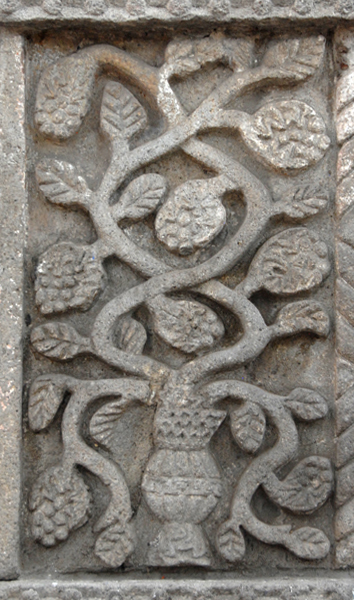
Infilling
see Webbing
Example: Cuitzeo, Michoacán, Santa María Magdalena, lower cloister walk, vault infilling
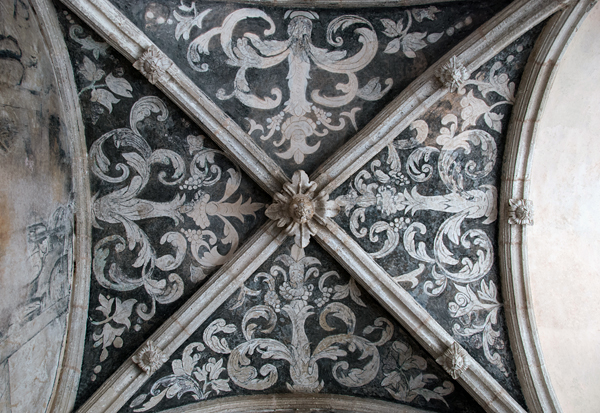
Intercolumniation
The clear space between two adjacent columns, usually measured at the lower parts of the shafts.
Example: Ahuahuaxtepec, Tlaxcala, San Andrés, façade portal, intercolumniation (right)

Interestípite
Space (often highly ornamented) between estípites.
(definition from Collis, John, and Jones, David M. Mexico Blue Guide, W.W. Norton & Co., New York, 1997, p. 107)
Example: La Valenciana, Guanajuato, San Cayetano, façade, lower story, interestípite (left)
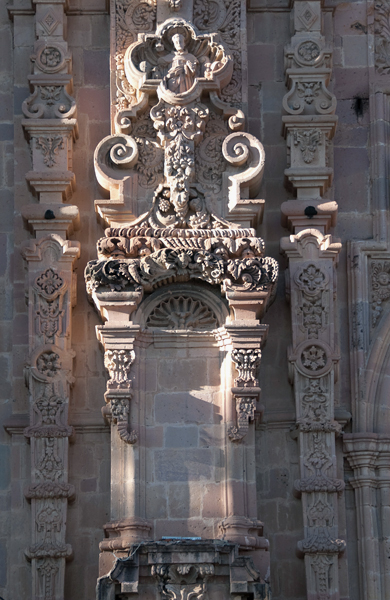
Intrados
The inner curve or face of an arch or vault forming the concave underside.
Example: Zacatecas, Zacatecas, Nuestra Señora de la Asunción, West façade, main portal, archivolt intrados
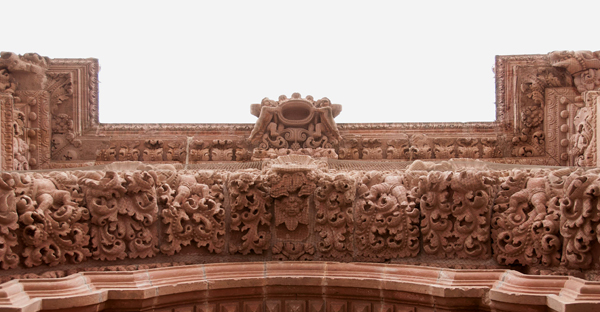
Instruments of the Passion
see Passion Symbols
Example: Coixtlahuaca, Oaxaca, San Juan Bautista, North doorway reliefs (left), Instruments of the Passion

Isabelline Gothic
Late 15th century Spanish architectural manner in which Mudéjar, Flemish, Burgundian, and other exotic motifs are used to elaborate Gothic elements.
(definition from Collis, John, and Jones, David M. Mexico Blue Guide, W.W. Norton & Co., New York, 1997, p. 107)
Example: San Juan Evangelista, Jalisco, San Juan Evangelista, Isabelline Gothic lateral portal
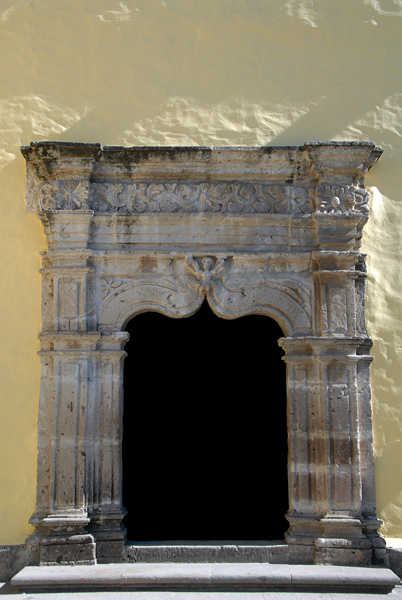
Isocephalic
In bas-relief, having the heads nearly on a horizontal line; especially said of the heads of human figures in a frieze or band.
Example: Valladolid, Yucatán, San Bernardino de Sena, sanctuary niche, mural detail (left), St. Francis & isocephalic Christian disciples

Jamb
A vertical member at each side of a doorframe, window frame, or door lining.
Example: Cata, Guanajuato, Santo Señor de Villaseca, façade, main portal, right door jamb
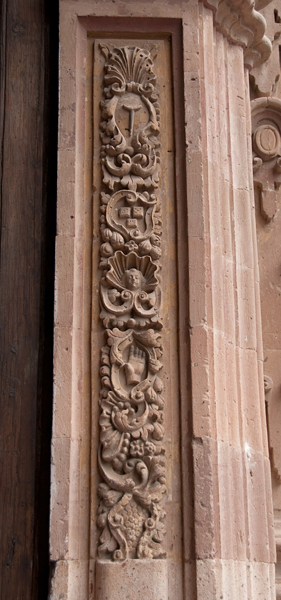
Jesuit
Member of the Society of Jesus, a Roman Catholic order of religious men, founded by St. Ignatius of Loyola, noted for its educational, missionary, and charitable works, once regarded by many as the principal agent of the Counter-Reformation and later a leading force in modernizing the church. The Jesuits have always been a controversial group regarded by some as a society to be feared and condemned and by others as the most laudable and esteemed religious order in the Catholic Church. {…}
(definition from The New Encyclopedia Britannica, Chicago, London, New Delhi, Paris, Seoul, Sydney, Taipei, Tokyo, 2003, vol. VI, p. 541)
Example: México, D.F., Colegio de Las Vizcaínas, chapel high altar, central sculpture detail, St. Ignatius, Jesuit founder, upholding his precept

Joachimite
{…} a millenarian group, arose from the Franciscans in the thirteenth century. They based their ideas on the prior works of Joachim of Fiore (circa 1135-1202), though rejecting the Church of their day more strongly than he had. {…} Joachim’s works divide history into three ages. The first age was that of the Father. The age of the Father was the age of the Old Covenant. The second age was of the Son and therefore the world of Christianity. The third and final age would be that of the Holy Spirit. In this new age an “Eternal Gospel” would be revealed, fulfilling and replacing the organized Church. After that, society would be realigned on an egalitarian and utopian, monastic basis.
(definition from Online The Free Encyclopedia Wikipedia)
Keystone
In masonry, the central, often embellished voussoir, of an arch. Until the keystone is in place, no true arch action is incurred.
Example: Hermosillo, Sonora, San José de Batuc, façade, main portal, archivolt keystone, Trinity
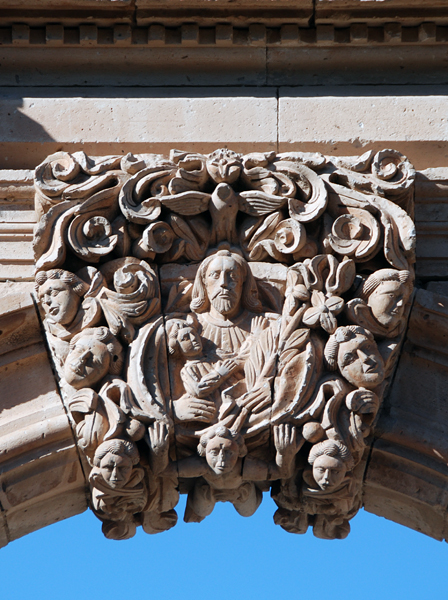
Kiva
A Pueblo Indian ceremonial structure that is usually round and partly underground.
(definition from Webster’s New Collegiate Dictionary, C. & G. Merriam Company, Springfield, Massachusetts, 1980, p. 663)
Example: Gran Quivira, New Mexico, San Buenaventura, kiva
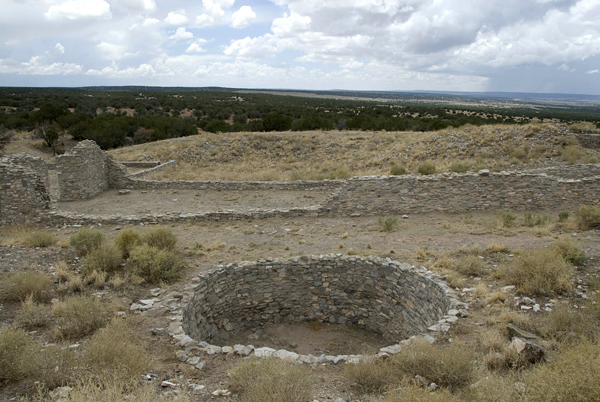
Knotwork
A carved ornamental arrangement of cord-like figures knotted together as in some kind of fringe, used to decorate voussoirs, moldings, etc.
Example: Texcoco, México, La Concepción, façade portal, pilaster knotwork (left)

Lambrequin
Originally a scalloped or cut-out cloth ornament, used often in strip form under a canopy or a baldachin. Since many of the pendent motifs, especially in wood or stone, of the estípite era were derived from such cloth (or paper) sources, the term is used by some writers to mean that motif, although in its original use it implied a row of such motifs. (definition from: Baird, Joseph Armstrong. The Churches of Mexico 1530-1810, University of California Press, Berkeley and Los Angeles, 1962, p. 65)
Example: Morelia, Michoacán, Palacio Justicia, rear entrance portal, lambrequin motif
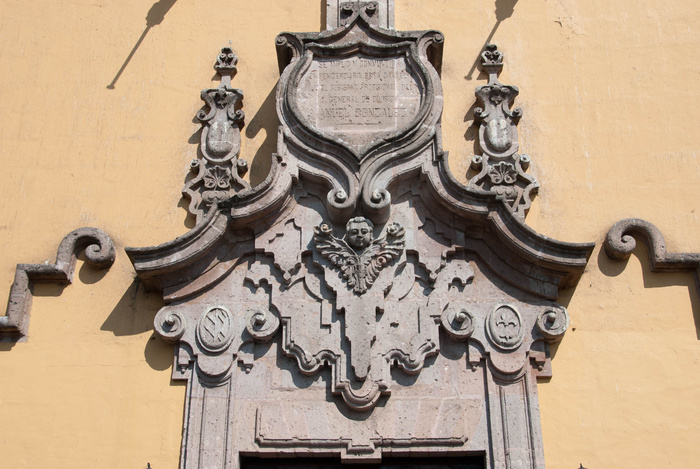
Lantern
A windowed superstructure crossing a roof or dome.
Example: Huamantla, Tlaxcala, San Luis, dome lantern

Lavabo
In monasteries of the Middle Ages, a large stone basin from which the water flowed through a number of small orifices around the edge, for the convenient performance of ablutions before religious exercises or meals.
Example: San Luis Potosí, San Luis Potosí, San Angustín, sacristy lavabo
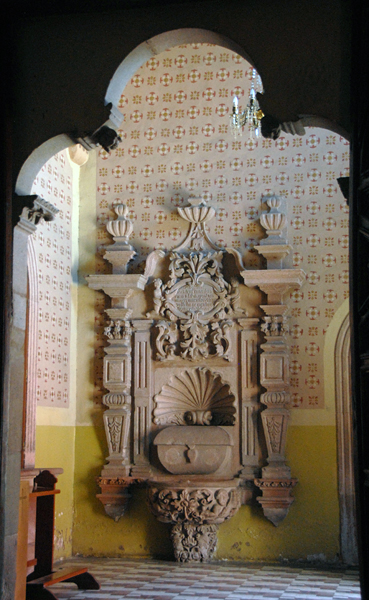
Lectern
In a church or lecture hall, a stand with a slanting top to hold a book, speech, or music at the proper height for reading.
Example: San Borja, Baja California, Misión San Francisco de Borja Adac, chancel, stone lectern
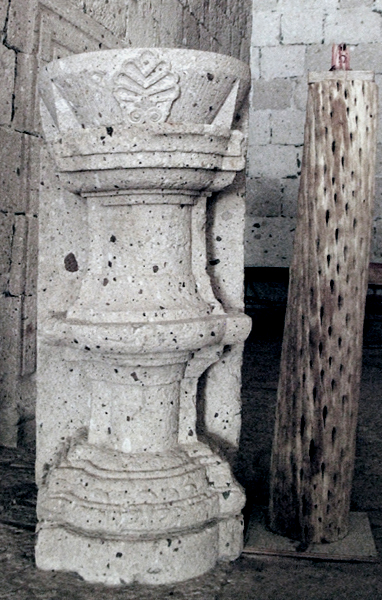
Lintel
A horizontal structure member (such as a beam) over an opening which carries the weight of the wall above it; often of stone or wood.
Example: Gran Quivira, New Mexico, San Buenaventura ruins, portal lintel
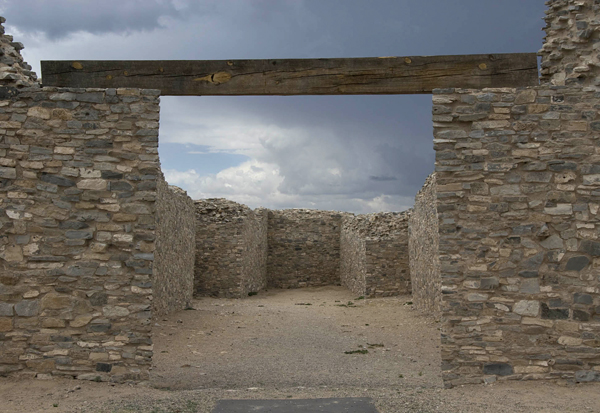
Log Vault
A type of vault consisting of large stone arches systematically traversed by wooden logs and interlayered with stucco. By the mid-17th century this sort of vault was common in the Yucatán peninsula where the admixture of an indigenous limestone (known in the Maya language as “sahkab”) and vegetable resins were employed in the infilling process. While conceptually similar to a barrel vault, the more cost-effective log vault resulted in the division of the Franciscan ceiling into interspersed segments of stone arches and wood beams, often yielding original if not elementary architectural compositions.
(personal definition)
Example: Santa Rita Becanchén, Campeche, San José, nave with log vault
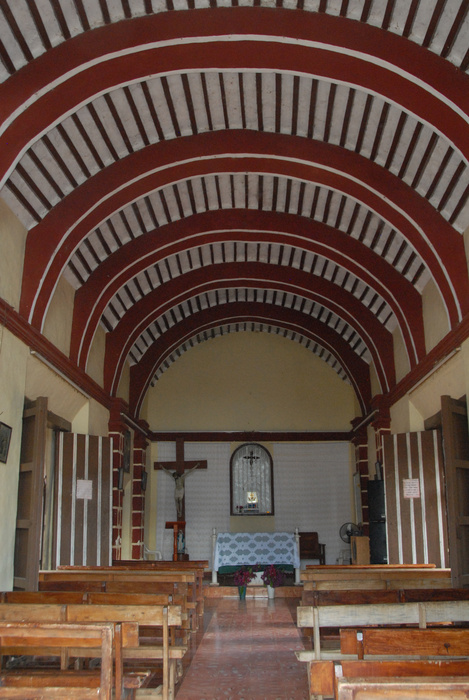
Loggia
An extended arcade or colonnaded structure, open on one or both sides, sometimes with an upper story; an arcaded or colonnaded porch or gallery attached to a larger structure.
Example: San Pedro Tlaquilpan, Hidalgo, San Pedro Apóstol, patio loggia
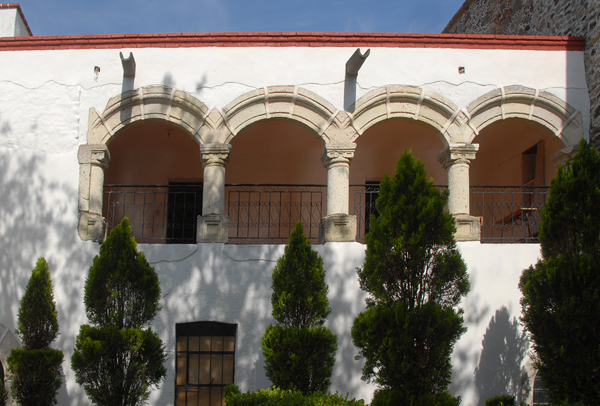
Lunette
A crescent shape or semicircular area on a wall or vaulted ceiling, framed by an arch or vault.
Example: Etla, Oaxaca, San Pedro, lower cloister ambulatoryambulatory, testera lunette
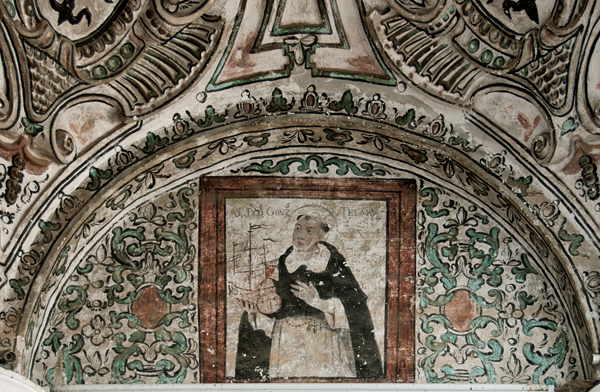
Maestro de obras
see Maestro Mayor
Maestro mayor
A guild master, a position attained after a long training period as apprentice and journeyman. A maestro mayor was responsible for a monumental building venture such as a cathedral, or for a category of structures, such as the public works of Mexico City.
(definition from Schuetz, Mardith K. Architectural Practice in Mexico City: A Manual for Journeyman Architects of the Eighteenth Century, The University of Arizona Press, Tucson, 1987, p. 127)
Mannerist
In the late 16th and 17th century New Spain, the final phase of the Renaissance style. In its first stage, purist and classicizing, the strict application of Renaissance ideals in architecture and art; in its second, involving a play with accepted rules, a sort of pre-Baroque, where coldness gives way to lively decoration.
(definition from Collis, John, and Jones, David M. Mexico Blue Guide, W.W. Norton & Co., New York, 1997, p. 107)
Example: Chapultenango, Chiapas, La Asunción, lateral Mannerist portal
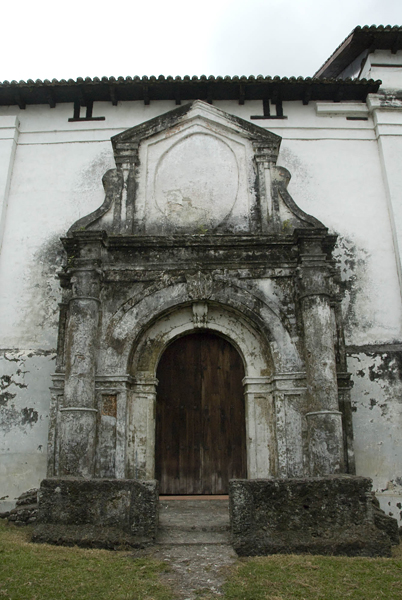
Manueline
Late Gothic style of Portugal, which flourished during the reign of Manuel I (1469-1521), tinged with exotic influences from Mudéjar, African, and perhaps Indian art.
(definition from Collis, John, and Jones, David M. Mexico Blue Guide, W.W. Norton & Co., New York, 1997, p. 107)
Example: Huejotzingo, Puebla, San Miguel Arcángel, porciúncula door archivolt
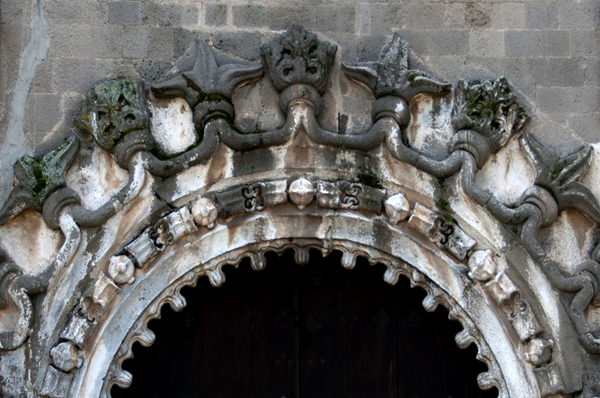
Marquetry
Inlaid pieces of a material, such as wood or ivory, fitted together and glued to a common background.
Example: Puebla, Puebla, Museo de Arte Barroco, Desk with Drawers & Shelves, marquetry closeup
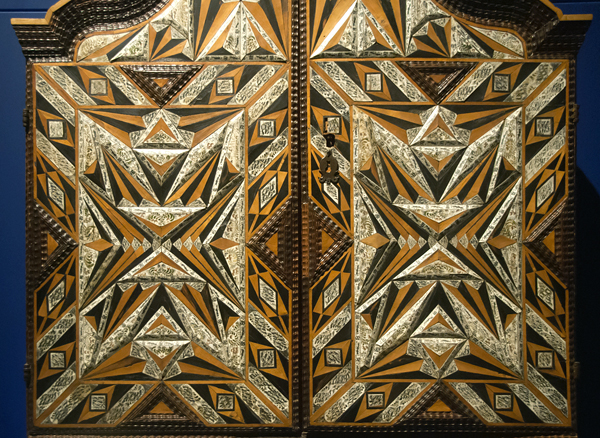
Mercedarian
Also called NOLASCAN, member of ORDER OF OUR LADY OF MERCY, also called KNIGHTS OF SAINT EULALIA, religious order founded by St. Peter Nolasco in Spain in 1218, for the purpose of ransoming Christian captives from the Moors. It was originally a military order. St. Raymond of Penafort, Nolasco’s confessor and the author of the order’s rule, based the rule on that of St. Augustine. In addition to the usually three religious vows of poverty, chastity, and obedience, the Mercedarians took a fourth vow, to offer themselves as hostages for Christian prisoners in danger of losing their faith. {…}
(definition from The New Encyclopaedia Britannica, Chicago, London, New Delhi, Paris, Seoul, Sydney, Taipei, Tokyo, 2003, vol. VIII, p. 27)
Example: Puebla, Puebla, La Merced, façade, central relief of Our Lady of Ransom with SS Raymond Raimundo de Penafort and Mercedarian Peter Nolasco
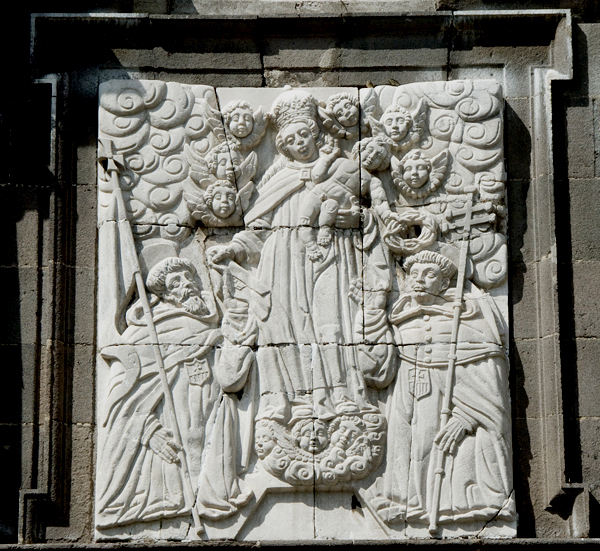
Merlon
In a {…} parapet one of the solid alternates between the embrasures.
Example: Abasolo, Chiapas, San Martín, façade, espadaña merlon

Mestizo
Offspring of Spanish and Indian parents.
(definition from Chevalier, François. Land and Society in Colonial Mexico: The Great Hacienda, translated by Alvin Eustis, edited, with foreword by Lesley Byrd Simpson, University of California Press, Berkeley and Los Angeles, 1970, p. 322)
Example: México, D.F., Castillo Chapultepec, Pinturas de casta {serie}, De español e india, mestizo
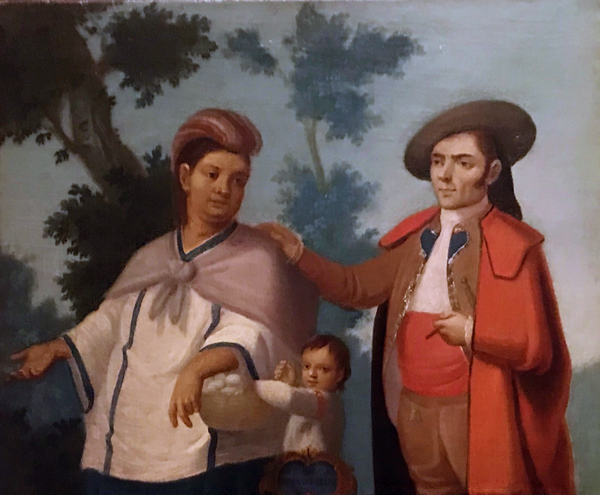
Mixtilinear arch
In Moorish and Spanish architecture, an arch composed of various geometric shapes.
Example: San Miguel Huautla, Oaxaca, San Miguel, façade portal closeup, mixtilinear arch
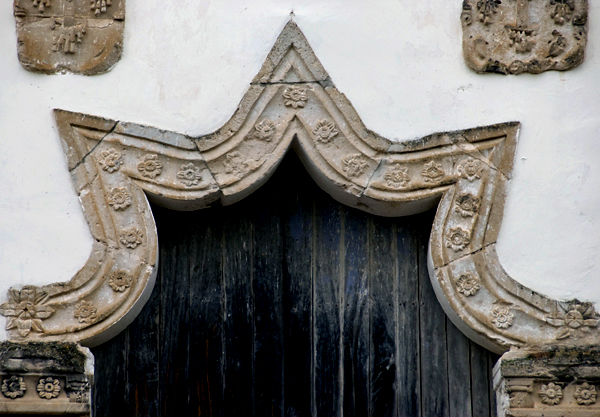
Monstrance
see Ostensory
Example: Coyoacán, D.F., San Juan Bautista, Capilla del Rosario, retablo detail, monstrance
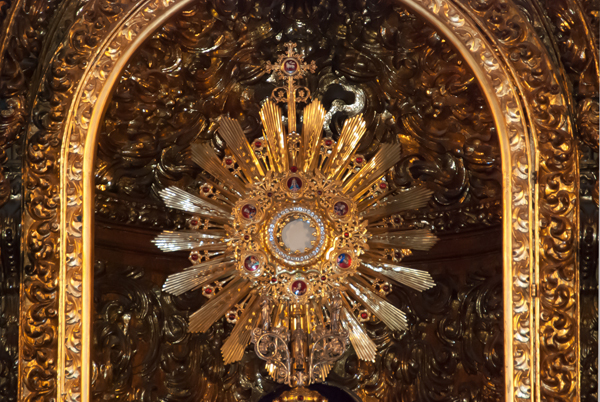
Moor
One of a mixed Arab and Berber conquerors of Spain in the 8th century A.D.
Example: Uruapan, Michoacán, Santiago Apóstol, Santiago Matamoros, closeup of trampled Moor
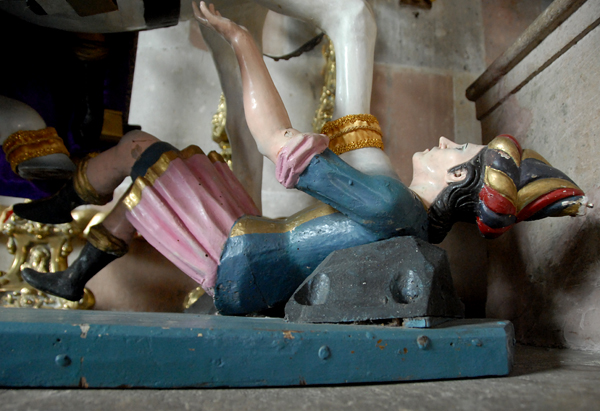
Moorish
Relating to the characteristic of the Moors.
Example: San Cristóbal de las Casas, Chiapas, Moorish Torre del Carmen
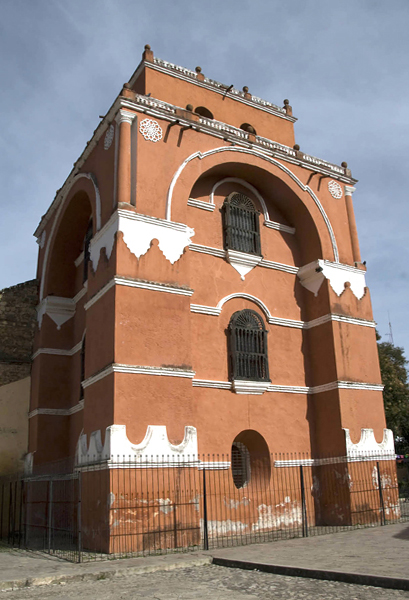
Morisco
A Moor in Spain, especially one who had accepted Christian baptism.
(definition from Online Oxford Languages)
Mozarabic
Northern Spanish architecture built after the 9th century by Christian refugees from Moorish domination, characterized by the horseshoe arch and other Moorish features.
Mudéjar
A Spanish style created by Moors under Christian domination in the 13th and 14th century, but retaining Islamic elements such as the horseshoe arch.
Example: Tzintzuntzan, Michoacán, San Francisco, lower cloister walk, testera ceiling, mudéjar filigree
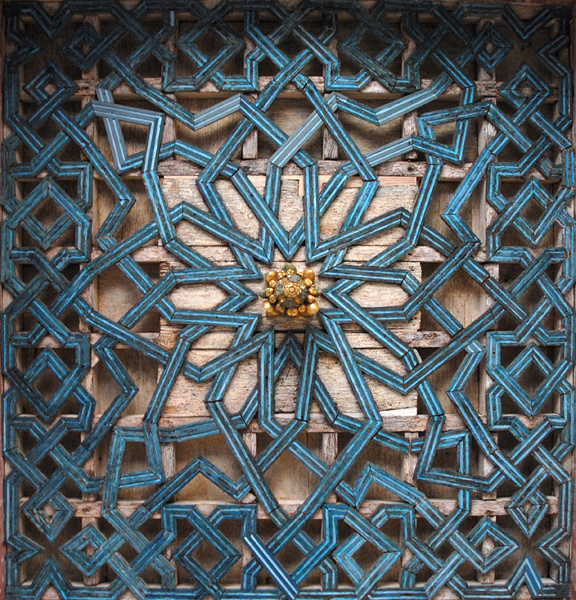
Mullion
A vertical member separating (and often supporting) window, doors, or panels set in series.
Example: Aricutín, Michoacán, Nuestro Señor del Perdón, façade, ajimez mullion
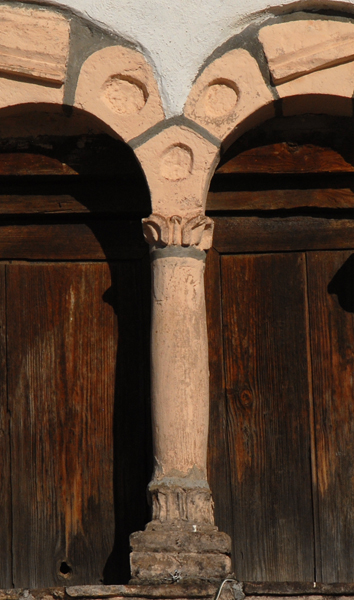
Multifoil
Having five or more foils, lobes, or accurate divisions.
Example: Zimapán, Hidalgo, San Juan Bautista, façade, main portal, multifoil archivolt
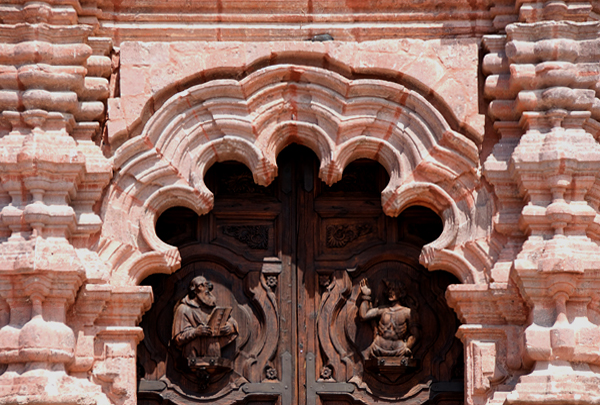
Náhuatl
The common language of the Aztecs and some of their neighbors; the widespread official language used even in non-Aztec parts of the Aztec “Empire”.
(definition from McAndrew, John. The Open-Air Churches of Sixteenth-Century Mexico: Atrios, Posas, Open Chapels and other Studies, Harvard University Press, Cambridge, Massachusetts, 1965, p. 660)
Narthex
An enclosed porch or vestibule at the entrance to some early Christian churches.
Example: Querétaro, Querétaro, Santa Cruz, façade narthex
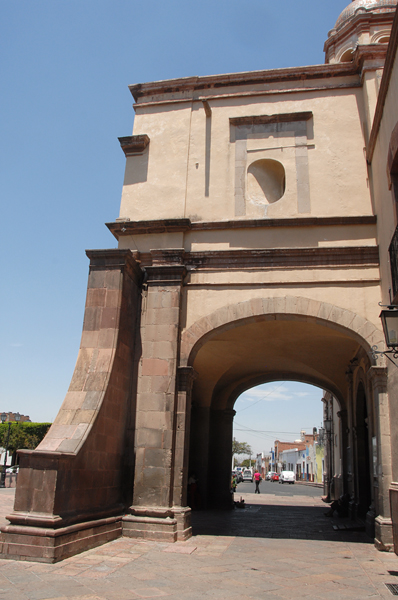
Nave
The middle aisle of a church.
Example: Malinalco, México, El Divino Señor, nave
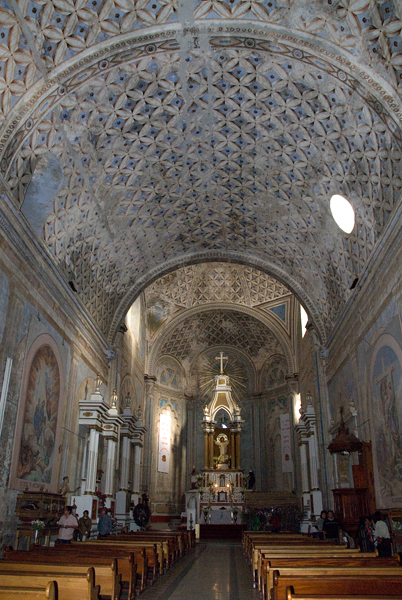
Neoclassicism
Influential revival of classical architecture and sculptural style, in Mexico from the late 18th century.
(definition from Collis, John, and Jones, David M. Mexico Blue Guide, W.W. Norton & Co., New York, 1997, p. 107)
Example: Santiago Tianguistenco, México, Nuestra Señora del Buen Suceso, neoclassical nave and presbytery retablos
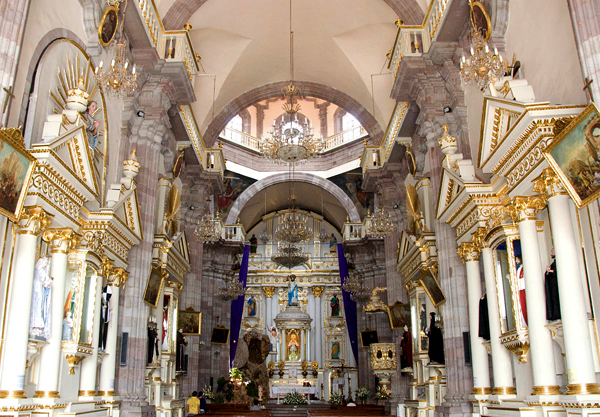
Neostyle Baroque
Soberer Baroque with classical elements, of late 18th century.
(definition from Collis, John, and Jones, David M. Mexico Blue Guide, W.W. Norton & Co., New York, 1997, p. 107)
Example: San Luis Potosí, San Luis Potosí, Santuario de Guadalupe, Neostyle façade
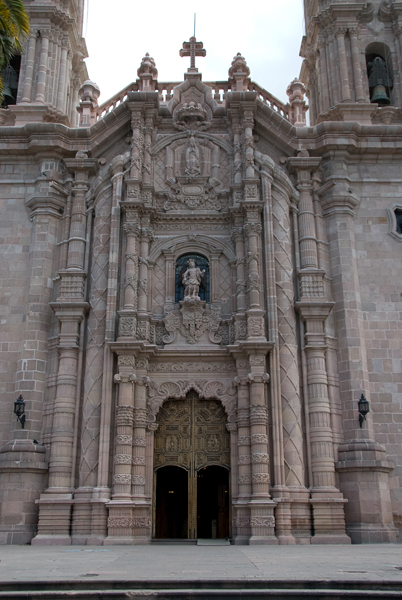
Nervure
Any one of the ribs of a groin vault, especially a rib which forms one of the sides of a compartment of the groining.
Example: Coixtlahuaca, Oaxaca, San Juan Bautista, nave nervure

Niche pilaster
see interestípite
Example: Guanajuato, Guanajuato, San Francisco, façade, lower story right, estípites & niche pilaster
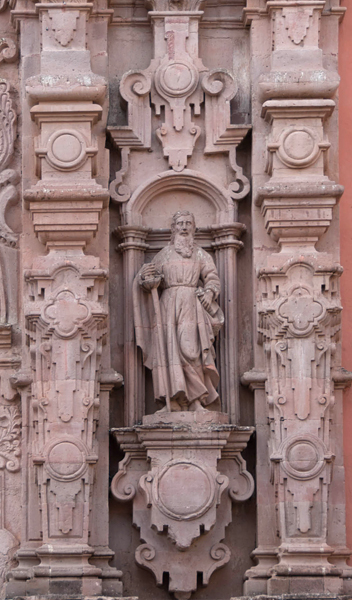
Noria
A mule powered water wheel, housed in domed or thatched well house.
(definition from Perry, Richard. http://colonialmexico.blogspot.com December 31, 2018)
Example: Conkal, Yucatán, San Francisco, noria
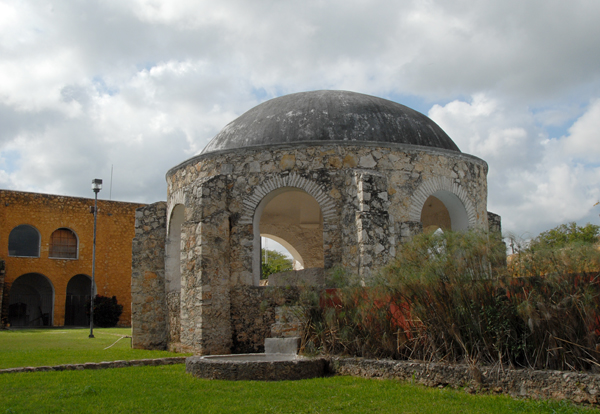
Oculus
A small circular panel or window.
Example: San Ignacio, Baja California Sur, Misión San Ignacio Kadakaamán, façade oculus
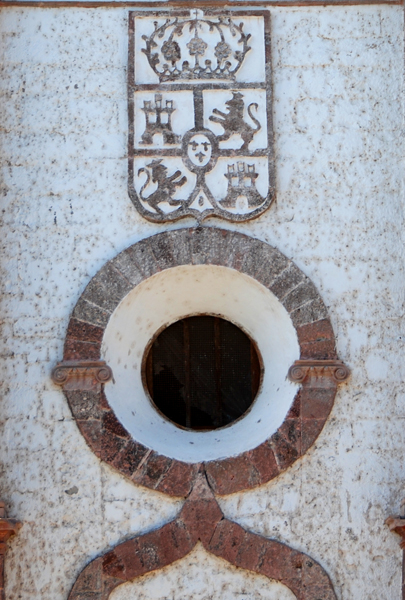
Ogee arch
A pointed arch composed of reversed curves, the lower concave and the upper convex.
Example: Aguascalientes, Aguascalientes, Catedral de Nuestra Señora de la Asunción, façade, choir loft window relief & ogee arch

Ogival arch
In general, a pointed arch.
Example: Ixmiquilpan, Hidalgo, San Miguel Arcángel, lower cloister walk, ogival arches
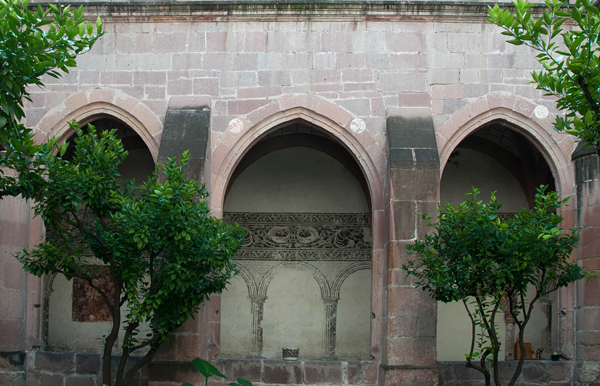
Open Chapel
see Capilla abierta
Example: Tarímbaro, Michoacán, San Miguel, open chapel
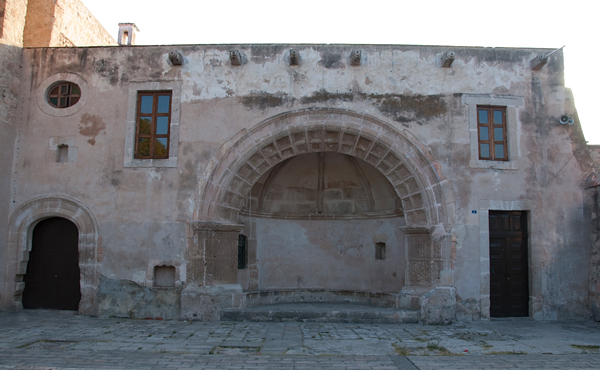
Oratorian
Member of either of two separate but similar congregations of secular priests, one centered in Rome and the other in France. The Institute of the Oratory of St. Philip Neri was founded by the saint in Rome in 1575, approved in 1612, and confederated and reapproved in 1942. It consists of independent communities of secular priests held under obedience but not bound by vows, and it is dedicated to prayer, preaching, and the sacraments. {…}
(definition from The New Encyclopaedia Britannica, Chicago, London, New Delhi, Paris, Seoul21, Sydney, Taipei, Tokyo, 2003, vol. VIII, p. 980)
Example: Querétaro, Querétaro, San Felipe Neri, façade relief, San Feliipe Neri (Oratorian founder)
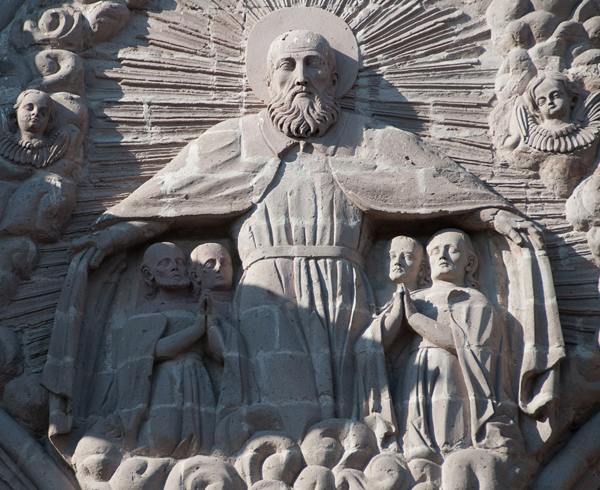
Order of Friars Preachers
see Dominican
Example: Oaxaca, Oaxaca, Santo Domingo, convento cloister fountain, insignia of the Order of Friars Preachers

Ostensory
A device in which the Eucharist wafer may be displayed.
Example: Puebla, Museo de Arte Barroco, forged silver ostensory

Palmette
An ornament derived from a palm leaf.
Example: Irapuato, Guanajuato, Our Lady of Solitude, façade portal detail, palmette relief

Painted Wall Retablo
A painting usually along the nave of a church which portrays a retablo. In some cases, the depiction is meant to eventually be replaced, or covered, by an actual wood-carved retablo with statuary in niches and oil paintings on canvas. In others, the painted wall retablo may act as a backdrop or optical continuation for a smaller wooden altarpiece or framed oil painting centered before it. (personal definition, with guidance by Richard Perry)
Ex: Coatlinchán, México, San Miguel Arcángel, painted wall retablo with painting of La Guadalupe (above) and sculpture of La Soledad (below)

Parade Ground
A large flat area where soldiers march and practice military movements.
(definition from Online Cambridge Dictionary)
Example: Campeche, Campeche, Fuerte de San José El Alto, parade ground & well
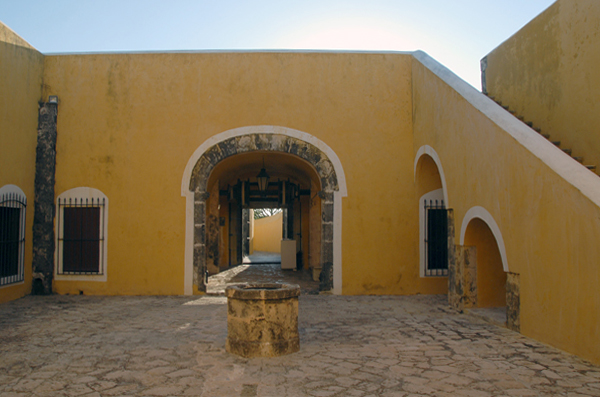
Parapet
A low guarding wall at any point of sudden drop, as at the edge of a terrace, roof, battlement, balcony, etc.
Example: Dzidzantún, Yucatán, Santa Clara de Asís, crenellated parapet
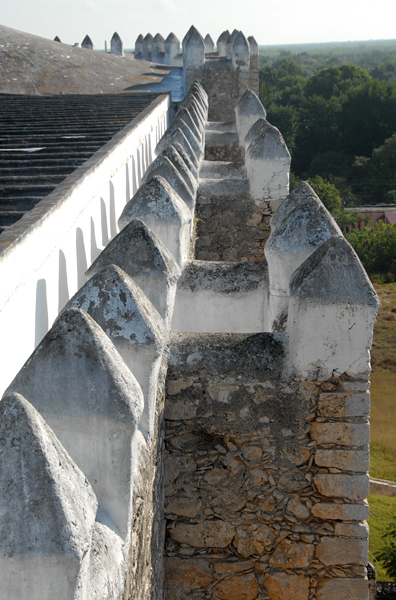
Passion of Christ
see Stations of the Cross
Example: México, D.F., Castillo Chapultepec, ivory Crucifixion
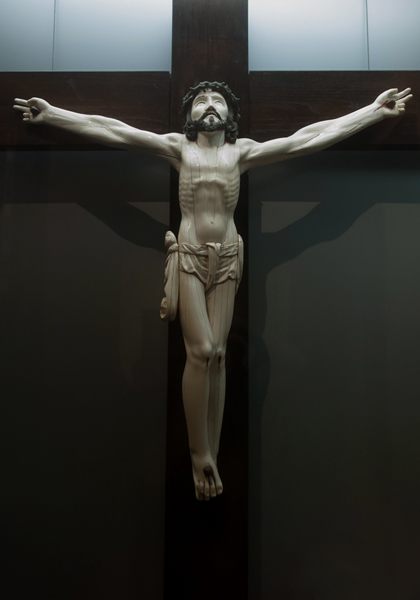
Passion Symbols
Emblems of Christ’s Passion and Death are usually found grouped in illustrations around the Cross. More than a dozen such symbols are found in stone carvings in several English cathedrals. Used alone or together they are also represented frequently in Italian and Spanish art of the sixteenth century: the thirty pieces of silver, the scourge with leaded thongs, the pillar and cord, the sponge, the lance, the ladder, and the winding sheet. {…}
(definition from Hardon, John A. Modern Catholic Dictionary, Doubleday & Company, Inc., Garden City, New York, 1966, p. 406)
Example: Coixtlahuaca, Oaxaca, San Juan Bautista, North doorway, Passion Symbols
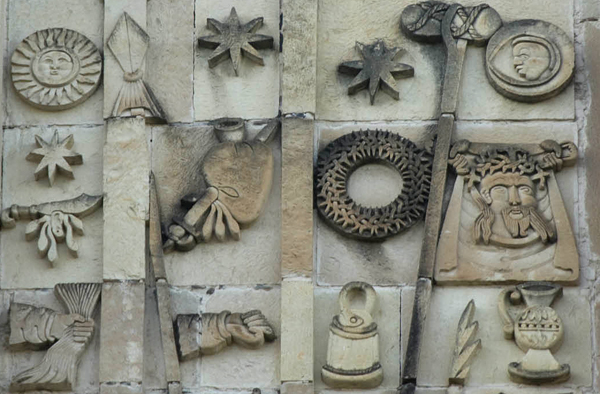
Pediment
In classical architecture, the triangular gable end of the roof above the horizontal cornice, often filled with sculpture.
Example: Tlaquiltenango, Morelos, San Francisco, South portal pediment
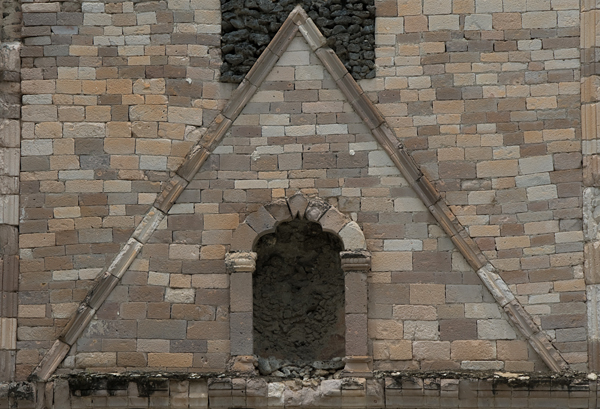
Pendentive
One of a set of curved wall surfaces which form a transition between a dome (or its drum) and the supporting masonry.
Example: Ejutla, Oaxaca, La Natividad de Nuestra Señora, cupola pendentive, St. Mark Evangelist
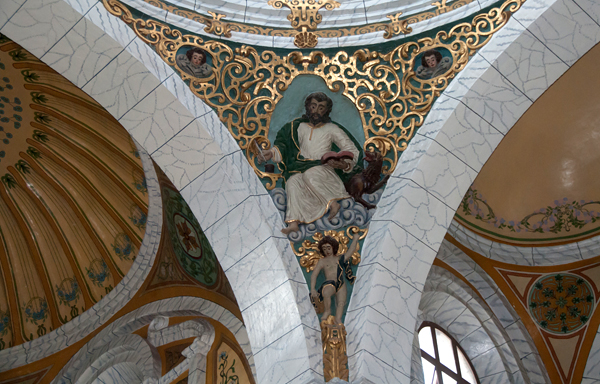
Pictograph
A diagram representing statistical data by pictorial forms.
(definition from Webster’s New Collegiate Dictionary, C. & G. Merriam Company, Springfield, Massachusetts, 1980, p. 890)
Example: Tecamachalco, Puebla, Asunción de Nuestra Señora, façade, date stone pictograph
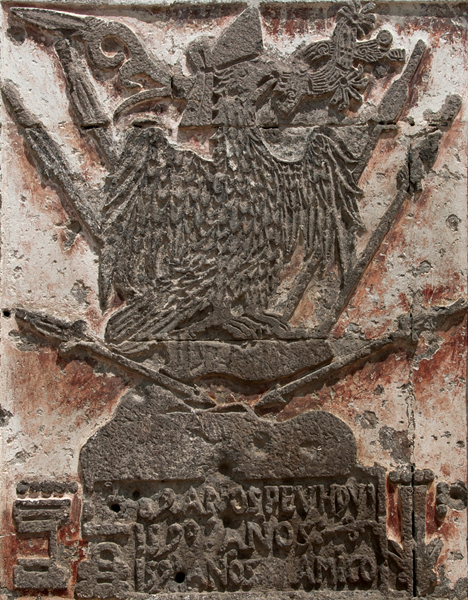
Pier
A column designed to support concentrated load.
Example: Papalotla, México, San Toribio, North atrial gate piers

Pilaster
An engaged pier or pillar, often with capital and base.
Example: Puebla, Puebla, Nuestra Señora de los Remedios, façade, main portal, left pilasters
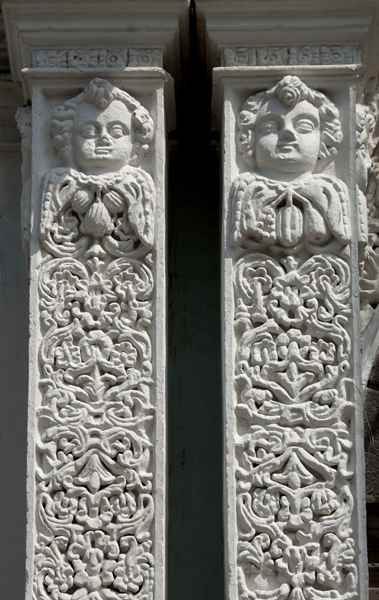
Pillar
A pier.
Example: Teotitlan del Valle, Oaxaca, La Preciosa Sangre de Cristo, cloister pillar

Plateresque
a.) “Silversmith-like”; the richly decorative style of the Spanish Renaissance in the 16th century. Its early phase is also referred to as Isabelline Gothic architecture, after Queen Isabella I (1474-1504).
Example: Mérida, Yucatán, Casa de Montejo, plateresque façade
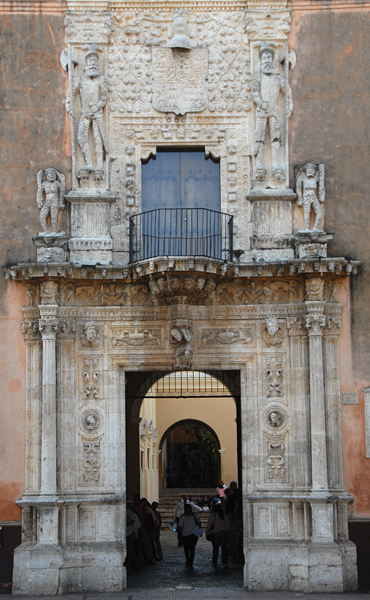
b.) Adaptation in 16th century New Spain of a type of Renaissance architectural decoration which flourished in Spain in the first half of the 16th century. Relief is concentrated around portals and windows, in contrast with the smooth emptiness of the rest of the façade. Plateresque can contain elements of Isabelline Gothic, a style it supersedes—flattish, dense patterns (heraldic, vegetal, geometric) of Mudéjar type, elaborating Spanish Gothic features.
(definition from Collis, John, and Jones, David M. Mexico Blue Guide, W.W. Norton & Co., New York, 1997, p. 108)
Example: Cuitzeo, Michoacán, Santa María Magdalena, plateresque façade
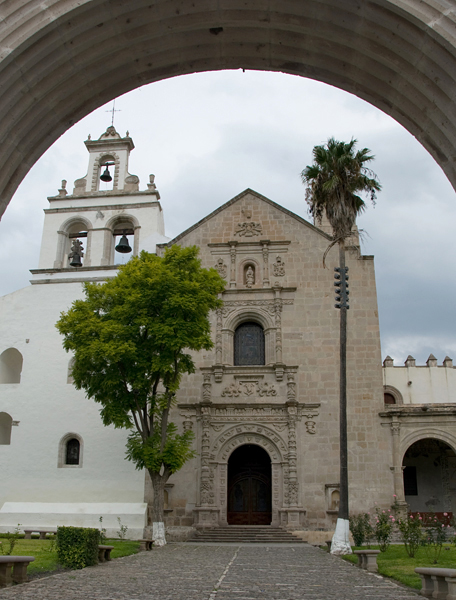
Polychromy
The practice of decorating architectural elements, sculpture, etc. in a variety of colors.
Example: Tlaxcala, Tlaxcala, Nuestra Señora de Ocotlán, Camarín de la Virgen cupola, Virgin Mary with Twelve Apostles in polychromy
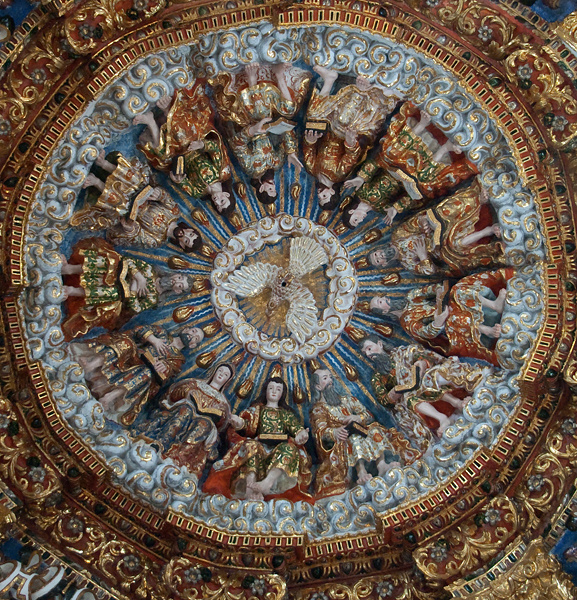
Porciúncula
A rural chapel on the plain below Assisi, Italy, called also St. Mary of the Angels, favorite church and headquarters of St. Francis of Assisi. {…} It was probably built in the 10th or 11th century; its site is first mentioned in a document of 1045, and the chapel itself about 1150. The chapel was originally known as St. Mary of the Angles because of local reports of angelic visitations, but it was called St. Mary of the Portiuncula in the mid-13th century; later both names were used. Its proper ecclesiastical title is uncertain: it may be The Assumption, or it may be The Annunciation (as is suggested by the polyptych behind the altar painted in 1393). The church belonged to the Abbey of Saint Benedict on Mount Subasio, but it was abandoned late in the 12th century, until the young Francis repaired it in 1207. There he received his vocation and founded his first order (1208), acquiring the Portiuncula from the Benedictines (1210) and having it consecrated (1215?).
(definition from New Catholic Encyclopedia, Second Edition, Thomson Gale in association with The Catholic University of America, Washington, D.C., 2003, Volume 11, p. 527)
Note: In sixteenth-century Franciscan conventos in Mexico, the portal opening onto the atrio from the church nave’s North side is called “la puerta porciúncula” in homage to the monastic order’s founder and to his church in Assisi, Italy, St. Mary of the Portiuncula.
Example: Texcoco, México, San Francisco, porciúncular door
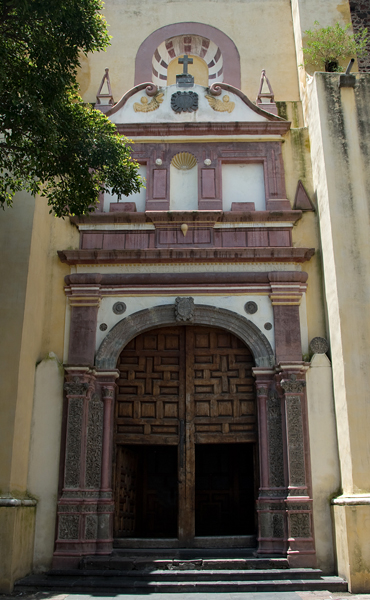
Portavoz
The top portion of a pulpit, suspended above the enclosed platform in which the priest or speaker stands, positioned to help carry the orator’s voice.
(personal definition)
Example: Yaxcabá, Yucatán, San Pedro, pulpit portavoz
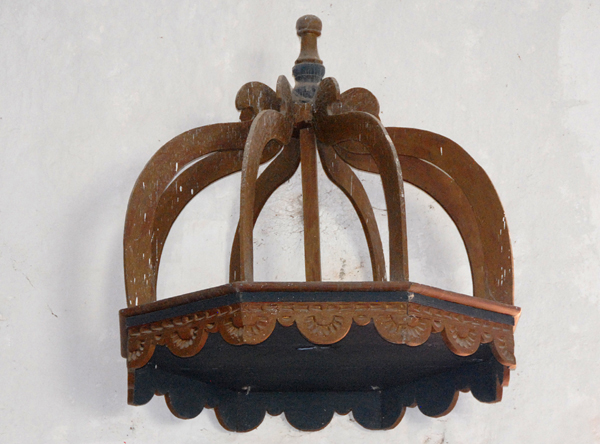
Portería
The entrance to a monastery – usually an arcaded porch or narthex at one side of the church façade.
(definition from: Baird, Joseph Armstrong. The Churches of Mexico 1530-1810, University of California Press, Berkeley and Los Angeles, 1962, p. 67)
Example: Calimaya, México, San Pedro y San Pablo, portería
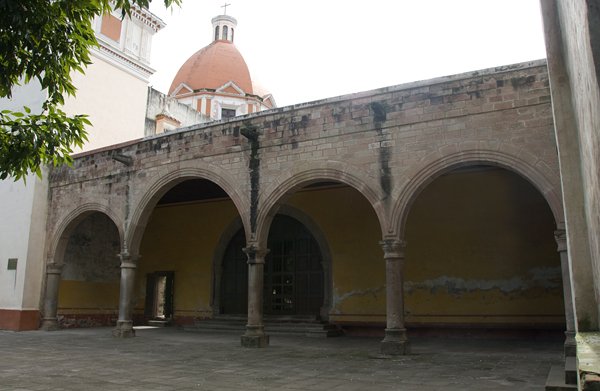
Posa Chapel
see capilla posa
Example: Izúcar de Matamoros, Puebla, Santo Domingo, atrio posa chapel

Post and Lintel
see Trabeated
Example: Acoma Pueblo, New Mexico, San Esteban, post & lintel convento loggia
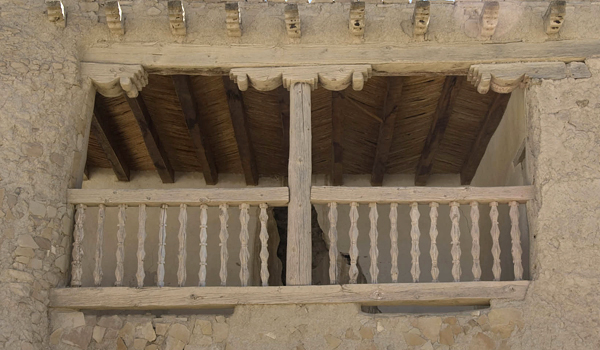
Predella
The bottom tier of an altarpiece, between the principal panel or bas-relief of the altar itself.
Example: Metztitlán, Hidalgo, Los Santos Reyes, high altar predella, St. Benedict (left); two Evangelists (right)

Presbytery
see Sanctuary
Example: San Francisco Coatepec, Michoacán, San Francisco, presbytery
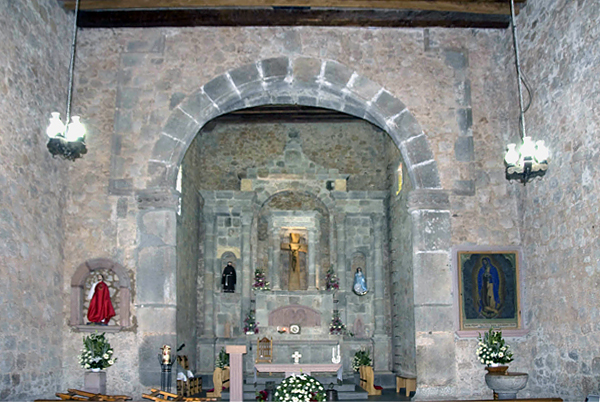
Presidio
In Spanish America, a frontier outpost or post.
Example: Sonoma, California, presidio

Pueblo-Hospital
see Guatápera
Example: Uruapan, Michoacán, Pueblo-Hospital
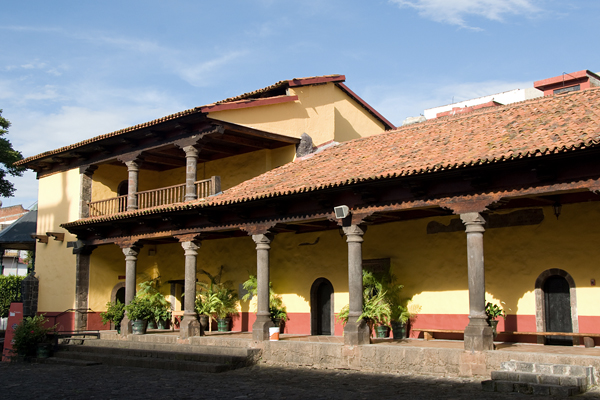
Puerta Abocinada
A concave façade.
(definition from Collis, John, and Jones, David M. Mexico Blue Guide, W.W. Norton & Co., New York, 1997, p. 108)
Example: Mérida, Yucatán, San Cristóbal, façade, puerta abocinada
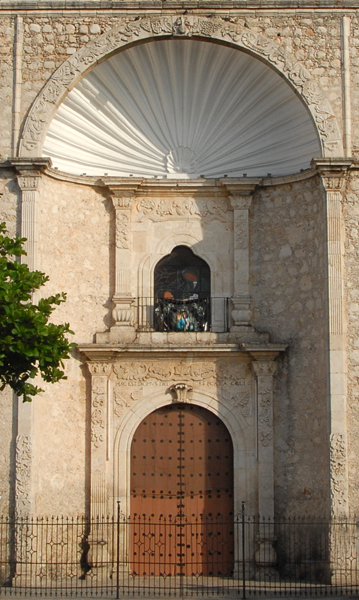
Puerta chata
“Flat doorway” – The flattening of the corner of a building to accommodate a doorway.
(definition from Collis, John, and Jones, David M. Mexico Blue Guide, W.W. Norton & Co., New York, 1997, p. 108)
Example: San Luis Potosí, San Luis Potosí, Real Caja, puerta chata

Pulpit
An elevated enclosed stand in a church in which the preacher stands.
Example: Coatepec, México, La Natividad de Nuestra Señora, pulpit
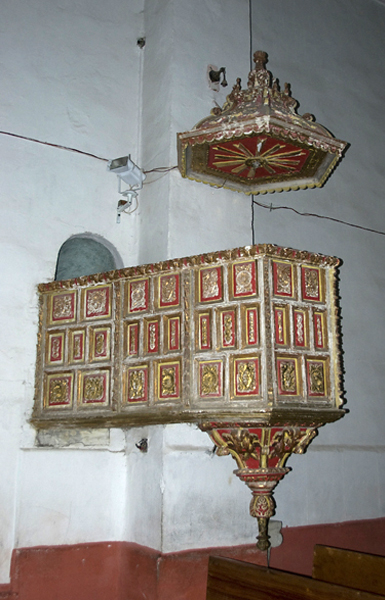
Purépecha
Tarascan language and people.
(definition from Perry, Richard D. Blue Lakes & Silver Cities: The Colonial Arts and Architecture of West Mexico, Espadaña Press, Santa Barbara, California, 1997, p. 259)
Putto
In Renaissance architecture and derivatives, a decorative sculpture or painting representing chubby, usually naked infants.
Example: Ixtlán de Juárez, Oaxaca, Santo Tomás, North nave Pasión de Cristo retablo detail, putto
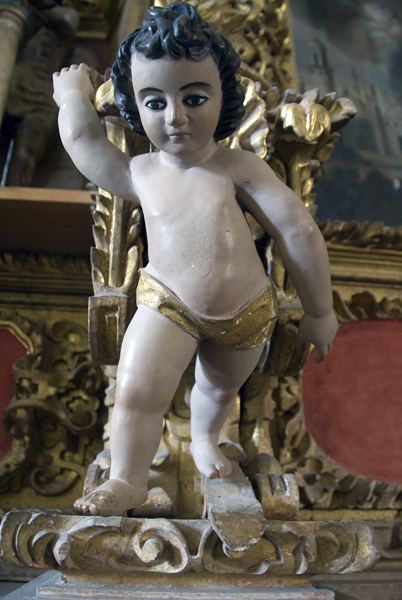
Quadratura
In Baroque interiors and derivatives, painted architecture, often continuing the three-dimensional trim, executed by specialists in calculated perspective.
Example: Tepetitlán, Hidalgo, San Bartolomé, nave quadratura, SS Peter & Paul beside drapery & beneath putti flanking a verónica.

Quadriga
In classical ornamentation and derivatives, the representation of a chariot drawn by four horses, i.e., a royal or divine accoutrerment.
Example: Cholula, Puebla, San Gabriel, lower cloister ambulatory, quadriga mural, Apotheosis of Saint Francis

Quincunx
An arrangements of elements so that four are symmetrically placed around a central one.
Ramada
In Spanish architecture and derivatives, a rustic arbor or similar structure.
Rectory
Originally the residence of the rector of an academic or ecclesiastical institution. Now commonly used in speaking of the residence of the priest in charge of a church or a shrine and his priest assistants.
(definition from Hardon, John A. Modern Catholic Dictionary, Doubleday & Company, Inc., Garden City, New York, 1966, p. 458)
Example: Capulalpam de Mendoza, Oaxaca, San Mateo, church apse & rectory
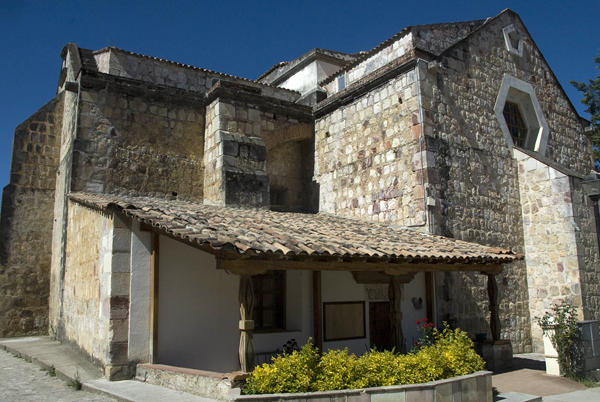
Refectory
A hall in a convent or monastery {…} where meals are eaten.
Example: Actopan, Hidalgo, San Nicolás de Tolentino, painted coffered ceiling of refectory
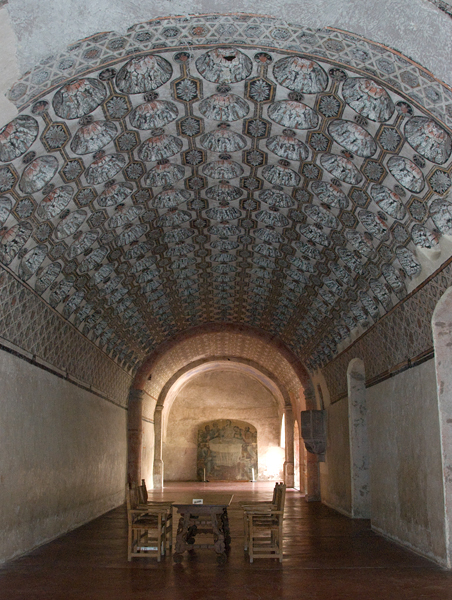
Regulars (Regular Clergy)
Men belonging to religious institutes, whether orders or congregations. In a strict canonical sense, however, regulars are members of religious orders only. The regular clergy are priests who are also bound by the religious rule (regula) of their community.
(definition from Hardon, John A. Modern Catholic Dictionary, Doubleday & Company, Inc., Garden City, New York, 1966, p. 460)
Example: Yecapixtla, Morelos, San Juan Bautista, Sala de Profundis mural detail, Resurrection
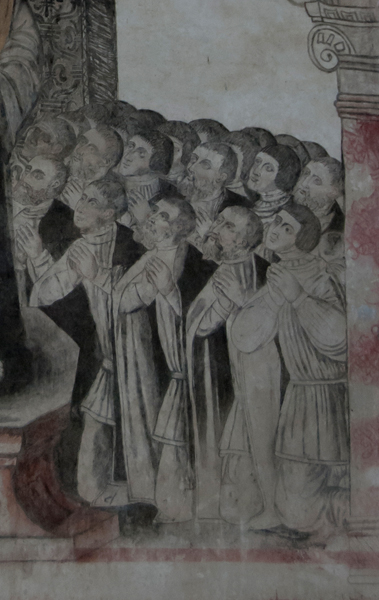
Renaissance
The architectural style developed in early 15th century Italy during the rebirth of classical art and learning. It succeeded the Gothic as the style dominant in all of Europe after the mid-16th century, and evolved through the Mannerist phase into Baroque and the early 17th century into classicism. Initially characterized by the use of the classical orders, round arches, and symmetrical composition.
Example: Tecali, Puebla, Santiago Apóstol, main Renaissance portal
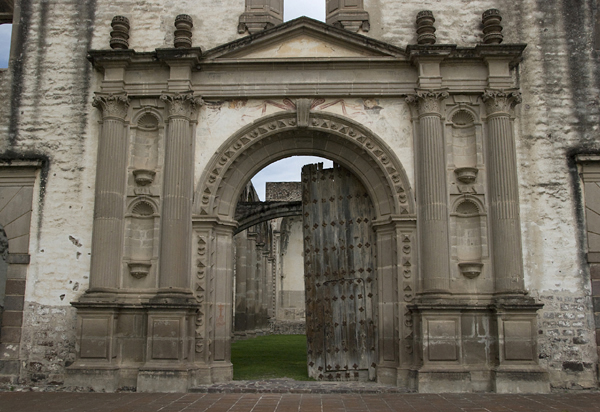
Repartamiento
A weekly allotment of Indian labor.
(definition from Chevalier, François. Land and Society in Colonial Mexico: The Great Hacienda, translated by Alvin Eustis, edited, with foreword by Lesley Byrd Simpson, University of California Press, Berkeley and Los Angeles, 1970, p. 323)
Retablista
A fabricator of retablos.
(definition from: Diccionario de la lengua española, Edición del tricentenario, Real Academia Española, Online personal translation)
Retablo
An altar or altarpiece. (personal definition). "The word retablo derives from the Latin retro and tabula meaning 'behind the table', thus describing a structure which is behind the altar table". (personal translation Vargaslugo, Elisa, México Barocco, vida y arte, Salvat Editores & Grolier Editores, published in Querétaro, 1993, p. 109)
Note: In this site the word retablo is used interchangeably with altar, or altarpiece.
Example: Apizaquito, Tlaxcala, San Luis Rey, right transept retablo
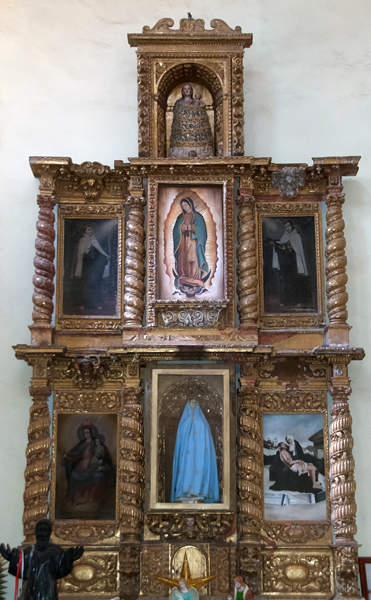
Rib
Moldings which project from the surface and separate the various roof or ceiling panels.
Example: Chapultenango, Chiapas, La Asunción, sacristy ceiling ribs
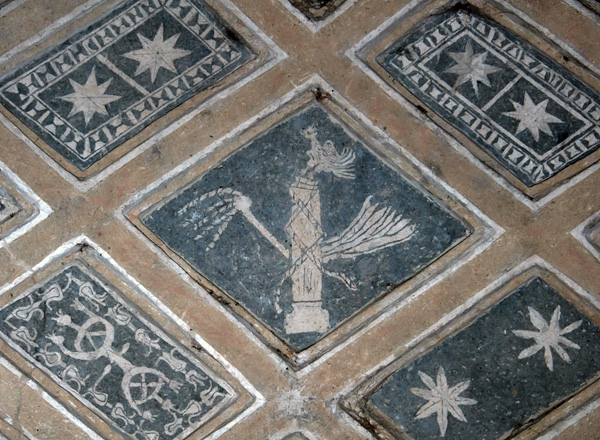
Ribbed Vault
A vault in which the ribs support, or seem to support, the webbing of the vault.
Example: Atlixco, Puebla, San Francisco, ribbed vault
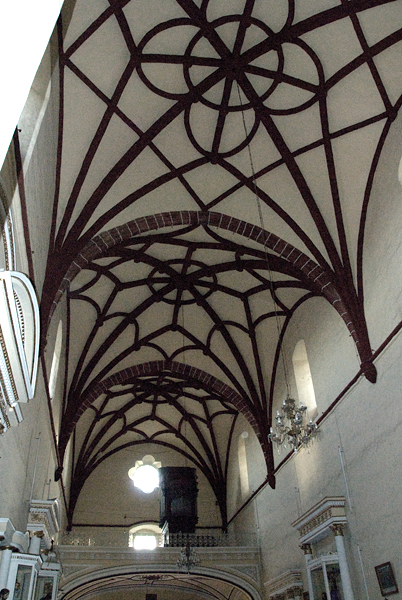
Ribbing
An assemblage or arrangement off ribs, as timberwork sustaining a vaulted ceiling.
Example: Metztitlán, Hidalgo, Los Santos Reyes, stairwell ribbing
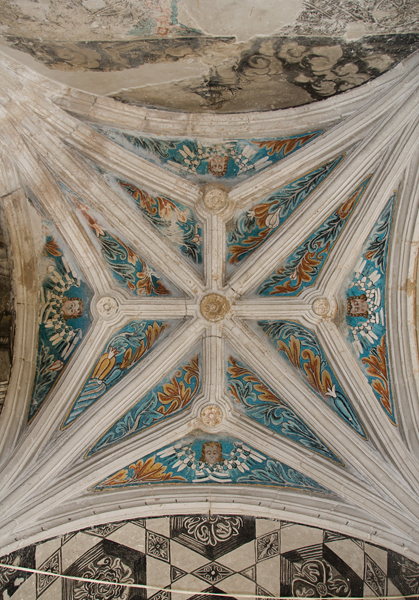
Rocaille
A scroll ornament of the 18th century {...}, combining forms apparently based on those of water worn rocks, plants and shells.
Example: Lagos de Morenos, Jalisco, La Asunción de María, façade portal, rocaille relief

Rollo
Tower in plaza, from whose base justice was dispensed.
(definition from Collis, John, and Jones, David M. Mexico Blue Guide, W.W. Norton & Co., New York, 1997, p. 109)
Example: Tlaquiltenango, Morelos, rollo
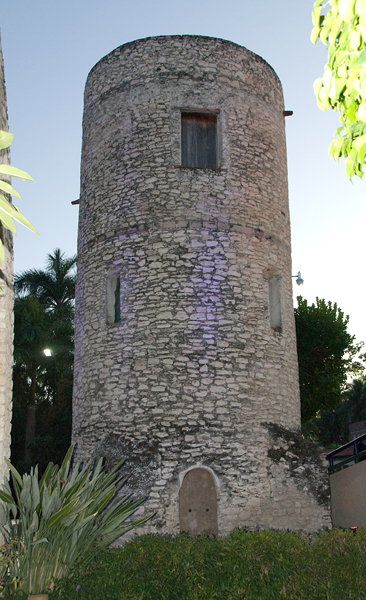
Roman arch
A semicircular arch. If built of stone, all units are wedge-shaped; the usual arch in Roman architecture.
Example: Tararameo, Michoacán, San Juan Evangelista, open chapel, twin Roman arches

Rose Window
A large, circular medieval window, containing tracery disposed in a radial manner.
Example: Molango, Hidalgo, Nuestra Señora de Loreto, façade rose window
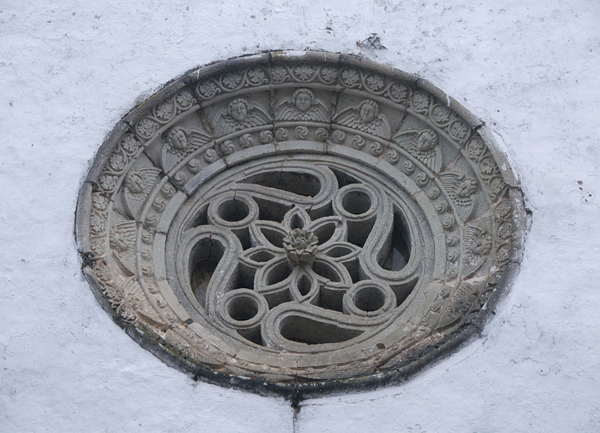
Rosette
A round pattern with a carved or painted conventionalized floral motif.
Example: Tlachichilco, Hidalgo, San Pedro, façade, main portal, left pilaster rosettes
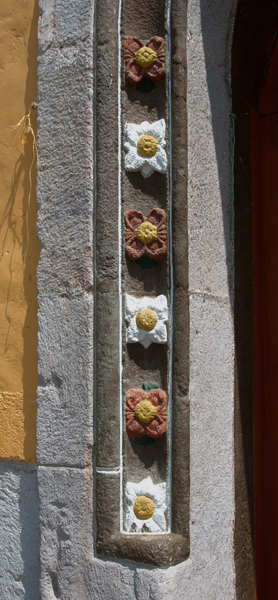
Roundel
A small circular panel or window.
Example: Texcoco, México, San Francisco, porciúncula door, right spandrel roundel

Sacristy
A room in a church, near the sanctuary, where the robes and altar vessels are stored, where the clergy vest themselves for services, and where some business of the church may be done; usually a single room but usually a very large one.
Example: San Luis Potosí, San Luis Potosí, San Francisco, portal to sacristy
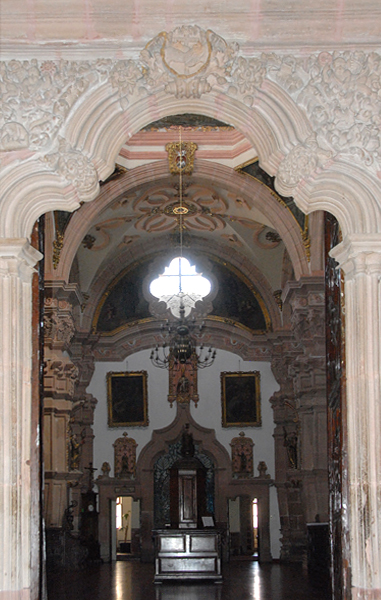
Sala Capitular
A large chamber in a monastery, usually located off the second story cloisterwalk, designated for gatherings or meetings by members of the religious order, meant to discuss matters of organization, operation, business, etc.
personal definition
Example: Cuitzeo, Michoacán, Santa María Magdalena, sala capitular

Sala de Profundis
In a monastery a chamber beside the refectory off the lower cloister walk where friars or monks say Grace prior to taking their mails. Another use for this room is to prepare deceased religious for burial, which traditionally involves the singing of one of the six penitential psalms, No. 130, i.e., the "de Profundis".
(personal definition)
Example: Yecapixtla, Morelos, San Juan Bautista, sala de profundis

Salomónica
A twisted or spiral column.
Example: Campeche, Campeche, San Francisquito, South nave, Nuestra Señora de los Dolores retablo, salomónicas
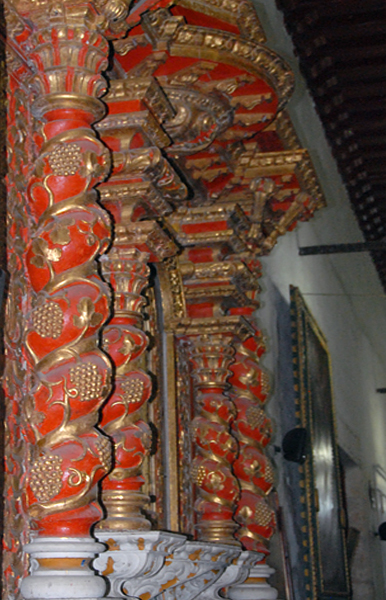
Sanctuary
In a church, the immediate area around the principal altar.
Example: Tutotepec, Hidalgo, Los Santos Reyes, sanctuary
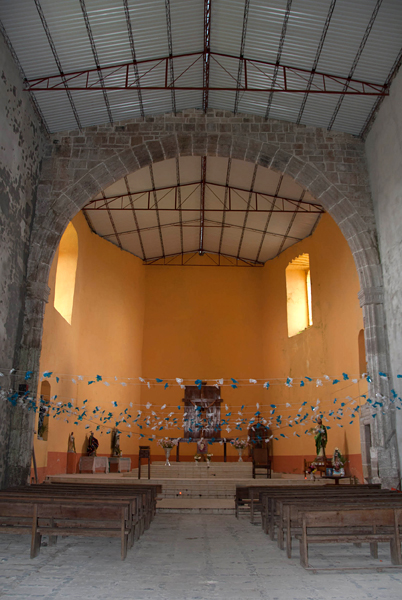
Secco
The art of painting on dry plaster.
(definition from Webster’s New Collegiate Dictionary, C. & G. Merriam Company, Springfield, Massachusetts, 1980, p. 1060)
Example: Villa Tezontepec, Hidalgo, San Pedro Apóstol, lower cloister walk secco mural, Flight into Egypt
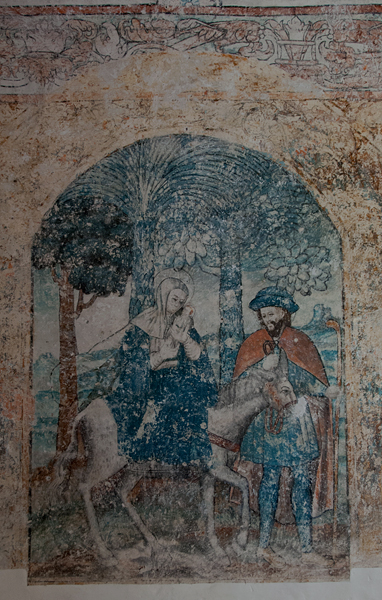
Seculars (Secular Clergy)
Clergy who are engaged for the most part in pastoral work and who are not members of a religious institute. They are not bound by a vow of poverty or community life. But their celibacy, in the Latin Church, is under solemn oath and they promise obedience to a bishop as their immediate superior under the Pope.
(definition from Hardon, John A. Modern Catholic Dictionary, Doubleday & Company, Inc., Garden City, New York, 1966, p. 497)
Example: Valladolid (Sisal), Yucatán, San Bernardino de Siena, nave niche mural closeup, Resurrection of Christ, secular clergy along with apostles & St. Bernadine of Siena

Sentry Box
A shelter for a sentry on his post.
(definition from Webster’s New Collegiate Dictionary, C. & G. Merriam Company, Springfield, Massachusetts, 1980, p. 1073)
Example: Perote, Veracruz, Fortaleza de San Carlos, sentry box
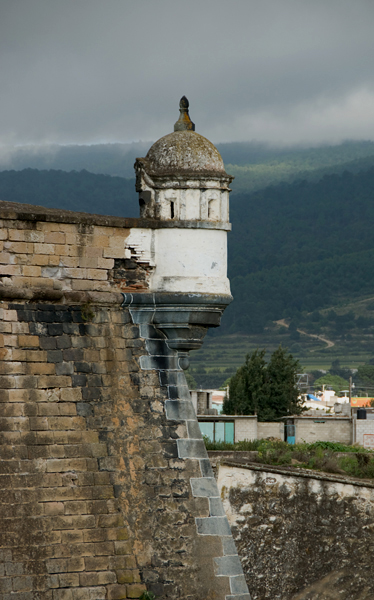
Seraph(im)
Angel(s) composing the highest choir of the angelic kingdom. The root meaning of their name is “to consume with fire”, indicating their intense love of the Holy Trinity.
(definition from Hardon, John A. Modern Catholic Dictionary, Doubleday & Company, Inc., Garden City, New York, 1966, p. 500)
Example: Cocucho, Michoacán, San Bartolomé, sotocoro mural detail, instrumental seraph
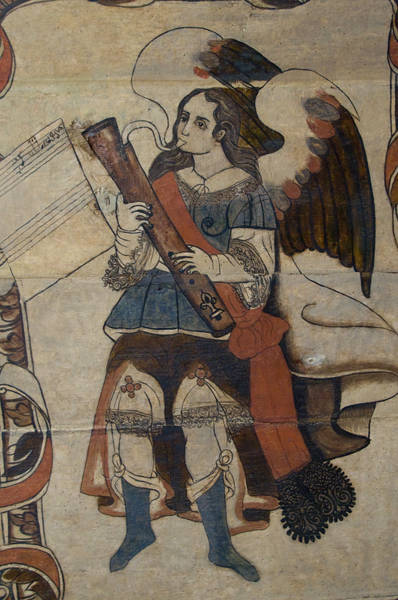
Seraphic Order
see Franciscan
Example: Zinacantepec, México, San Miguel, portería mural detail, lineage of the Seraphic Order
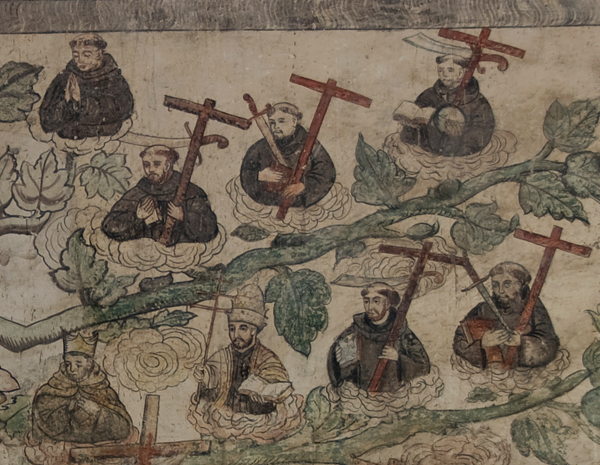
Seraphic Vision
also see Stigmata
While he was praying on the mountain of Verna {…} Francis is said to have had a vision on or about 13 September 1224, the Feast of the Exaltation of the Cross, as a result of which he received the Stigmata. Brother Leo, who had been with Francis at the time, left a clear and simple account of the event, the first definite account of the phenomenon of Stigmata. "Suddenly he saw a vision of a seraph, a six-winged angel on a cross. This angel gave him the gift of the five wounds of Christ."
(definition from Online The Free Encyclopedia Wikipedia, Stigmata, final days, and sainthood)
Example: Huichapan, Hidalgo, La Tercera Orden, lateral portal pediment, Seraphic Vision
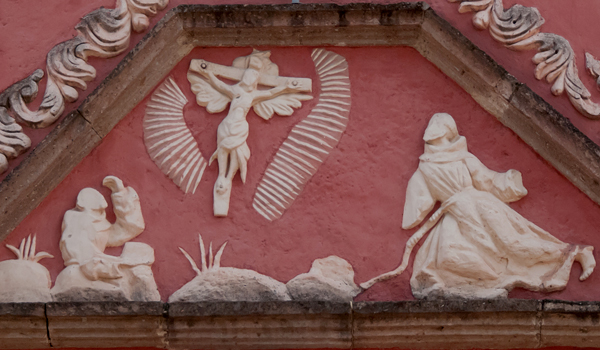
Sgrafitto
A type of decoration executed by covering a surface, as of plaster or enamel, of one color, with a thin coat of a similar material of another color, and then scratching or scoring through the outer coat to show the color beneath.
Example: Chikindzonot, Yucatán, San Antonio de Padua, façade portal detail (right), sgrafitto
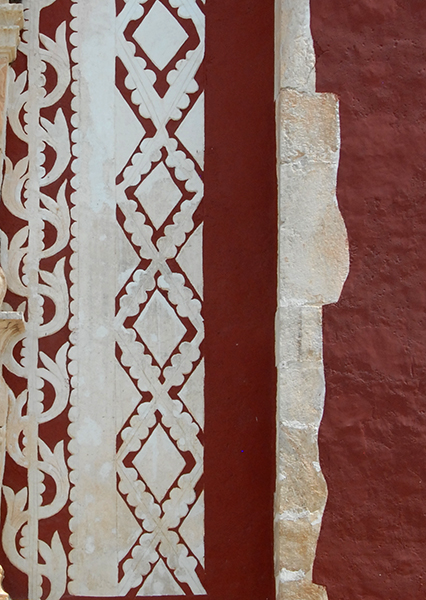
Society of Jesus
see Jesuit
Example: Coyoacán, D.F., Museo de la provincia mexicana de la Compañía de Jesús {Society of Jesus}, Juan Patricio Morlete Ruiz, Allegory of the Crucifixion with Jesuit saints, circa 1760-70
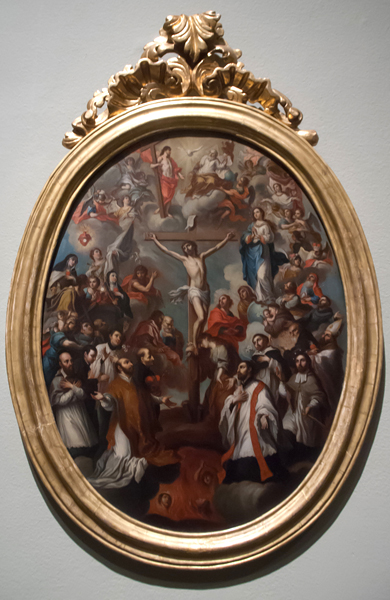
Solomonic column
see salomónica
Example: Cuautepec de Madero, D.F., La Preciosa Sangre de Cristo, façade, lower story Solomonic columns
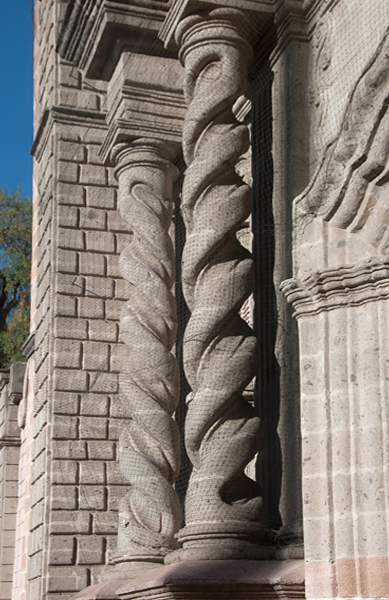
Sotocoro
Space in church beneath the choir loft.
(definition from Collis, John, and Jones, David M. Mexico Blue Guide, W.W. Norton & Co., New York, 1997, p. 109)
Example: Nurio, Michoacán, Santiago Apóstol, sotocoro (destroyed by fire, March 7, 2021)
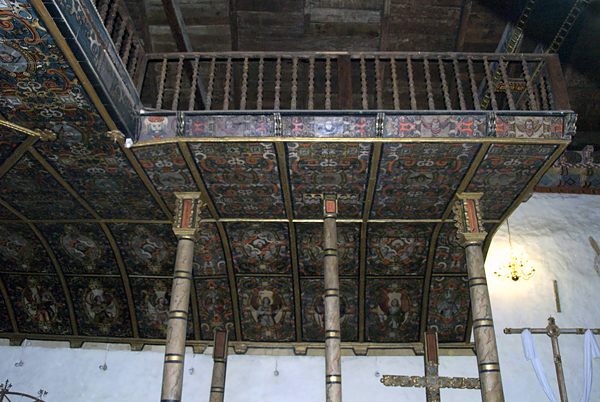
Spandrel
An area, roughly triangular in shape, included between the extrados of two adjoining arches and a line approximately connecting their crowns (or a space approximately equal to half this in the case of a single arch); in medieval architecture, often ornamented with tracery, etc.
Example: Querétaro, Querétaro, San Isidro, façade, main portal, right spandrel
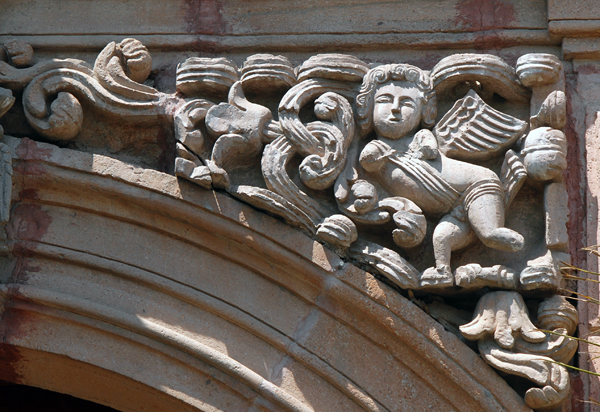
Spindle
A turned, often decorative piece (as in a baluster).
(definition from Webster’s New Collegiate Dictionary, C. & G. Merriam Company, Springfield, Massachusetts, 1980, p. 1136)
Example: Durango, Durango, Palacio del Conde del Valle de Súchil, patio, second story balusters & spindle

Springer
The lower voussoir, or bottom stone of an arch, which lies immediately on the impostimpost.
Example: Totolinga, México, San Lorenzo, façade portal, archivolt springer (left)

S-scroll
An ornamental motif in the form of the letter S.
(definition from Collins on-line English dictionary)
Example: Tlaquepaque, Jalisco, San Pedro, façade gable detail, column and S-scroll

Stations of the Cross
A devotion formed by meditating on the Passion of Christ, successively before fourteen stations of the Cross. The stations are wooden crosses, normally attached to the interior walls of a church, although they may be erected anywhere, e.g., outside along a pathway. The pictures or representations depicting various scenes from Christi’s Via Crucis are aids to devotion on the traditional stations: 1. Jesus is Condemned to Death; 2. Jesus Bears His Cross; 3. Jesus Falls the First Time; 4. Jesus Meets His Mother; 5. Jesus is Helped by Simon; 6. Veronica Wipes the Face of Jesus; 7. Jesus Falls a Second Time; 8. Jesus Consoles the Women of Jerusalem; 9. Jesus Falls a Third Time; 10. Jesus is Stripped of His Garments; 11. Jesus is Nailed to the Cross; 12. Jesus Dies on the Cross; 13. Jesus is Taken Down from the Cross (Deposition and Lamentation); 14. Jesus is Laid in the Tomb (Entombment) {…}
(definition from Hardon, John A. Modern Catholic Dictionary, Doubleday & Company, Inc., Garden City, New York, 1966, p. 519)
Example: Tepalcingo, Morelos, Jesús Nazareno, nave sculpture, Via Crucis

Stigmata
also see Seraphic Vision
Phenomenon in which a person bears all or some of the wounds of Christ in his or her own body, i.e., on the feet, hands, side and brow. The wounds appear spontaneously, from no external source, and periodically there is a flow of fresh blood. The best known stigmatic was St. Francis of Assisi. During an ecstasy on Mount Alvernia on September 17, 1224, he saw a seraph offer him an image of Jesus crucified and imprint upon him the sacred stigmata. Blood used to flow from these wounds until the time of his death two years later. He tried to conceal the phenomenon but not very successfully. Since that time scholarly research has established some three hundred twenty cases of stigmatization, among them more than sixty persons who have been canonized {...}.
(definition from Hardon, John A. Modern Catholic Dictionary, Doubleday & Company, Inc., Garden City, New York, 1966, p. 520)
Example: Puebla, Puebla, Santa Mónica, convento museum painting, anonymous, 18th century, St. Catherine of Siena receiving the Stigmata
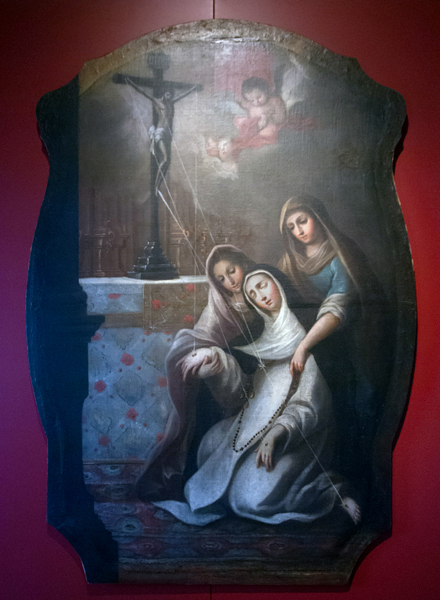
Stoup
A basin for holy water, sometimes free-standing but more often affixed to or carved out of a wall or pillar near the entrance of a church.
Example: Tetepango, Hidalgo, San Pedro, nave stoup
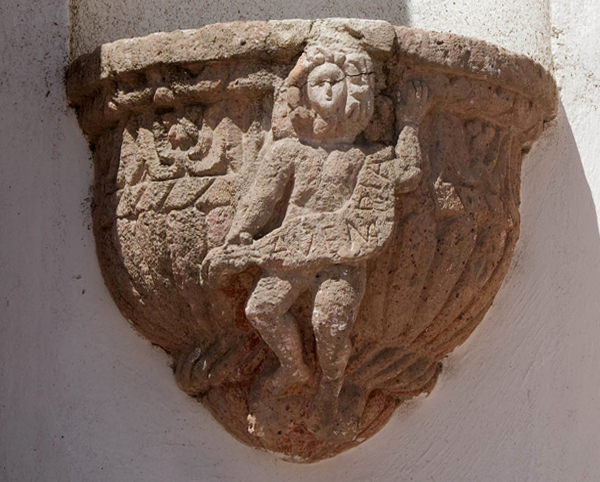
Strapwork
A type of ornament consisting of a narrow fillet or band which is folded, crossed, and interlaced.
Example: Tlacolula, Oaxaca, La Asunción, Capilla del Santo Señor, nave vault and sotocoro strapwork
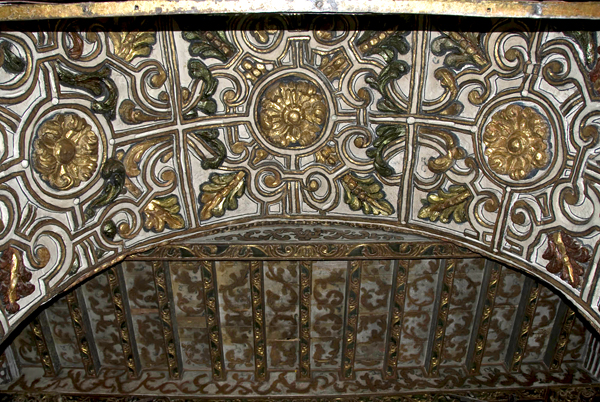
Stucco
An exterior finish, usually textured; composed of portland cement, lime and sand which are mixed with water. A fine plaster used for decorative works or moldings.
Example: Santa Isabel Tepetzala, Puebla, Santa Isabel, nave vault & cupola stucco

Sudarium
see Verónica (Veronica's Veil)
Example: Puebla, Puebla, La Santa Cruz, Capilla de Santa Elena, Via Crucis painting detail, three sudariums
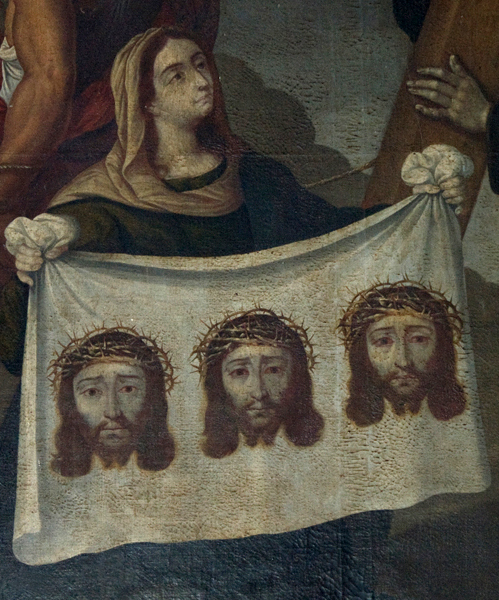
Sunburst
A stylistic pattern employed by the ancient Egyptians to worship the sun god Ra, in Baroque Mexico the sunburst motif is normally found in a large format as a crowning element of a retablo (such as in lieu of an attic), or within the ensemble of the altarpiece itself. It is distinguished by a pattern radiating out from a central zone usually represented in the form of the face of Christ, a crown of thorns, sudarium, a dove (the Holy Spirit), a Marian symbol, the insignia of a religious order, etc. In diminutive form the sunburst often adorns a monstrance within the tabernacle in the lower tier of the retablo. (personal definition)
Example: Yucucui, Oaxaca, San Mateo, nave Crucifixion altarpiece detail, sunburst with sudarium

Tabernacle
A decorative niche often topped with a canopy and housing a statue.
Example: San Juan Capistrano, California, San Juan Bautista, Serra Chapel, tabernacle
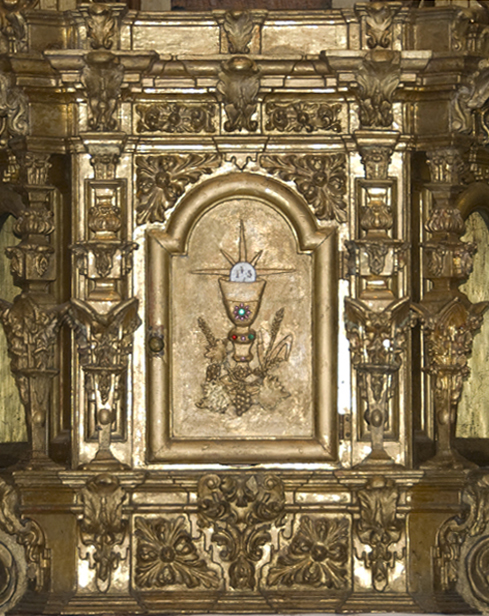
Tarascan
Indian tribe located primarily in the modern state of Michoacán.
(definition from Meyer, Michael C. and Beezley, William H. The Oxford History of Mexico, Oxford University Press, New York, 2000, p. 676)
Tecpan
Municipal palace for the native government.
(definition from Jackson, Robert. Evangelization and Cultural Conflict in Colonial Mexico, Cambridge Scholars Publishing, Newcastle upon Tyne, Great Britain, 2014, Introduction, p. xxii)
Example: Coixtlahuaca, Oaxaca, tecpan
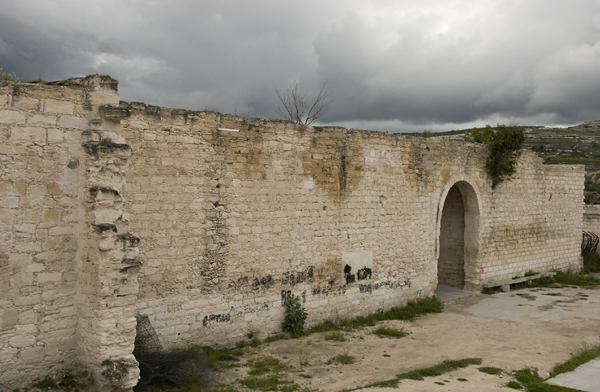
Telemon(es)
A sculpted male human figure used in place of a column to support an entablature, also called an atlas.
Example: Yuriria, Guanajuato, San Pablo, façade, left closeup, telemones
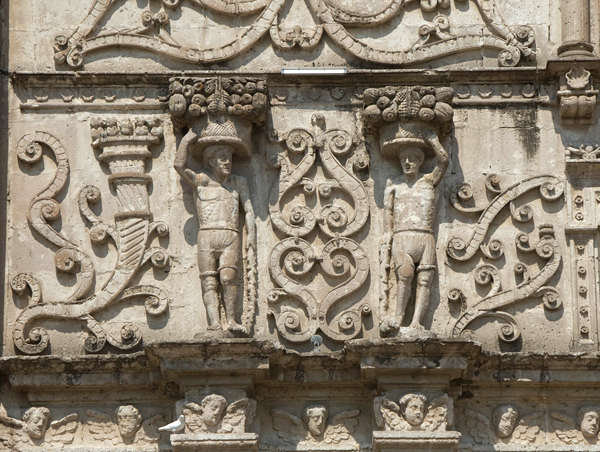
Tequítqui
a.) Combining pre-Conquest Indian and early Conquest Hispanic art
forms. (definition from: Baird, Joseph Armstrong. The Churches of
Mexico 1530-1810, University of California Press, Berkeley and
Los Angeles, 1962, p. 68)
Example: Coixtlahuaca, Oaxaca, San Juan Bautista, capilla abierta, archivolt voussoirs with tequítqui relief
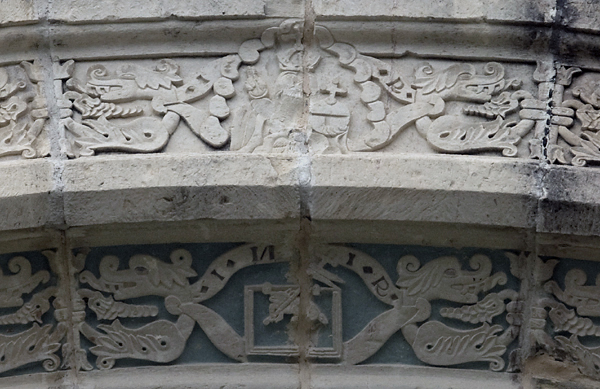
b.) Early Spanish colonial sculpture of European forms using pre-
Conquest stone-carving techniques.
(definition from Perry, Richard.Mexico’s Fortress Monasteries, Espadaña Press, Santa Barbara, California, 1992, p. 205)
Example: Tarécuato, Michoacán, Santa María de Jesús, atrial cross, tequítqui base
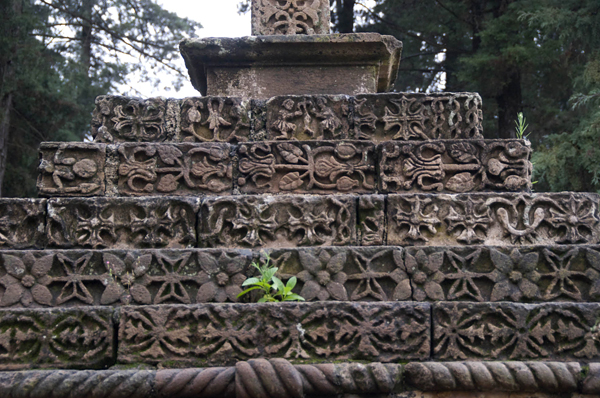
c.) Post-Conquest art using European motifs with Indian sense of
pattern. (definition from Collis, John and Jones, David M.Mexico Blue
Guide, W.W. Norton & Co., New York, 1997, p. 109)
Example: Tlamaco, Hidalgo, San Jerónimo, façade, archivolt tequítqui detail
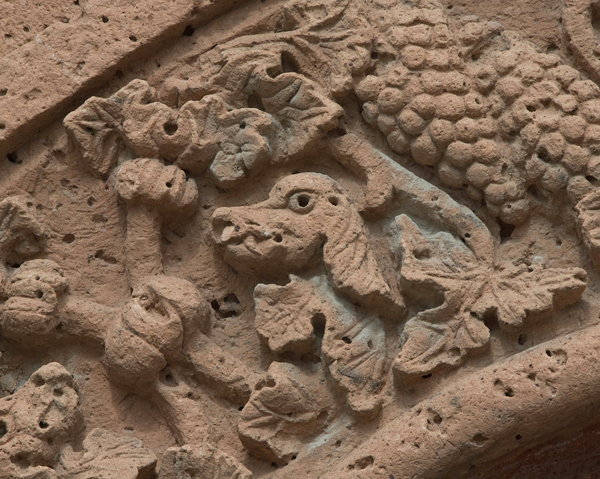
d.) Stylistic label applied to painting and sculpture that appears to
combine naturalism and stylization, perhaps caused by native artists reconciling ancestral traditions and European approaches to image-making.
(definition from Donahue-Wallace, Kelly. Art and Architecture of
Viceregal Latin America, 1521-1821, University of New Mexico Press, Albuquerque, 2008, p. 261)
Example: Ixtapan de la Sal, México, La Inmaculada Concepción, façade, main portal, right jamb capital, tequítqui relief of Adam & Eve
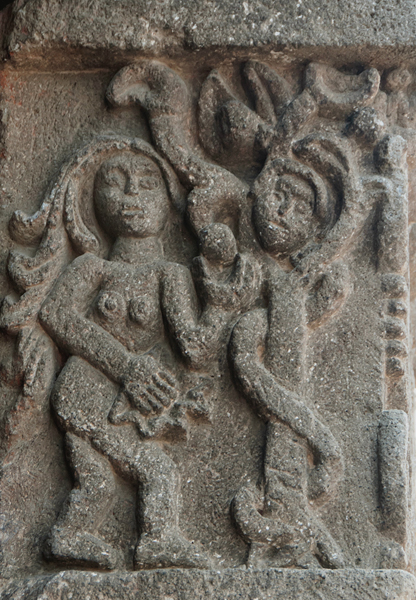
Templo-fortaleza
A church-fortress.
(definition from de Gante, Pablo C. La arquitectura de México en el siglo XVI, Editorial Porrua, S.A., México, D.F., 1954, p. 83)
Example: Tepeaca, Puebla, San Francisco, templo-fortaleza, apse & external nave
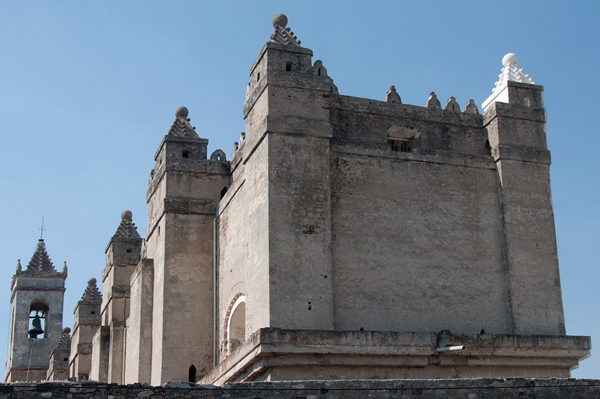
Teocalli
An ancient temple of Mexico or Central America usually built upon the summit of a truncated pyramid mound.
(definition from Webster’s New Collegiate Dictionary, C. & G. Merriam Company, Springfield, Massachusetts, 1980, p. 1216)
Example:Acatitlán, México, teocalli
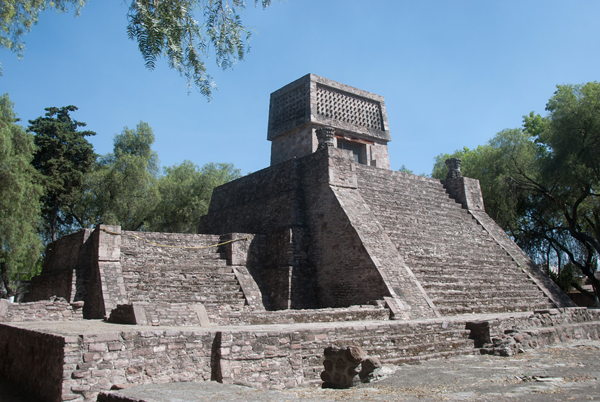
Tercena
see Tecpan
Example: Metztitlán, Hidalgo, Tercena
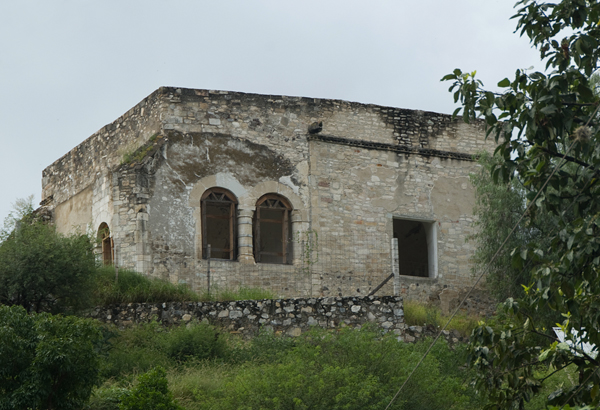
Term
A decorative figure in which a head, or a head and bust, or the human figure to the waist and including the arms, is incorporated with (as if it were springing out of) a pillar which serves as its pedestal.
Example: Querétaro, Querétaro, San Agustín, lower cloister walk, arch spandrel term
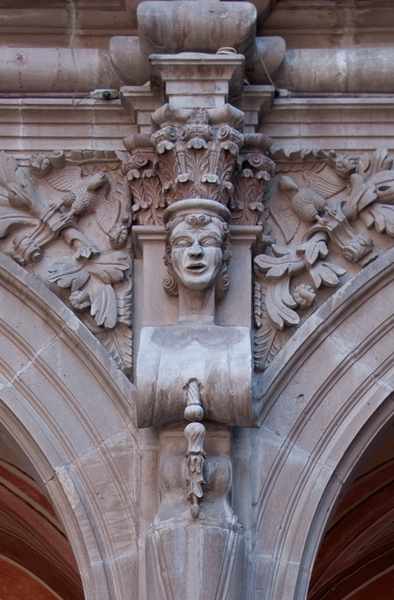
Testera
Each of the four corners -- sometimes in the partial form of recessed niches -- at the end of cloister walks (principally the lower ones) in a 16th century Mexican monastery, where tlacuilos painted didactic biblical scenes in secco for the benefit of catechumens, often meant (as with posa chapels in the church atrio ) to be visited in a processional manner, beginning from the NW testera beside the anteportería and proceeding sequentially to the SW, SE, NE and finally back to the NW one. (personal definition)
Example: Huejotzingo, Puebla, San Miguel Arcángel, lower cloister ambulatory testera
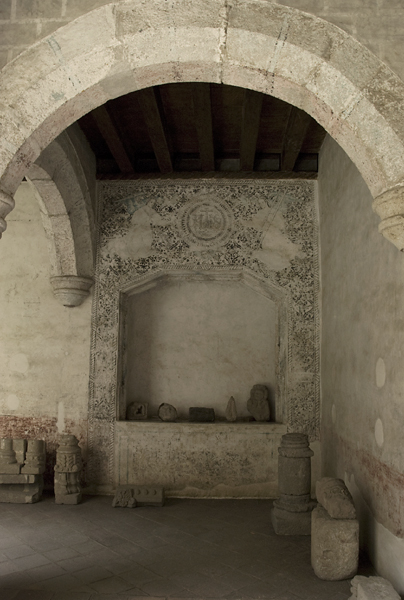
Testerian Manuscript
Named after friar Jacobo de Testera, pictorial religious works which employed pictures and images that translated into specific series of words or sounds to produce texts, such as the Ten Commandments or Catholic prayers.
(definition from Christensen, Mark Z. Nahua and Maya Catholicisms: Texts and Religion in Colonial Central Mexico and Yucatan, Stanford University Press, California, 2013, p. 22)
Tetramorph
A symbolic arrangement of four differing elements, or the combination of four disparate elements in one unit {…}. The association of the four living creatures with the Four Evangelists originated with Irenaeus in the 2nd century. The interpretation of each creature has varied through church history. The most common interpretation, first laid out by Victorinus and adopted by Jerome, St. Gregory, and the Book of Kells is that the man is Matthew, the lion Mark, the ox Luke, and the eagle John. The creatures of the tetramorph, just like the four gospels of the Evangelists, represent four facets of Christ.
(definition from Online The Free Encyclopedia Wikipedia)
Example: Tonalá, Jalisco, Santiago Apóstol, pulpit closeup, Evangelists' tetramorph
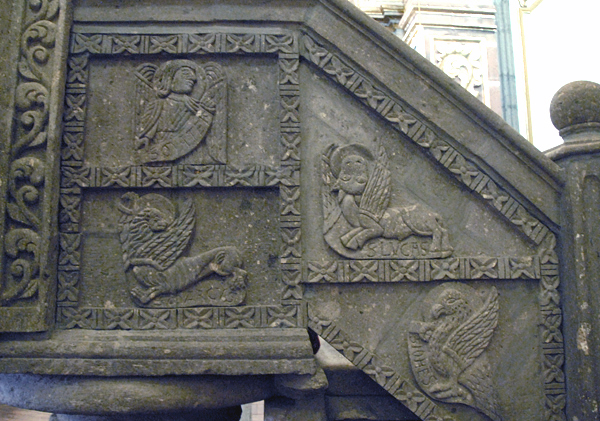
Tezontle
A reddish, or brownish, or purplish building stone of volcanic origin.
(definition from Early, James. The Colonial Art of Mexico, Southern Methodist University Press, Dallas, 2001, p. 208)
Example: México, D.F., Colegio de Las Vizcaínas, North tezontle face with windows
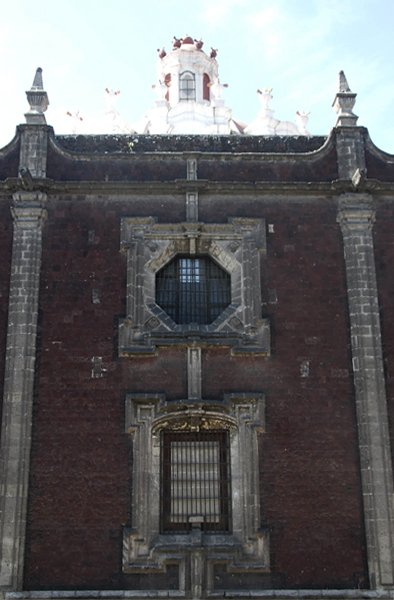
Third Order
Associations of the faithful established by religious orders. Dating from the thirteenth century, they may be either secular or regular. If secular, they are lay persons, commonly called tertiaries. If regular, they are religious, bound by public vows and live in communities. Originally, third orders were Franciscan or Dominican, but the Holy See has since approved many others, both secular and regular, e.g., the Augustinians, Carmelites, Servites, and Trinitarians.
(definition from Hardon, John A. Modern Catholic Dictionary, Doubleday & Company, Inc., Garden City, New York, 1966, p. 538)
Example: Tepeapulco, Hidalgo, San Francisco, Third Order chapel façade

Tlacuilo
{…} either “painter” or “scribe”. In view of the pictorial nature of pre-Hispanic texts, it is not surprising there was no distinction between writing and painting. {…} Pre-Hispanic painters were not simply craftsmen but were considered wise men with access to a body of esoteric, ritual, calendric, and genealogical knowledge.
(definition from Peterson, Jeanette Favrot. The Paradise Garden Murals of Malinalco: Utopia and Empire in Sixteenth-Century Mexico, University of Texas Press, Austin, 1993, p. 46)
Trabeated
Descriptive of construction using beams or lintels, following the principle of post and lintel construction, as distinguished from using arches and vaults.
Example: Cochiti Pueblo, New Mexico, San Buenaventura, trabeated façade
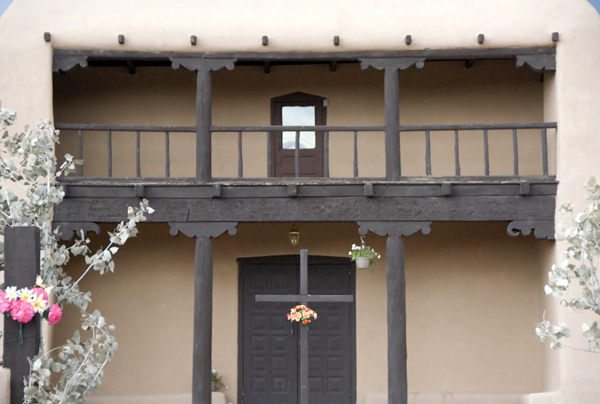
Tracery
The curvilinear openwork shapes of stone or wood creating a pattern within the upper part of a Gothic window, or an opening of similar character, in the form of mullions which are usually so treated as to be ornamental. By extension, similar patterns applied to walls or panels.
Example: Yecapixtla, Morelos, San Juan Bautista, façade, rose window tracery
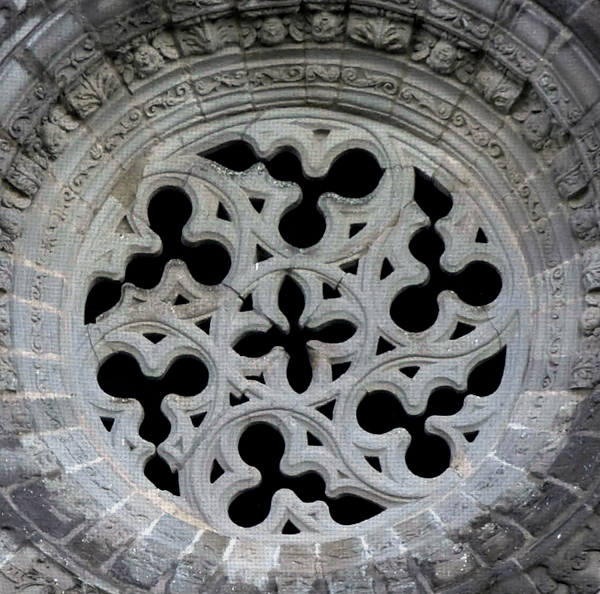
Transept
The transverse portion of a church crossing the main axis at a right angle and producing a cruciform plan.
Example: Tuscon, Arizona, San Javier del Bac, nave crossing and West transept
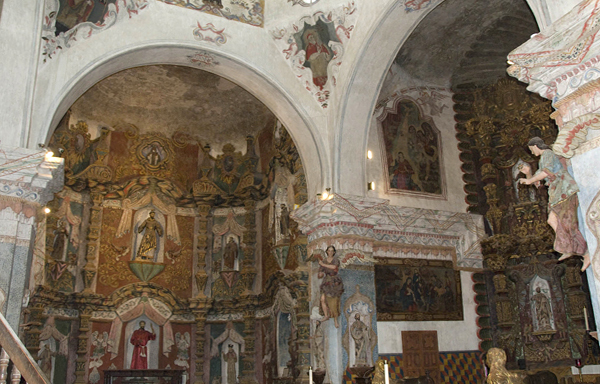
Transverse
A defensive barrier, parapet, or the like, placed transversely.
(definition from Online WordReference.com)
Example: Campeche, Campeche, Baluarte de San Francisco, bastion transverse
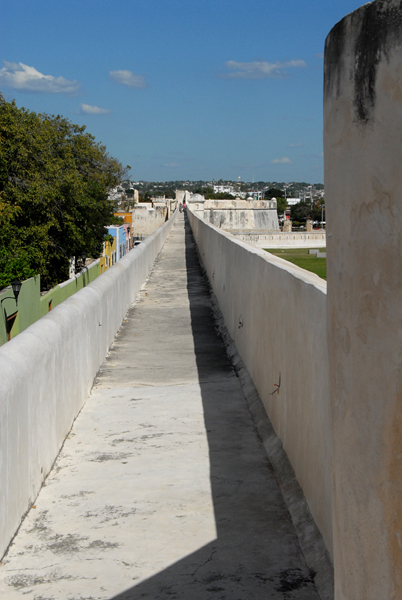
Trefoil
A three-lobed, cloverleaf pattern.
Example: Tecamachalco, Puebla, La Asunción de Nuestra Señora, porciúncula door, trefoil arch
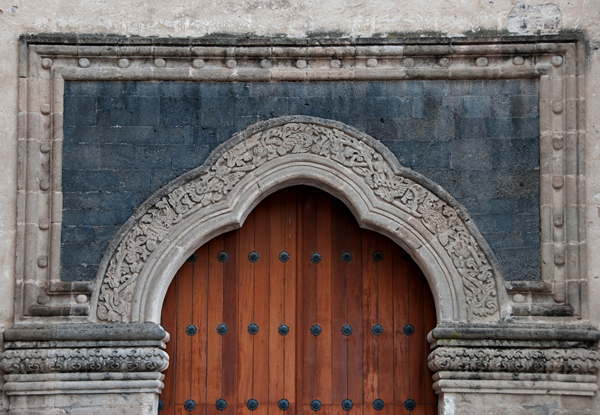
Tribune
A raised part, or gallery, with seats, as in a church. (definition from Dictionary.com)
Example: México, D.F., San Fernando, north transept tribunal

Triumphal arch see Chancel arch
Example: Acaxochitlán, Hidalgo, La Asunción de María, triumphal arch & sanctuary

Turret
A diminutive tower, characteristically corbeled from a corner.
Example: Cuilápam de Guerrero, Oaxaca, Santiago Matamoros, exterior capilla abierta basilica, South turret
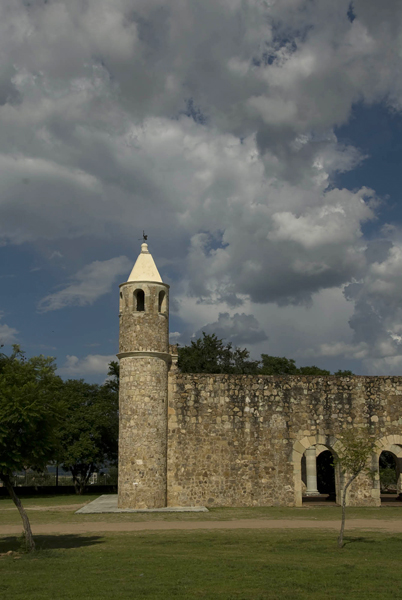
Ultrabaroque
see Anastyle Baroque
Example: Taxco, Guerrero, Santa Prisca, Capilla del Padre Jesús, Nuestra Señora altar
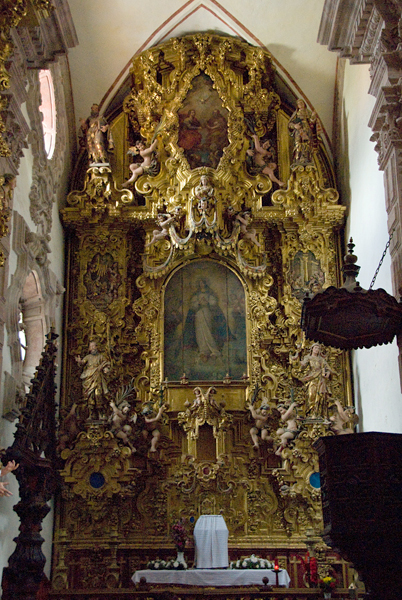
Verónica (Veronica's Veil)
The cloth with which tradition holds that the saintly Veronica wiped the face of Jesus on his way to Calvary. Christ is said to have left the imprint of his face on the veil. It is honored as a treasured relief at St. Peter’s in Rome. The episode is commemorated in the sixth station of the cross. Veronica is sometimes identified with the woman whom Christ healed of an issue of blood.
(definition from Hardon, John A. Modern Catholic Dictionary, Doubleday & Company, Inc., Garden City, New York, 1966, p. 560)
Example: Yucucui, Oaxaca, San Mateo, nave Crucifixion retablo detail, verónica

Vestibule
An anteroom or small foyer leading into a larger space.
Example: Zinapécuaro, Michoacán, San Juan Bautista, façade, main portal vestibule
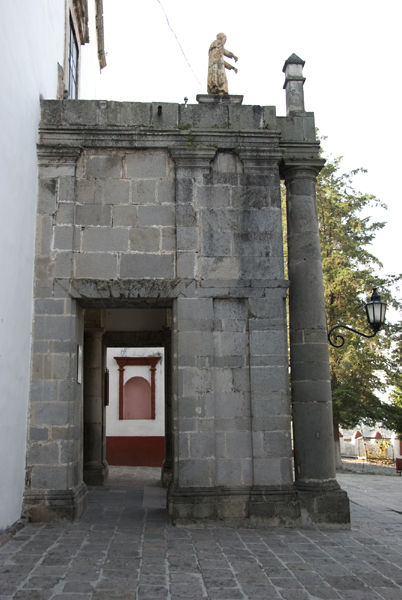
Via Crucis
see Stations of the Cross
Example: San Juan del Rio, Querétaro, San Juan de Dios, nave painting, Via Crucis

Visita
A town in the jurisdiction of a monastery where friars did not live but which they visited periodically to say Mass.
(definition from McAndrew, John. The Open-Air Churches of Sixteenth-Century Mexico: Atrios, Posas, Open Chapels and other Studies, Harvard University Press, Cambridge, Massachusetts, 1965, p. 663)
Example: Tlacolula, Hidalgo, San Agustín (visita of Metztitlán)
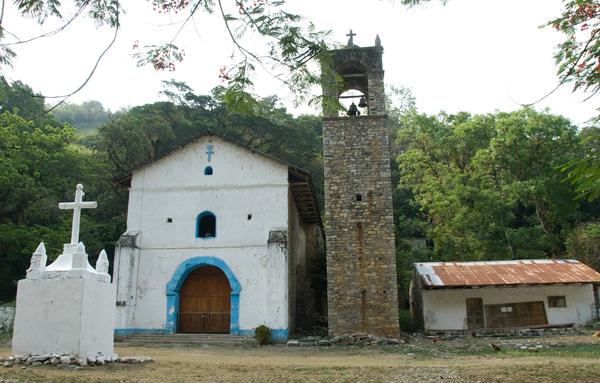
Volute
A spiral scroll.
Example: Querétaro, Querétaro, San Agustín, cloister pillar volutes
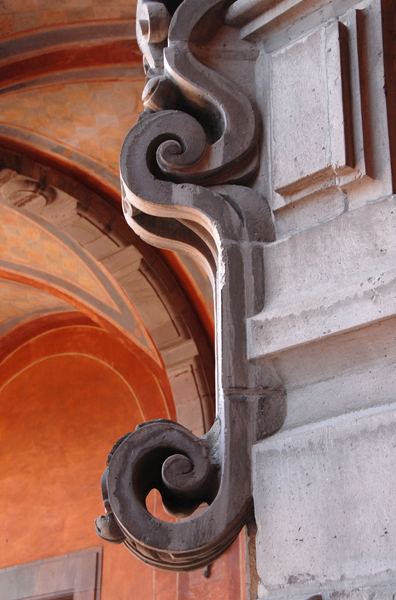
Voussoir
A wedge-shaped masonry unit in an arch or vault whose converging sides are cut as radii of one of the centers of the arch or vault.
Example: Santa Cruz de las Flores, Jalisco, Santa Cruz, left portal archivolt voussoir
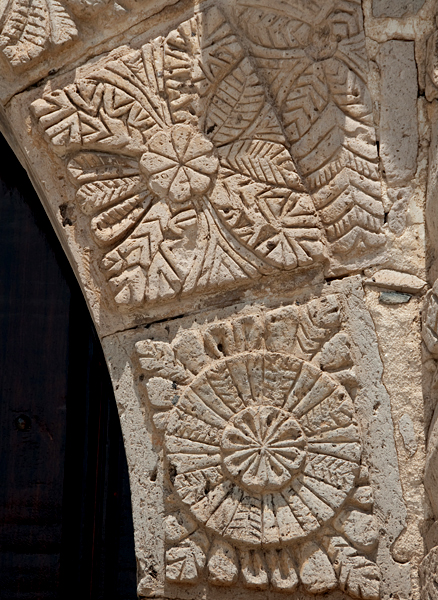
Webbing
The vault surfaces between the ribs of a ribbed vault (definition from Online Glossary of Medieval Art and Architecture)
Example: Hueytlalpan, Puebla, San Andrés, nave vault webbing
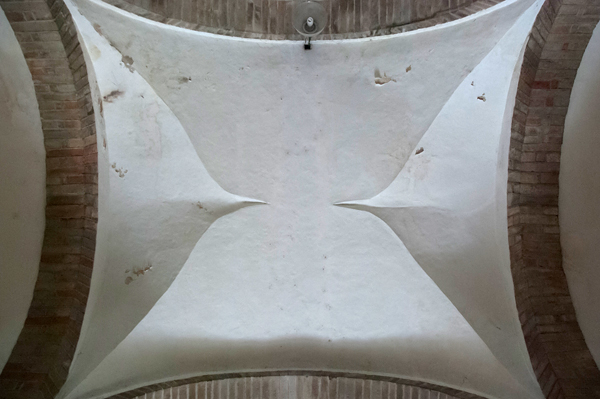
Xacal (Jacal)
A thatched hut, commonly with adobe walls.
(definition from McAndrew, John. The Open-Air Churches of Sixteenth-Century Mexico: Atrios, Posas, Open Chapels and other Studies, Harvard University Press, Cambridge, Massachusetts, 1965)
Example: San Francisco Cuayalab, San Luis Potosí, xacal
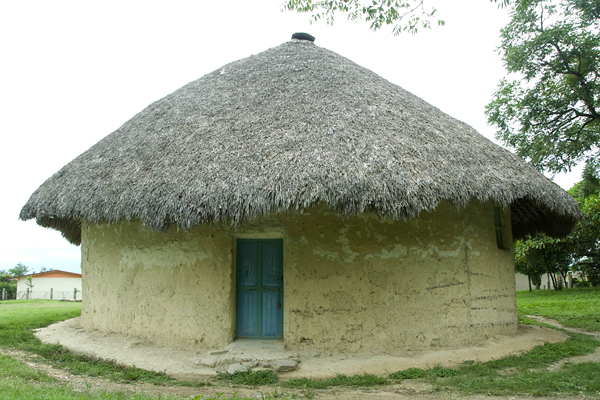
Yurishio
A word in the native Tarascan language of Purépecha in reference to the chapel in the Pueblo-Hospital compounds that were predominantly founded by the Franciscan and to a lesser degree the Augustinian orders in the 16th century. Many survive in Michoacán and, to a lesser extent, in the adjacent states of Jalisco, Zacatecas and Guanajuato. Although their architectural adornment is minimal, in the late 18th – early 19th century the wooden nave ceilings of a number of them were vibrantly painted with imagery usually designed to complement the Liturgy. (personal definition)
Example: Santa María de los Angeles, Jalisco, yurishio
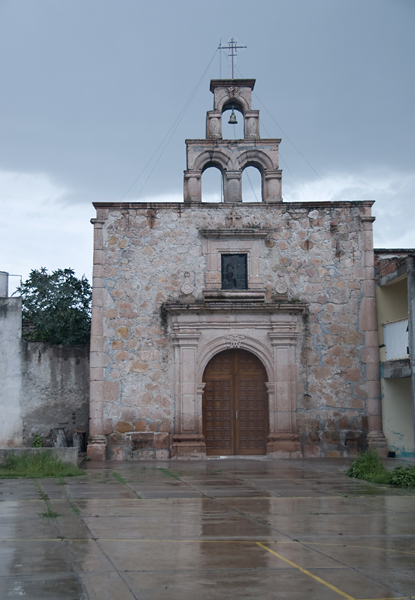
Zaguán
In Spanish Colonial architecture, a vestibule.
Example: San Lorenzo, Michoacán, guatápera zaguán
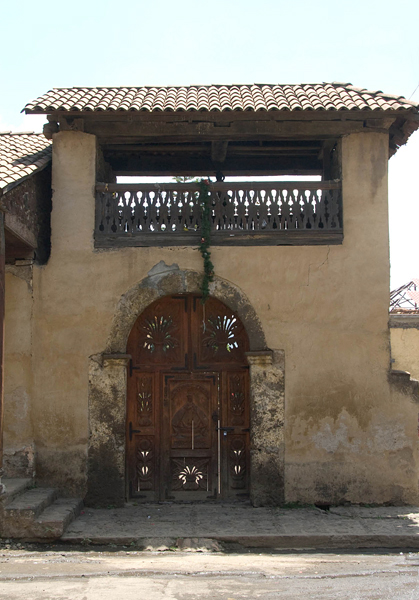
Zapata
In Spanish colonial architecture of the Americas, a horizontal piece of wood, atop a post, that provides greater bearing area to support the load imposed on the post from above; usually carved.
Example: Acuitlapan, Guerrero, San Francisco, sotocoro zapata
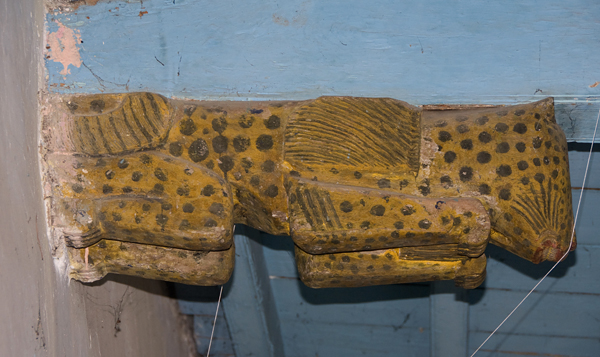
Zócalo
The main square or in Mexican cities/towns.
(definition from Online Spanish-English dictionary).
Example: México, D.F., zócalo
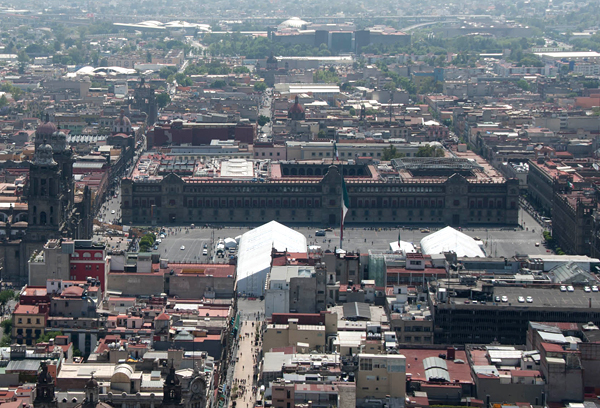
When not otherwise indicated, the below definitions are taken from the Illustrated Dictionary of Historic Architecture, edited by Cyril M. Harris, Dover Publications, Inc., New York, 1977. As cited, a number come from the 1997 Mexico Blue Guide, whose exhaustive documentation of the art and architecture of Viceregal Mexico was compiled by expert enthusiast John Collis. Many other sources were used to best summarize the meaning of particular terms, while a certain few represent my own, personally crafted interpretations. Nearly every definition is followed by an illustrative example whose Mexican location is detailed and the term itself italicized.
"Architecture never lies about the people it serves." -- John Cloag
p. xii, Introduction by John Cloag.
A Short History of Architecture by Dora Ware & Betty Beatty (George Allen & Unwin, 1953)
Acanthus
A common plant of the Mediterranean, whose leaves, stylized, form the characteristic decoration of capitals {...}.
Example: Quiroga, Michoacán, San Diego de Alcalá, façade portal, acanthus relief (right)

Acequia
A community-operated watercourse used in Spain and former Spanish colonies in the Americas for irrigation.
(definition from Online The Free Encyclopedia Wikipedia)
Example: San Matías Atzala, Puebla, hacienda San Matías, acequia

Adobe
A heavy soil composed largely of soil and silt in sufficient quantities to form a matrix in which sand particles are firmly embedded; water is added, and straw, manure and fragments of tile are sometimes combined with this mixture to provide increased mechanical strength and cohesion when it dries. It can be used as a plaster or formed into bricks, often shaped by hand in a wooden form, then sun-dried; widely used in Spanish Colonial Architecture and its derivatives. Adobe brick walls are often plastered to improve resistance to weather; a coating such as slaked lime acts as a stabilizing agent.
Example: Chimayó, New Mexico, El Santuario de Nuestro Señor de Esquipulas, adobe zaguán

Ajaraca
In Southern Spain, an ornament in brick walls, formed of patterns, a half brick deep, more or less complicated.
Example: Chiapa de Corzo, Chiapas, Fuente La Pila o La Corona, flying buttresses, ajaraca

Ajimez
In Islamic architecture, a twin window having arched lights which are separated by a column or mullion.
Example: Puácuaro, Michoacán, San Francisco, façade ajimez

Alfarje
A ceiling of many small pieces of wood worked into a repetitive interlacing design, often found in Moslem and mudéjar work.
(definition from McAndrew, John. The Open-Air Churches of Sixteenth-Century Mexico: Atrios, Posas, Open Chapels and other Studies, Harvard University Press, Cambridge, Massachusetts, 1965, 654)
Example: Acaxochitlán, Hidalgo, La Asunción de María, nave alfarje ceiling

Alfiz
A rectangular molding which frames a horseshoe arch; typical in Moorish architecture.
Example: San Lorenzo Ixtacoyotla, Hidalgo, San Lorenzo, façade alfiz

Alhóndiga
Store for wheat and other grains, especially for buying and selling in times of scarcity.
(definition from Collis, John and David M. Mexico Blue Guide, W.W. Norton Co., New York, 1997, p. 104)
Example: Guanajuato, Guanajuato, alhóndiga

Alicatado
The work which is executed with azulejos; used to decorate pavements and walls, especially in patios.
Example: Puebla, Puebla, La Concordia, Patio de los azulejos, alicatado walls

Aljibe
see Cistern
Example: Coixtlahuaca, Oaxaca, San Juan Bautista, subterranean cloister aljibe

Almizate
The central point of the harneruelo in carved wooden ceilings.
(definition from Online Real Academia Diccionario de la lengua española, personal translation)
Example: Tlaxcala, Tlaxcala, La Asuncón de Nuestra Señora, sotocoro,
alfarje ceiling, harneruelo almizate

Almohadillado
Pattern of square and projecting stones of a façade.
(definition from Collis, John and Jones, David M. Mexico Blue Guide, W.W. Norton & Co., New York, 1997, p. 104)
Example: Jerez de García Salinas, Zacatecas, Palacio Municipal, main portal almohadillado

Ambulatory
A covered walk of a cloister.
Example: Querétaro, Querétaro, San Francisco, lower cloister ambulatory

Anastyle Baroque
Extreme development of baroque (sometimes called Ultrabaroque; after 1750) in church façades and altarpieces, marked by ornamental niche pilasters or seeming absence of any support amid a wealth of decoration.
(definition from Collis, John, and Jones, David M. Mexico Blue Guide, W.W. Norton & Co., New York, 1997, p. 104)
Example: Ixtlán de Juárez, Oaxaca, Santo Tomás, South transept, Our Lady of the Rosary Anastyle Baroque altar

Anta
A pier or pilaster formed by the thickening at the end of a wall.
Example: Cuilápam de Guerrero, Oaxaca, Santiago Matamoros, capilla abierta, preaching pulpit passageway with arch anta

Anteportería
In a 16th century Mexican monastery, a small vestibule which annexes the portería and the cloister, often adorned with murals.
(personal definition)
Example: Morelia, Michoacán, San Agustín, convento anteportería

Anterefectory
see Sala de Profundis
Example: Huejotzingo, Puebla, San Miguel Arcángel, anterefectory

Apse
A semicircular (or nearly semicircular) or semi polygonal space, usually in a church, terminating an axis and intended to house an altar.
Example: Cuauhtinchán, Puebla, San Juan Bautista, apse

Arabesque
Intricate overall pattern of geometric forms or stylized plants used in Mohammedan countries.
Example: Puebla, Puebla, La Compañía, sacristy lavabo, arabesque azulejos

Arcade
see Loggia
Example: Tlaquepaque, Jalisco, Hospital de Nuestra Señora del Refugio, main patio arcade

Architrave
In the classical orders, the lowest member of the entablature; the beam that spans from column to column, resting directly upon their capitals.
Example: Maravatío, Michoacán, San Juan Bautista, façade, main portal architrave

Archivolt
An architrave, modified by being carried around a curved opening instead of a rectangular one; an ornamental molding or band of moldings on the face of an arch following the contour of the extrados.
Example: Axotla, D.F., San Sebastián, façade, main portal archivolt

Arma Christi
see Passion Symbols
Example: Ticul, Yucatán, San Antonio de Padua, side retablo dedicated to Our Lord of Esquipulas, Arma Christi details

Artesonado
Wood ceiling made up of interlacing strips or sections in a geometric pattern; Islamic in origin.
(definition from: Baird, Joseph Armstrong. The Churches of Mexico 1530-1810, University of California Press, Berkeley and Los Angeles, 1962, p. 61)
Example: Yatzachi el Alto, Oaxaca, San Baltazar, nave artesonado ceiling & beam

Atlas (Atlantes)
A figure (or figures) of a man in place of a column to support an entablature.
Example: Yanhuitlán, Oaxaca, Santo Domingo, sotocoro Santo Domingo retablo atlas

Atrial cross
In colonial Mexico, a stone cross set on a base and usually positioned in the center of the conventual church atrio, at times replete with carvings of the Arma Christi and displaying the face of Christ incised at the front crossing its shaft, neck and arms.
(personal definition)
Example: San Pablo de las Salinas, México, San Pablo, atrial cross, back

Atrio
An atrium. The space in front of a church, usually enclosed or raised on a terrace with the church.
(definition from: Baird, Joseph Armstrong. The Churches of Mexico 1530-1810, University of California Press, Berkeley and Los Angeles, 1962, p. 62)
Example: Metztitlán, Hidalgo, Los Santos Reyes, atrio

Attic
The highest-most portion of an altarpiece or retablo, often jutting above the top tier and
crowning the entire ensemble in the form of an individual statue or sculptural grouping.
(personal definition)
Example: Ixtlán de Juárez, Oaxaca, Santo Tomás, South nave St. Francis retablo, attic relief, God the Father

Augustinian
Also called Austin, in the Roman Catholic Church, member of any of the religious orders and congregations of men and women whose contributions are based on the Rule of St. Augustine, {namely the} instructions on religious life written by Augustine, the great Western theologian, and widely disseminated after his death, A.D. 430. More specifically, the name is used to designate members of two main branches of Augustinians, namely, the Augustinian Canons and the Augustinian Hermits, with their female offshoots. The Augustinian Canons, or August Canons (in full, the Canons Regular of Saint Augustine), were, in the 11th century, the first religious order of men in the Roman Catholic Church to combine clerical status with a full common life. The moral impulse emanating from the Roman synods of 1059 and 1063 and the Gregorian Reform led many canons to give up private ownership and to live together according to monastic ideals. By 1150 the adoption of the Rule of St. Augustine by these canons was almost universal. The order grew and flourished until the Protestant Reformation, during which time many of its foundations perished. {…}
(definition from The New Encyclopaedia Britannica, Chicago, London, New Delhi, Paris, Seoul, Sydney, Taipei, Tokyo, 2003, vol I, p. 700)
Example: Actopan, Hidalgo, San Nicolás de Tolentino, sala de profundis, North wall, Erimitic Life mural detail, Augustinian friars

Aureole
A pointed oval frame or glory around the head of body of a sacred figure; the radiance surrounding it.
Example: San Nicolás Atecoxco, Hidalgo, San Nicolás, façade gable, aureole relief

Azulejo
An earthenware tile of Spanish manufacture painted and enameled in rich colors, especially one having a metallic luster.
Example: México, D.F., ex-Hospital San Juan de Dios, kitchen azulejos

Baldachin
An ornamental canopy over an altar, usually supported on columns, or a similar form over a tomb or throne.
Example: Puebla, Puebla, Santo Domingo, Capilla del Rosario, high altar baldachin

Balustrade
An entire railing system (as along the edge of a balcony) including a top rail and its balusters, and sometimes a bottom rail.
Example: México, D.F., Casa de los Condes de San Mateo de Valparaíso, spiral stairwell & balustrade

Banderole
A decorative representation of a ribbon or long scroll, often bearing an emblem or inscription.
Example: Aculco, México, San Jerónimo, gable relief, St. Rose of Lima emitting a banderole

Baptismal font
A stone, metal, or wooden receptacle, usually ornamented, for holding baptismal water used in the solemn administration of the sacrament. According to common law, every parish church must have a baptismal font. (definition from Hardon, John A. Modern Catholic Dictionary, Doubleday & Company, Inc., Garden City, New York, 1966, p. 53)
Example: Charapán, Michoacán, San Antonio, baptismal font

Baptistry / Baptistery
A building or part of one where the sacrament of baptism is administered.
Example: San Miguel del Valle, Oaxaca, San Miguel Arcángel, baptistry with baptismal font & mural

Baroque
In Mexican architecture the style may be taken as developing from a more subjective and imaginative approach than the Mannerist leading to a dramatic focus of design elements and manifesting varying phases: (i) transitional (from mid-17C); (ii) solomonic baroque, marked by use of salomónica (late 17C-early 18C; (iii) churrigueresque (circa 1720-80); (iv) anastyle baroque; (v) neostyle baroque (both after 1750).
(definition from Collis, John, and Jones, David M. Mexico Blue Guide, W.W. Norton & Co., New York, 1997, pps. 104-105)
Example: Guadalajara, Jalisco, Palacio Gobierno, main Baroque entrance

Barrel Vault
A masonry vault of plain, semicircular cross section supported by parallel walls or arcades; a vault having a semi cylindrical roof.
Example: Ocuituco, Morelos, Santiago Apóstol, lower cloister ambulatory, barrel vault

Basilica
The form of an early Christian church, a central high nave with clerestory, lower aisles along the sides only, with a semicircular apse at the end.
Example: Hueytlalpan, Puebla, San Andrés, basilica interior

Basket (handle) Arch
A flattened arch designed by joining a quarter circle to each end of a false ellipse.
Example: Coatlinchán, México, San Miguel Arcángel, lower cloister walk, basket-handle arches

Bas-relief
Sculptural relief in which the projection from the surrounding surface is slight and no part of the modeled form is undercut.
Example: Yecapixtla, Morelos, San Juan Bautista, façade, main portal, inner & outer left pillar base bas-reliefs

Bastion
A defense work, round, rectangular, or polygonal in plan, projecting from the outer wall of a fortification, principally to defend the adjacent perimeter.
Example: Campeche, Campeche, Baluarte de San Pedro, bastion

Battlement
Crenellation. A fortified parapet with alternate solid parts and openings, termed respectively merlons and embrasures or crenels.
Example: Cuauhtinchán, Puebla, San Juan Bautista, atrial wall battlement

Bénitier
see Stoup
Huamariza, Chihuahua, San Ignacio, nave bénitier

Black Robe
see Jesuit
Example: San Javier, Baja California Sur, San Francisco Javier de Viggé-Biaundó, right transept altar detail, St. Ignatius, founder of the Black Robes

Black Friar
see Dominican
Example: Cuilápam de Guerrero, Oaxaca, Santiago Matamoros, convento mural, Dominican Order lineage, Black Friars

Boss
A projecting, usually richly carved ornament placed at the intersection of ribs, groins, beams, etc. or at the termination of a molding.
Example: Cuernavaca, Morelos, La Asunción de Nuestra Señora, sotocoro vault boss

Broken Pediment
A pediment in Roman and Baroque architecture that has been split apart at its apex or at the center of its base. When broken at its apex, the gap is often filled with an urn, a cartouche, or other ornament.
Example: Sultepec, México, San Miguel Arcángel, façade, choir window, broken pediment

Buttressing
An exterior mass of masonry set at an angle to or bonded into a wall which it strengthens or supports; buttresses often absorb lateral thrusts from roof vaults.
Example: Querétaro, Querétaro, San Isidro, exterior nave buttressing

Cabildo de indios
see Tecpan
Example: Teposcolula, Oaxaca, Cabildo de indios

Cacique
Native term (West Indian origin) for chief.
(definition from Collis, John, and Jones, David M. Mexico Blue Guide, W.W. Norton & Co., New York, 1997, p. 105)
Example: Los Angeles, California, County Museum of Art, Folding Screen with Indian Wedding and Flying Pole, closeup, cacique

Caja de agua
see Cistern
Example: Cuauhtinchán, Puebla, San Juan Bautista, convento caja de agua

Camarín
Special, small room for robing an image and storing its adornments.
(definition from: Baird, Joseph Armstrong. The Churches of Mexico 1530-1810, University of California Press, Berkeley and Los Angeles, 1962, p. 62)
Example: Atotonilco, Guanajuato, Santuario de Jesús Nazareno, Capilla del Rosario, camarín de la Virgen, conchal wall

Candelieri
A term, taken from the Italian, denoting a kind of ornamental decoration, usually used in sculpture and architecture, but which can be applied to textile decoration. It consists of a vegetable decoration in which some types of leaves as acanthus or tendril ones are shown in vertical stripes or columns.
(definition Online from OpenLink Software)
Example: Chan Cenote, Yucatán, San Román, façade, main portal, right pilaster candelieri relief

Canephora (ae)
A caryatid with basket on her {his} head; used either as a support or as a freestanding garden ornament.
Example: Tetlanohcan, Tlaxcala, San Francisco, high altar closeup, canephorae

Caña de maíz
Corn pith.
(definition from Collis, John, and Jones, David M. Mexico Blue Guide, W.W. Norton & Co., New York, 1997, p. 105)
Example: México, D.F., Museo Soumaya, Christ Expiring on the Cross, caña de maiz

Cantoría
A church choir gallery.
Example: México, D.F., San Fernando, North transept mural & cantoría

Capilla abierta
An open chapel; the phrase is used loosely for certain structures of sixteenth century Mexican monasteries, usually adjacent to the church. The true open chapel had provisions for celebration of the Mass – a consecrated altar for the Host.
(definition from: Baird, Joseph Armstrong. The Churches of Mexico 1530-1810, University of California Press, Berkeley and Los Angeles, 1962, p. 62)
Example: Coixtlahuaca, Oaxaca, San Juan Bautista, capilla abierta

Capilla de indios
The generally used sixteenth century term for a capilla abierta. (definition inferred from McAndrew, John. The Open-Air Churches of Sixteenth-Century Mexico: Atrios, Posas, Open Chapels and other Studies, Harvard University Press, Cambridge, Massachusetts, 1965, p. 340)
Example: Dzibilchaltún, Yucatán, archeological site, capilla de indios

Capilla posa
A processional oratory (rarely or never a chapel) at each of the corners of some sixteenth-century Mexican monastic atriums.
(definition from: Baird, Joseph Armstrong. The Churches of Mexico 1530-1810, University of California Press, Berkeley and Los Angeles, 1962, p. 67)
Example: Calpan, Puebla, San Andrés, Northwest atrio corner, capilla posa, East façade

Capital
The topmost member, usually decorated, of a column
pilaster, anta, etc. It may carry an architrave or an arcade or be surmounted by an impost block.
Example: Erongarícuaro, Michoacán, Asunción de Nuestra Señora, portería, arch capital

Capuchin
Member of the order of Friars Minor Capuchin (O.F.M.Cap.), an autonomous branch of the Franciscan order of religious men, begun as a reform movement in 1525 by Matteo da Bascio, who wanted to return to a literal observance of the rule of St. Francis of Assisi and to introduce elements of the solitary life of hermits. {…}
(definition from The New Encyclopaedia Britannica, Chicago, London, New Delhi, Paris, Seoul, Sydney, Taipei, Tokyo, 2003, vol II, p. 838)
Carmelite
Member of one of the four great Mendicant orders (those whose corporate as well as personal property made it necessary for them to beg for alms) of the Middle Ages. The origin of the order can be traced to Mt. Carmel in Palestine, where a number of devout men, apparently former pilgrims and crusaders, established themselves near the traditional foundation of Elijah, an Old Testament prophet, about 1155. Their rule was written between 1206 and 1214 by St. Albert, Latin patriarch of Jerusalem, and approved in 1226 by Pope Honorius III. {…}
(definition from The New Encyclopaedia Britannica, Chicago, London, New Delhi, Paris, Soeul, Sydney, Taipei, Tokyo, 2003, vol II, p. 876)
Example: San Angel, D.F., San Angelo Martír, Capilla del Señor de Contreras, Carmelite lineage painting

Caracol
A staircase, tightly wound and snaillike (caracol meaning “snail” in Spanish), constructed within a church bell-tower and most commonly found in those of the Yucatan peninsula. (personal definition)
Example: Sacalum, Yucatán, San Antonio de Padua, façade & caracol

Carnel
see Embrasure
Example: Jaltepec, Hidalgo, San Francisco, atrial wall, crenellation carnel

Cartouche
An ornamental tablet often inscribed or decorated, and framed with elaborate scroll-like carvings.
Example: Chimaltitlán, Jalisco, San Pascual de Bailón, façade, main portal, archivolt keystone cartouche, The Immaculate Conception

Caryatid
A supporting member serving the function of a pier, column or pilaster and carved or molded in the form of a draped, human, female figure.
Example: Libres, Puebla, San Juan Bautista, high altar caryatids

Casa curial
see Rectory
Example: Tixmehuac, Yucatán, San Miguel Arcángel, casa curial

Casa fuerte
A wall, defensive residence usually belonging to a noble family.
(definition from Online Diccionario panhispánico del español jurídico (personal translation)
Example: Cuernavaca, Morelos, the casa fuerte known as Palacio de Cortés

Casa grande
In an hacienda the building which served as residence to the family owners of the complex. (personal definition)
Example: San Antonio Matate, Jalisco, hacienda San Antonio, casa grande

Casco
A Spanish word with multiple meanings; with respect to Mexican haciendas referring to the outer walls of the complex.
(personal definition)
Example: Tenextepec, Veracruz, hacienda San Antonio, casco

Castellated
Bearing the external fortification elements of castle, in particular, battlements, turrets, etc.
Example: Campeche, Campeche, castellated Fuerte de San José el Alto

Catechumen
A learner, a person being instructed {for} receiving baptism and being admitted into the Church {…}.
(definition from Hardon, John A. Modern Catholic Dictionary, Doubleday & Company, Inc., Garden City, New York, 1966 p. 86)
Example: San Lucas Evangelista, Jalisco, young contemporary catechumens

Censer
A vessel for burning incense especially a covered incense burner swung on chains in a religious ritual.
(definition from Webster’s Ninth New Collegiate Dictionary, Merriam-Webster Inc., Publishers, Springfield, Massachusetts, 1983, p. 220)
Example: Yatzachi el Alto, Oaxaca, San Baltazar, sanctuary censer

Chancel
see Sanctuary
Example: Nicolás Romero, Michoacán, San Andrés, chancel

Chancel arch
An arch which, in many churches, marks the separation of the chancel or sanctuary from the nave or body of the church.
Example: Tlahuelilpa, Hidalgo, San Francisco, nave & chancel arch

Chemin-de-ronde
A continuous gangway behind a rampart, providing a means of communication along a fortified wall.
Example: Cuauhtinchán, Puebla, San Juan Bautista, exterior buttressing & chemin-de-ronde

Cherub(im)
Heavenly creatures mentioned in the Bible as guardians and protectors. Cherubim were the sentinels station at at Eden (Genesis 3:24); they were golden figures erected on the Ark (Exodus 25:18). Yahweh mounted a cherub to rush to the rescue of David from his enemies (II Samuel 22:11). In Christian tradition the cherubim are identified as angels.
(definition from Hardon, John A. Modern Catholic Dictionary, Doubleday & Company, Inc., Garden City, New York, 1966, p. 96)
Example: Santa Cruz, Tlaxcala, Santa Inés, high altar, cherubim

Chichimec
Generic term for Nomadic peoples of Mesoamerica proper, who frequently caused problems for urbanized Mesoamericans by invasions/migrations.
(definition from Collis, John, and Jones, David M. Mexico Blue Guide, W.W. Norton & Co., New York, 1997, p. 105)
Example: Ixmiquilpan, Hidalgo, San Miguel Arcángel, nave mural, Chichimec warrior

Chiluca
A gray-white stone, like limestone.
(definition from Early, James. The Colonial Art of Mexico, Southern Methodist University Press, Dallas, 2001, p. 207)
Example: México, D.F., La Valvanera, twin portal window closeup, fluted pillars & finials in chiluca stone

Chinking
Material used for filling a chink in a wall.
Example: Zinapécuaro, Michoacán, San Juan Bautista, bell-tower detail, chinking with stone, mortar, obsidian & jade

Choir loft
A balcony choir area.
Example: Yautepec, Morelos, La Asunción, choir loft

Christogram
A graphic symbol of Christ.
(definition from Webster’s Ninth New Collegiate Dictionary, Merriam-Webster Inc., Publishers, Springfield, Massachusetts, 1983, p. 322)
Example: Acolman, México, San Agustín, small cloister, atrial cross, base relief, Christogram

Churrigueresque
In Mexico, an extremely ornamental architectural style (circa 1720-1800) marked by the use of the estípite.
(definition from Collis, John, and Jones, David M. Mexico Blue Guide, W.W. Norton & Co., New York, 1997, p. 105)
Example: Xicohtzingo, Tlaxcala, San Toribio, churrigueresque transept retablo

Cistern
An artificial reservoir or tank for storing water at atmospheric pressure {…} for use when required.
Example: Singuilucan, Hidalgo, San Antonio, cloister cistern

Clerestory
An upper zone of wall pierced with windows that admit light to the center of a lofty room.
Example: Chihuahua, Chihuahua, Nuestra Señora de Regla y San Francisco de Asís, nave clerestory

Cloister
A covered walk surrounding a court, usually linking a church to other buildings of a monastery.
Example: Huexotla, México, San Luis Obispo, convento cloister

Coffering
Ceiling {…or surfaces} with deeply recessed panels, often highly ornamented.
Example: Tlaxiaco, Oaxaca, Santa María de la Asunción, façade portal, archivolt coffering

Cofradía
A fraternity or brotherhood organized by members of jurisdictional authority for the purpose of engaging in works of piety (worshipping a saint, the Virgin Mary, etc.) or to provide certain services related to the specific worship.
(definition from On-line Diccionario Cofrade, catholic.net (personal translation)
Example: Sayula, Jalisco, Cofradía chapel

Confessional
A small booth furnished with a seat for a priest and a screen or latticed window through which the penitent may talk to the priest, who is hidden; the penitent may or may not be visible to the public.
Example: Magdalena Salinas, D.F., La Magdalena, nave confessional

Convento
In New Spain, a community of friars and missionizing centre. A community of nuns in town.
(definition from Collis, John, and Jones, David M. Mexico Guide Book, W.W. Norton & Co., New York, 1997, p. 105)
Note: I use the word convento interchangeably
with ‘monastery’. Whereas the word 'convent' in English defines a
society of nuns, for the purposes of this site it refers to either a
community of men or women, although most likely men within the
context of 16th century Mexico. At times it may also be used to
describe the actual physical compound once inhabited by the religious.
Example: Huaquechula, Puebla, San Martín, convento

Coping
A protective cap, top, or cover of a wall, parapet, pilaster, or chimney; often of stone, terra-cotta, concrete, metal, or wood. May be flat, but commonly sloping, double-beveled, or curved to shed water so as to protect masonry below from penetration of water from above. Most effective if extended beyond wall face and cut with a drip.
Example: Bolaños, Jalisco, San José, façade relief & roof coping

Coquillage
A representation of the forms of seashells and the like, as a decorative carving.
Example: Aranza, Michoacán, San Jerónimo, façade coquillage

Corbel
In masonry, a projection or one of a series of projections, each stepped progressively farther forward with height; anchored in a wall, story, column, or chimney; used to support an overhanging member above or, if continuous, to support overhanging courses; may support an ornament or similar appearance.
Example: Yecapixtla, Morelos, San Juan Bautista, sotocoro arch corbel

Cornice
Any molded projection which crowns or finishes the part to which it is affixed.
Example: Cuzamá, Yucatán, La Trinitaria, façade cornice

Coved vault
A vault composed of four quarter-cylindrical surfaces or coves, meeting in vertical diagonal places, the axial sections of the vault being arched, and the horizontal courses diminishing in length from spring to crown.
Example: Mérida, Yucatán, San Ildefonso, nave, coved vault

Crenel
An open space between the merlons of a battlement.
Example: Tepeji del Río, Hidalgo, San Francisco, atrial wall battlement with merlons & crenels

Crenellation
A battlement.
Example: Bokobá, Yucatán, La Aunción, apse crenellation

Creole
White born in New Spain.
(definition from Chevalier, François. Land and Society in Colonial Mexico: The Great Hacienda, translated by Alvin Eustis, edited, with foreword by Lesley Byrd Simpson, University of California Press, Berkeley and Los Angeles, 1970, p. 321)
Example: México, D.F., Castillo Chapultepec, Miguel Cabrera, closeup of his 1750 Portrait of Sor Juana Inés de la Cruz, Mexico's most famous Creole nun

Crossing
In a church, the place where the nave and sanctuary cross the transept.
Example: Yuriria, Guanajuato, San Pablo, nave crossing

Cuauhxicalli
Aztec ceremonial vessel for holding the hearts of sacrificial victims.
(definition from Perry, Richard D. Blue Lakes & Silver Cities: The Colonial Arts and Architecture of West Mexico, Espadaña Press, Santa Barbara, California, 1997, p. 258)
Example: Acatitlán, México, Santa Cecilia, repurposed cuauhxicalli as baptismal font

Cupola
A domical roof on a circular base, often set on the ridge of a roof.
Example: Juriquilla, Querétaro, hacienda, Capilla de Nuestro Señor de El Trabajo, cupola

Custodia
see Ostensory
Example: Guachicmontón, Jalisco, ex-Hacienda Labor de Rivera, capilla de San Nicolás de Tolentino, custodia

Dado
The lower part of an interior wall when specially decorated of faced; also the decoration adorning this part of a wall.
(definition from Webster’s Ninth New Collegiate Dictionary, Merriam-Webster Inc., Publishers, Springfield, Massachusetts, 1983, p. 322)
Example: Tehuantepec, Oaxaca, Santo Domingo, upper with cloister walk, dado mural

Demilune
In fortifications, a projecting outwork forming a salient angle.
Example: Campeche, Campeche, Puerta de Tierra, with bastion demilune

Diamondwork
Masonry construction in which pieces are set so as to form diamonds on the face of a wall.
Example: Teposcolula, Oaxaca, San Pedro y San Pablo, open chapel, pillar base diamondwork

Diaper
An allover pattern with motifs placed in a repeated design, especially on a rectangular of diagonal grid.
Example: Zinacantepec, México, San Miguel Arcángel, prior's cell mural, diaper motif

Domical vault
see with Coved vault
Example: Querétaro, Querétaro, Santa Clara, with sanctuary, domical vault

Dominican
By name black friar, member of the with Order of Friars Preachers (O.P.), one of the four great mendicant orders of the Roman Catholic church, was founded by St. Dominic in 1215. Dominic, a priest of the Spanish diocese of Osma, accompanied his bishop on a preaching mission among the Albigensian heretics of southern France, where he founded a nunnery at Prouille in 1206, partly for his converts, which was served by a community of preachers. From this developed the conception of an institute of preachers to convert the Albigensians, which received provisional approval from Pope Innocent III in 1215. Dominic gave his followers a rule of life based on that of St. Augustine and made his first settlement at Toulouse; on Dec. 22, 1216, Pope Honorius III gave formal sanction. {…} (definition from The New Encyclopaedia Britannica, Chicago, London, New Delhi, Paris, Seoul, Sydney, Taipei, Tokyo, 2003, vol. IV, p. 166)
Example: Tlaquiltenango, Morelos, San Francisco, with convento with anteportería mural, Dominican founders

Embrasure
see Crenel
Example: Valladolid (Sisal), Yucatán, San Bernardino de Siena, roof with crenellation embrasure

Encarnación
In New Spain, tinted finish to wooden sculpture to represent flesh.
(definition from Collis, John, and Jones, David M. Mexico Blue Guide, W.W. Norton & Co., New York, 1997, p. 106)
Example: Puebla, Puebla, Catedral de la Inmaculada Concepción, St. John Nepomuk (provenance, Cathedral's sala capitular), encarnación detail

Encomienda
A kind of trust, whereby the crown granted to a conquistador the right to the tributes of a native community, in exchange for benefits, such as the support of a priest, indoctrination, and so on.
(definition from Chevalier, François. Land and Society in Colonial Mexico: The Great Hacienda, translated by Alvin Eustis, edited, with foreword by Lesley Byrd Simpson, University of California Press, Berkeley and Los Angeles, 1970, p. 322)
Ensamblador
An architect, with maestro de obras or other artisan skilled at carpentry and joinery whose job it was to direct the assembly of the individually fabricated components of altarpieces in their desired positions within a church with nave or with sanctuary (personal definition)
Entablature
In classical architecture, the elaborated beam member carried by the columns, horizontally divided into with architrave (below), with frieze, and with cornice (above). The proportions and detailing are different for each order and strictly prescribed.
Example: Araró, Michoacán, Nuestro Señor de Araró (Nuestra Señora del Refugio), façade, main portal entablature with reliefs of God the Father, SS Peter & Paul

Entrecalle
Space between columns or with estípites.
(definition from Collis, John, and Jones, David M. Mexico Blue Guide, W.W. Norton & Co., New York, 1997, p. 106)
Example: Chihuahua, Chihuahua, Nuestra Señora de Regla y San Francisco de Asís, façade, lower tier with pilasters & entrecalle

Escutcheon
A shield on which armorial bearings are depicted; may be of any form, but the usual shape is that of a square or lozenge.
Example: Chignautla, Puebla, San Mateo, façade, with gable escutcheon

Espadaña
A small belfry; that is a section of a wall usually placed over a façade, with arched openings for holding bells.
(definition from: Baird, Joseph Armstrong. The Churches of Mexico 1530-1810, University of California Press, Berkeley and Los Angeles, 1962, p. 64)
Example: Yotholín, Yucatán, San Buenaventura, façade espadaña

Esquila
A bell wheel used during Mass. It is rotated to make the bells chime when the priest covers the holy wine and bread with his hands and when he raises the body and blood of Christ, at which times his congregation is meant to kneel. The apparatus was much more widely used before the Second Vatican Council held in October of 1962 where it used to be placed in the choir loft rather than the sanctuary from where the music and singing accompanying the Mass was then orchestrated. Prior to Vatican II, the priest gave Mass in Latin, often in a low voice and, moreover, facing East rather than West, towards the birthland of Christ. Facing his backside, the congregants might fail to determine the appropriate times to kneel, for which reason the esquila was instrumental. (personal definition)
Example: Azcapotzalco, D.F., San Felipe y Santiago, Capilla del Rosario, esquila

Estancia
Grant of land for running sheep or cattle.
(definition from Chevalier, François. Land and Society in Colonial Mexico: The Great Hacienda, translated by Alvin Eustis, edited, with foreword by Lesley Byrd Simpson, University of California Press, Berkeley and Los Angeles, 1970, p. 322)
Estipite
In Spanish and Latin-American Mannerist architecture and derivatives, a shaft of square cross section, tapering downward, frequently combined with other unusual elements, the whole used like an order.
Example: San Luis Potosí, San Luis Potosí, San Francisco, Capilla de Aranzazu, with arcade with pillars & estípites

Estípite Baroque
see Churrigueresque
Example: Acuamanalá, Tlaxcala, San Antonio, Estípite Baroque façade

Estofado
Figural and ornamental sculptural technique, involving the coating of carved wood with layers of fine gesso (q.v.) as a foundation for gilding and with polychromy. A special variant, relating to the faces and hands of figures, is called with encarnación.
(definition from: Baird, Joseph Armstrong. The Churches of Mexico 1530-1810, University of California Press, Berkeley and Los Angeles, 1962, p. 64)
Example: San Angel, D.F., San Angelo Martír, estofado sculpture of St. Michael Archangel

Extrados
The exterior curve or boundary of the visible face of the arch.
Example: Zacatecas, Zacatecas, Catedral de Nuestra Señora de la Asunción, West façade, main portal, archivolt extrados

Fanlight
A semicircular window over the opening of a door, with radiating bars in the form of an open fan.
Example: Tlaquepaque, Jalisco, Hospital de Nuestra Señora del Refugio, ambulatory fanlight

Filigree
Ornamental openwork of delicate or intricate design.
(definition from Webster’s New Collegiate Dictionary, C. & G. Merriam Company, Springfield, Massachusetts, 1980, p. 462)
Example: Puebla, Puebla, La Santísima Trinidad, choir loft, grille filigree

Finial
An ornament which terminates the point of a spire, pinnacle, etc.
Example: México, D.F., Casa de los Azulejos, roof finial

Flat arch
An arch with a horizontal, or nearly horizontal intrados; has little or no convexity.
Example: Puebla, Puebla, Casa del que mató el aminal, main portal, flat arch

Fluting
Vertical channeling (usually concave) on a columnar or pilaster shaft.
(definition from: Baird, Joseph Armstrong. The Churches of Mexico 1530-1810, University of California Press, Berkeley and Los Angeles, 1962, p. 64)
Example: Ocotlán de Morelos, Oaxaca, Santo Domingo, façade gable, fluted column

Flying buttress
A characteristic feature of Gothic construction, in which the lateral thrusts of a roof or vault are taken up by a bar of masonry, usually sloping, carried on an arch, and a solid pier or buttress sufficient to receive the thrust.
Example: Libres, Puebla, La Asunción, North bell-tower & flying buttress

Franciscan
Any member of a Christian religious order founded in the early 13th century by St. Francis of Assisi. The members of the order strive to cultivate the ideals of the order’s founder. {…} It was probably in 1207 that Francis felt the call to a life of preaching, penance, and total poverty. He was soon joined by his first followers, to whom he gave a short and simple rule of life. In 1209 he and 11 of his followers journeyed to Rome, where Francis received approval of his rule from Pope Innocent III. Under this rule, Franciscan friars could own no possessions of any kind, either individually or communally (i.e., as the property of the order as a whole). The friars wandered and preached among the people, helping the poor and the sick. They supported themselves by working and by begging for food, but they were forbidden to accept money either as payment for work or as alms. The Franciscans worked at first in Umbria and then in the rest of Italy and abroad. {…}
(definition from The New Encyclopaedia Britannica, Chicago, London, New Delhi, Paris, Seoul, Sydney, Taipei, Tokyo, 2003, vol. IV, p. 930)
Example: Mani, Yucatán, San Miguel Arcángel, nave (right) San Antonio de Padua altar; intercolumniation (left), St. Anthony Preaching to the Franciscans

Fray
Medieval fraternal greeting used by Spanish friars as a form of address.
(definition from Perry, Richard. Mexico’s Fortress Monasteries, Espadaña Press, Santa Barbara, California, 1992, p. 204)
Example: Tlalmanalco, México, San Luis Obispo, cloister walk mural,Fray Martín de Valencia

Fresco
A mural painted into fresh lime plaster; in such work water-based colors unite with the base; retouching is done in secco (dry).
Example: Puebla, Puebla, Casa del Deán, Sala de las Sibilas, Erythaea fresco mural (detail)

Fretwork
Ornamental openwork or interlaced work in relief, especially when elaborate and minute in its parts and in patterns of contrasting light and dark.
Example: Guila, Oaxaca, San Pablo, sacristy portal fretwork

Friary
A convento or mission where friars dwell.
(personal definition
Example: Fremont, California, San José mission

Frieze
A broad horizontal band of sculpted or painted decoration, especially on a wall near the ceiling.
(definition from Online Oxford Languages)
Example: Tlahuelilpa, Hidalgo, San Francisco, nave mural, frieze with medallion

Frontón
A small pediment placed over a door, niche, porch, etc.
Example: Zirosto, Michoacán, Santa Ana, North portal frontón

Gable
The vertical triangular portion of the end of a building having a double-sloping roof, from the level of the Gothic or eaves to the ridge of the roof.
Example: Chignautla, Puebla, San Mateo, façade gable

Gallina ciega
Carved out from the thick walls of colonial churches in the Yucatán, these passageways include windows and small balconies and represent a regional specialty {…}. In fact, they are a creative response to latent architectural issues, a highly original solution to the problems which in Medieval Europe had been solved by the clerestory and triforium. It is tempting for some to associate these passageways with the chemin-de-ronde of medieval fortresses. Within the tradition of ecclesiastic architecture, the effect of the Gothic clerestory and triforium may be discerned through these unique gallina ciegas, as their purposes were clearly one and the same.
(definition Online from Buenfil, Valerio. La Gallina Ciega, Una invención en Motul, La Voz de Motul, Memoria e Identidad personal translation)
Example: Mérida, Yucatán, San Ildefonso, gallina ciega

Gargoyle
A waterspout projecting from the roof gutter of a building, often carved grotesquely.
Example: Irapuato, Guanajuato, La Misericordia, exterior nave gargoyle

Garita
see Sentry Box
Example: Campeche, Campeche, Fuerte de San José El Alto, garita

Glory
The luminous halo encircling the head of a sacred person and the radiance or luminous emanation encompassing the whole.
Example: Atzitzimititlán, Tlaxcala, Nuestra Señora de Belén, cupola glory, Our Lady of Guadalupe

Glyph
A sculpted pictograph.
Example: Cuilápam de Guerrero, Oaxaca, Santiago Matamoros, capilla abierta, glyph wall relief

Gothic
The architectural style of the High Middle Ages in Western Europe, which emerged from Romanesque and Byzantine forms in France during the later 12th century. Its great works are cathedrals, characterized by the pointed arch, the ribbed vault, the development of the exterior flying buttress, and the gradual reduction of the walls to a system of richly decorated fenestration. Gothic architecture lasted until the 16th century, when it was succeeded by the classical forms of the Renaissance.
Example: Zempoala, Hidalgo, Todos Santos, nave & Gothic vaulted ceiling

Grisaille
A system of painting in grey tints of various shades; used either for decoration or to represent objects, as in relief.
Example: Culhuacán, D.F., San Juan Evangelista, convento anteportería, grisaille mural, St. Augustine protecting his Order

Groin
The ridge, edge, or curved line formed by the intersection of the surfaces of two intersecting vaults.
Example: Tzintzuntzan, Michoacán, San Francisco, convento cloister, vault groins

Groin Vault
A compound vault in which barrel vaults intersect, forming arrises called groins.
Example: Malinalco, México, El Divino Señor, lower cloister walk, testera groin vault

Groining
Any system of vaulting implying the intersection, at any angle, of simple vaults.
Example: Cholula, Puebla, San Gabriel, nave groining

Grotesque
Sculptured or painted ornament involving fanciful distortions of human and animal forms, sometimes combined with plant motifs, especially a variety of arabesque which has no counterpart in nature.
Example: Metztitlán, Hidalgo, Los Santos Reyes, nave mural, dado grotesques

Guatápera
At times written Huatápera and meaning “House of the Virgins” in the Purépecha language of the Tarascans, the word refers to the pueblo-hospital compounds established in 16th century West Mexico by the Franciscans and Augustinians to lodge, care and educate the indigenous. While the idiom guatápera comprises the entire complex (as at Uruapan and Santa Fe de la Laguna, Michoacán), its present-day usage is at times conflated with hospital chapel within the Guatápera, which in Purépecha is known as a Yurishio. Better preserved examples of the Guatápera survive at Uruapan, Zacán, Angahuan, Cheran, Chilchota, Santa Clara del Cobre, Jarácuaro, Ocumicho, and Santa Cruz el Grande, (all Michoacán except the last cited which is located in Jalisco).” (personal definition)
Example: Zacán, Michoacán, guatápera

Hacienda
In New Spain, a large rural estate.
(definition from Chevalier, François. Land and Society in Colonial Mexico: The Great Hacienda, translated by Alvin Eustis, edited, with foreword by Lesley Byrd Simpson, University of California Press, Berkeley and Los Angeles, 1970, p. 322)
Example: Bledos, San Luis Potosí, hacienda

Harneruelo
A horizontal panel which forms the central portion in carved wooden ceilings.
(definition from Online Real Academia Diccionario de la lengua española, personal translation)
Example: Angahuan, Michoacán, Santiago Apóstol, sanctuary, alfarje ceiling with harneruelo

Helicoidal
Forming or arranged in a spiral.
(definition from Webster’s New Collegiate Dictionary, C. & G. Merriam Company, Springfield, Massachusetts, 1980, p. 527)
Example: San Miguel de Allende, Guanajuato, San Felipe Neri, Santa Casa de Loreto, entrance portal, helicoidal columns

Hippocamp
Sea-horse, with the upper body of a horse and lower of a fish-like creature, often used in Classical decorations.
(definition from Online A Dictionary of Architecture and Landscape Architecture, Oxford University Press)
Example: Yecapixtla, Morelos, San Juan Bautista, façade, architrave relief, putto riding hippocamp

Hospital Chapel
see Yurishio
Example: Jarácuaro, Michoacán, Hospital Chapel

Hospitalito
see Yurishio
Example: Comanchuén, Michoacán, Hospitalito

Huatápera
see Huatápera
Example: Uruapan, Michoacán, Huatápera

Huerta
Cultivated garden or orchard.
(definition from Mexico's Fortress Monasteries by Richard Perry, Espadaña Press, Santa Barbara Press, California, 1992, p. 204)
Example: Actopan, Hidalgo, San Nicolás de Tolentino, convento huerta

Humilladero
Wayside shrine containing Crucifix.
(definition from Collis, John, and Jones, David M. Mexico Blue Guide, W.W. Norton & Co., New York, 1997, p. 106)
Example: Pátzcuaro, Michoacán, El Humilladero, façade portal

Impost
A masonry unit or course, often distinctively profiled, which receives and distributes the thrust at each end of an arch.
Example: Acatitlán, México, Santa Cecilia, façade, main portal, arch impost

Indochristian art
see Tequítqui
A type of Latin American art that combines European colonial influences with Indigenous artistic styles and traditions.
(definition from Online The Free Encyclopedia Wikipedia)
Example: Axotla, D.F., San Sebastián, façade portal, left door pilaster, Indochristian art relief

Infilling
see Webbing
Example: Cuitzeo, Michoacán, Santa María Magdalena, lower cloister walk, vault infilling

Intercolumniation
The clear space between two adjacent columns, usually measured at the lower parts of the shafts.
Example: Ahuahuaxtepec, Tlaxcala, San Andrés, façade portal, intercolumniation (right)

Interestípite
Space (often highly ornamented) between estípites.
(definition from Collis, John, and Jones, David M. Mexico Blue Guide, W.W. Norton & Co., New York, 1997, p. 107)
Example: La Valenciana, Guanajuato, San Cayetano, façade, lower story, interestípite (left)

Intrados
The inner curve or face of an arch or vault forming the concave underside.
Example: Zacatecas, Zacatecas, Nuestra Señora de la Asunción, West façade, main portal, archivolt intrados

Instruments of the Passion
see Passion Symbols
Example: Coixtlahuaca, Oaxaca, San Juan Bautista, North doorway reliefs (left), Instruments of the Passion

Isabelline Gothic
Late 15th century Spanish architectural manner in which Mudéjar, Flemish, Burgundian, and other exotic motifs are used to elaborate Gothic elements.
(definition from Collis, John, and Jones, David M. Mexico Blue Guide, W.W. Norton & Co., New York, 1997, p. 107)
Example: San Juan Evangelista, Jalisco, San Juan Evangelista, Isabelline Gothic lateral portal

Isocephalic
In bas-relief, having the heads nearly on a horizontal line; especially said of the heads of human figures in a frieze or band.
Example: Valladolid, Yucatán, San Bernardino de Sena, sanctuary niche, mural detail (left), St. Francis & isocephalic Christian disciples

Jamb
A vertical member at each side of a doorframe, window frame, or door lining.
Example: Cata, Guanajuato, Santo Señor de Villaseca, façade, main portal, right door jamb

Jesuit
Member of the Society of Jesus, a Roman Catholic order of religious men, founded by St. Ignatius of Loyola, noted for its educational, missionary, and charitable works, once regarded by many as the principal agent of the Counter-Reformation and later a leading force in modernizing the church. The Jesuits have always been a controversial group regarded by some as a society to be feared and condemned and by others as the most laudable and esteemed religious order in the Catholic Church. {…}
(definition from The New Encyclopedia Britannica, Chicago, London, New Delhi, Paris, Seoul, Sydney, Taipei, Tokyo, 2003, vol. VI, p. 541)
Example: México, D.F., Colegio de Las Vizcaínas, chapel high altar, central sculpture detail, St. Ignatius, Jesuit founder, upholding his precept

Joachimite
{…} a millenarian group, arose from the Franciscans in the thirteenth century. They based their ideas on the prior works of Joachim of Fiore (circa 1135-1202), though rejecting the Church of their day more strongly than he had. {…} Joachim’s works divide history into three ages. The first age was that of the Father. The age of the Father was the age of the Old Covenant. The second age was of the Son and therefore the world of Christianity. The third and final age would be that of the Holy Spirit. In this new age an “Eternal Gospel” would be revealed, fulfilling and replacing the organized Church. After that, society would be realigned on an egalitarian and utopian, monastic basis.
(definition from Online The Free Encyclopedia Wikipedia)
Keystone
In masonry, the central, often embellished voussoir, of an arch. Until the keystone is in place, no true arch action is incurred.
Example: Hermosillo, Sonora, San José de Batuc, façade, main portal, archivolt keystone, Trinity

Kiva
A Pueblo Indian ceremonial structure that is usually round and partly underground.
(definition from Webster’s New Collegiate Dictionary, C. & G. Merriam Company, Springfield, Massachusetts, 1980, p. 663)
Example: Gran Quivira, New Mexico, San Buenaventura, kiva

Knotwork
A carved ornamental arrangement of cord-like figures knotted together as in some kind of fringe, used to decorate voussoirs, moldings, etc.
Example: Texcoco, México, La Concepción, façade portal, pilaster knotwork (left)

Lambrequin
Originally a scalloped or cut-out cloth ornament, used often in strip form under a canopy or a baldachin. Since many of the pendent motifs, especially in wood or stone, of the estípite era were derived from such cloth (or paper) sources, the term is used by some writers to mean that motif, although in its original use it implied a row of such motifs. (definition from: Baird, Joseph Armstrong. The Churches of Mexico 1530-1810, University of California Press, Berkeley and Los Angeles, 1962, p. 65)
Example: Morelia, Michoacán, Palacio Justicia, rear entrance portal, lambrequin motif

Lantern
A windowed superstructure crossing a roof or dome.
Example: Huamantla, Tlaxcala, San Luis, dome lantern

Lavabo
In monasteries of the Middle Ages, a large stone basin from which the water flowed through a number of small orifices around the edge, for the convenient performance of ablutions before religious exercises or meals.
Example: San Luis Potosí, San Luis Potosí, San Angustín, sacristy lavabo

Lectern
In a church or lecture hall, a stand with a slanting top to hold a book, speech, or music at the proper height for reading.
Example: San Borja, Baja California, Misión San Francisco de Borja Adac, chancel, stone lectern

Lintel
A horizontal structure member (such as a beam) over an opening which carries the weight of the wall above it; often of stone or wood.
Example: Gran Quivira, New Mexico, San Buenaventura ruins, portal lintel

Log Vault
A type of vault consisting of large stone arches systematically traversed by wooden logs and interlayered with stucco. By the mid-17th century this sort of vault was common in the Yucatán peninsula where the admixture of an indigenous limestone (known in the Maya language as “sahkab”) and vegetable resins were employed in the infilling process. While conceptually similar to a barrel vault, the more cost-effective log vault resulted in the division of the Franciscan ceiling into interspersed segments of stone arches and wood beams, often yielding original if not elementary architectural compositions.
(personal definition)
Example: Santa Rita Becanchén, Campeche, San José, nave with log vault

Loggia
An extended arcade or colonnaded structure, open on one or both sides, sometimes with an upper story; an arcaded or colonnaded porch or gallery attached to a larger structure.
Example: San Pedro Tlaquilpan, Hidalgo, San Pedro Apóstol, patio loggia

Lunette
A crescent shape or semicircular area on a wall or vaulted ceiling, framed by an arch or vault.
Example: Etla, Oaxaca, San Pedro, lower cloister ambulatoryambulatory, testera lunette

Maestro de obras
see Maestro Mayor
Maestro mayor
A guild master, a position attained after a long training period as apprentice and journeyman. A maestro mayor was responsible for a monumental building venture such as a cathedral, or for a category of structures, such as the public works of Mexico City.
(definition from Schuetz, Mardith K. Architectural Practice in Mexico City: A Manual for Journeyman Architects of the Eighteenth Century, The University of Arizona Press, Tucson, 1987, p. 127)
Mannerist
In the late 16th and 17th century New Spain, the final phase of the Renaissance style. In its first stage, purist and classicizing, the strict application of Renaissance ideals in architecture and art; in its second, involving a play with accepted rules, a sort of pre-Baroque, where coldness gives way to lively decoration.
(definition from Collis, John, and Jones, David M. Mexico Blue Guide, W.W. Norton & Co., New York, 1997, p. 107)
Example: Chapultenango, Chiapas, La Asunción, lateral Mannerist portal

Manueline
Late Gothic style of Portugal, which flourished during the reign of Manuel I (1469-1521), tinged with exotic influences from Mudéjar, African, and perhaps Indian art.
(definition from Collis, John, and Jones, David M. Mexico Blue Guide, W.W. Norton & Co., New York, 1997, p. 107)
Example: Huejotzingo, Puebla, San Miguel Arcángel, porciúncula door archivolt

Marquetry
Inlaid pieces of a material, such as wood or ivory, fitted together and glued to a common background.
Example: Puebla, Puebla, Museo de Arte Barroco, Desk with Drawers & Shelves, marquetry closeup

Mercedarian
Also called NOLASCAN, member of ORDER OF OUR LADY OF MERCY, also called KNIGHTS OF SAINT EULALIA, religious order founded by St. Peter Nolasco in Spain in 1218, for the purpose of ransoming Christian captives from the Moors. It was originally a military order. St. Raymond of Penafort, Nolasco’s confessor and the author of the order’s rule, based the rule on that of St. Augustine. In addition to the usually three religious vows of poverty, chastity, and obedience, the Mercedarians took a fourth vow, to offer themselves as hostages for Christian prisoners in danger of losing their faith. {…}
(definition from The New Encyclopaedia Britannica, Chicago, London, New Delhi, Paris, Seoul, Sydney, Taipei, Tokyo, 2003, vol. VIII, p. 27)
Example: Puebla, Puebla, La Merced, façade, central relief of Our Lady of Ransom with SS Raymond Raimundo de Penafort and Mercedarian Peter Nolasco

Merlon
In a {…} parapet one of the solid alternates between the embrasures.
Example: Abasolo, Chiapas, San Martín, façade, espadaña merlon

Mestizo
Offspring of Spanish and Indian parents.
(definition from Chevalier, François. Land and Society in Colonial Mexico: The Great Hacienda, translated by Alvin Eustis, edited, with foreword by Lesley Byrd Simpson, University of California Press, Berkeley and Los Angeles, 1970, p. 322)
Example: México, D.F., Castillo Chapultepec, Pinturas de casta {serie}, De español e india, mestizo

Mixtilinear arch
In Moorish and Spanish architecture, an arch composed of various geometric shapes.
Example: San Miguel Huautla, Oaxaca, San Miguel, façade portal closeup, mixtilinear arch

Monstrance
see Ostensory
Example: Coyoacán, D.F., San Juan Bautista, Capilla del Rosario, retablo detail, monstrance

Moor
One of a mixed Arab and Berber conquerors of Spain in the 8th century A.D.
Example: Uruapan, Michoacán, Santiago Apóstol, Santiago Matamoros, closeup of trampled Moor

Moorish
Relating to the characteristic of the Moors.
Example: San Cristóbal de las Casas, Chiapas, Moorish Torre del Carmen

Morisco
A Moor in Spain, especially one who had accepted Christian baptism.
(definition from Online Oxford Languages)
Mozarabic
Northern Spanish architecture built after the 9th century by Christian refugees from Moorish domination, characterized by the horseshoe arch and other Moorish features.
Mudéjar
A Spanish style created by Moors under Christian domination in the 13th and 14th century, but retaining Islamic elements such as the horseshoe arch.
Example: Tzintzuntzan, Michoacán, San Francisco, lower cloister walk, testera ceiling, mudéjar filigree

Mullion
A vertical member separating (and often supporting) window, doors, or panels set in series.
Example: Aricutín, Michoacán, Nuestro Señor del Perdón, façade, ajimez mullion

Multifoil
Having five or more foils, lobes, or accurate divisions.
Example: Zimapán, Hidalgo, San Juan Bautista, façade, main portal, multifoil archivolt

Náhuatl
The common language of the Aztecs and some of their neighbors; the widespread official language used even in non-Aztec parts of the Aztec “Empire”.
(definition from McAndrew, John. The Open-Air Churches of Sixteenth-Century Mexico: Atrios, Posas, Open Chapels and other Studies, Harvard University Press, Cambridge, Massachusetts, 1965, p. 660)
Narthex
An enclosed porch or vestibule at the entrance to some early Christian churches.
Example: Querétaro, Querétaro, Santa Cruz, façade narthex

Nave
The middle aisle of a church.
Example: Malinalco, México, El Divino Señor, nave

Neoclassicism
Influential revival of classical architecture and sculptural style, in Mexico from the late 18th century.
(definition from Collis, John, and Jones, David M. Mexico Blue Guide, W.W. Norton & Co., New York, 1997, p. 107)
Example: Santiago Tianguistenco, México, Nuestra Señora del Buen Suceso, neoclassical nave and presbytery retablos

Neostyle Baroque
Soberer Baroque with classical elements, of late 18th century.
(definition from Collis, John, and Jones, David M. Mexico Blue Guide, W.W. Norton & Co., New York, 1997, p. 107)
Example: San Luis Potosí, San Luis Potosí, Santuario de Guadalupe, Neostyle façade

Nervure
Any one of the ribs of a groin vault, especially a rib which forms one of the sides of a compartment of the groining.
Example: Coixtlahuaca, Oaxaca, San Juan Bautista, nave nervure

Niche pilaster
see interestípite
Example: Guanajuato, Guanajuato, San Francisco, façade, lower story right, estípites & niche pilaster

Noria
A mule powered water wheel, housed in domed or thatched well house.
(definition from Perry, Richard. http://colonialmexico.blogspot.com December 31, 2018)
Example: Conkal, Yucatán, San Francisco, noria

Oculus
A small circular panel or window.
Example: San Ignacio, Baja California Sur, Misión San Ignacio Kadakaamán, façade oculus

Ogee arch
A pointed arch composed of reversed curves, the lower concave and the upper convex.
Example: Aguascalientes, Aguascalientes, Catedral de Nuestra Señora de la Asunción, façade, choir loft window relief & ogee arch

Ogival arch
In general, a pointed arch.
Example: Ixmiquilpan, Hidalgo, San Miguel Arcángel, lower cloister walk, ogival arches

Open Chapel
see Capilla abierta
Example: Tarímbaro, Michoacán, San Miguel, open chapel

Oratorian
Member of either of two separate but similar congregations of secular priests, one centered in Rome and the other in France. The Institute of the Oratory of St. Philip Neri was founded by the saint in Rome in 1575, approved in 1612, and confederated and reapproved in 1942. It consists of independent communities of secular priests held under obedience but not bound by vows, and it is dedicated to prayer, preaching, and the sacraments. {…}
(definition from The New Encyclopaedia Britannica, Chicago, London, New Delhi, Paris, Seoul21, Sydney, Taipei, Tokyo, 2003, vol. VIII, p. 980)
Example: Querétaro, Querétaro, San Felipe Neri, façade relief, San Feliipe Neri (Oratorian founder)

Order of Friars Preachers
see Dominican
Example: Oaxaca, Oaxaca, Santo Domingo, convento cloister fountain, insignia of the Order of Friars Preachers

Ostensory
A device in which the Eucharist wafer may be displayed.
Example: Puebla, Museo de Arte Barroco, forged silver ostensory

Palmette
An ornament derived from a palm leaf.
Example: Irapuato, Guanajuato, Our Lady of Solitude, façade portal detail, palmette relief

Painted Wall Retablo
A painting usually along the nave of a church which portrays a retablo. In some cases, the depiction is meant to eventually be replaced, or covered, by an actual wood-carved retablo with statuary in niches and oil paintings on canvas. In others, the painted wall retablo may act as a backdrop or optical continuation for a smaller wooden altarpiece or framed oil painting centered before it. (personal definition, with guidance by Richard Perry)
Ex: Coatlinchán, México, San Miguel Arcángel, painted wall retablo with painting of La Guadalupe (above) and sculpture of La Soledad (below)

Parade Ground
A large flat area where soldiers march and practice military movements.
(definition from Online Cambridge Dictionary)
Example: Campeche, Campeche, Fuerte de San José El Alto, parade ground & well

Parapet
A low guarding wall at any point of sudden drop, as at the edge of a terrace, roof, battlement, balcony, etc.
Example: Dzidzantún, Yucatán, Santa Clara de Asís, crenellated parapet

Passion of Christ
see Stations of the Cross
Example: México, D.F., Castillo Chapultepec, ivory Crucifixion

Passion Symbols
Emblems of Christ’s Passion and Death are usually found grouped in illustrations around the Cross. More than a dozen such symbols are found in stone carvings in several English cathedrals. Used alone or together they are also represented frequently in Italian and Spanish art of the sixteenth century: the thirty pieces of silver, the scourge with leaded thongs, the pillar and cord, the sponge, the lance, the ladder, and the winding sheet. {…}
(definition from Hardon, John A. Modern Catholic Dictionary, Doubleday & Company, Inc., Garden City, New York, 1966, p. 406)
Example: Coixtlahuaca, Oaxaca, San Juan Bautista, North doorway, Passion Symbols

Pediment
In classical architecture, the triangular gable end of the roof above the horizontal cornice, often filled with sculpture.
Example: Tlaquiltenango, Morelos, San Francisco, South portal pediment

Pendentive
One of a set of curved wall surfaces which form a transition between a dome (or its drum) and the supporting masonry.
Example: Ejutla, Oaxaca, La Natividad de Nuestra Señora, cupola pendentive, St. Mark Evangelist

Pictograph
A diagram representing statistical data by pictorial forms.
(definition from Webster’s New Collegiate Dictionary, C. & G. Merriam Company, Springfield, Massachusetts, 1980, p. 890)
Example: Tecamachalco, Puebla, Asunción de Nuestra Señora, façade, date stone pictograph

Pier
A column designed to support concentrated load.
Example: Papalotla, México, San Toribio, North atrial gate piers

Pilaster
An engaged pier or pillar, often with capital and base.
Example: Puebla, Puebla, Nuestra Señora de los Remedios, façade, main portal, left pilasters

Pillar
A pier.
Example: Teotitlan del Valle, Oaxaca, La Preciosa Sangre de Cristo, cloister pillar

Plateresque
a.) “Silversmith-like”; the richly decorative style of the Spanish Renaissance in the 16th century. Its early phase is also referred to as Isabelline Gothic architecture, after Queen Isabella I (1474-1504).
Example: Mérida, Yucatán, Casa de Montejo, plateresque façade

b.) Adaptation in 16th century New Spain of a type of Renaissance architectural decoration which flourished in Spain in the first half of the 16th century. Relief is concentrated around portals and windows, in contrast with the smooth emptiness of the rest of the façade. Plateresque can contain elements of Isabelline Gothic, a style it supersedes—flattish, dense patterns (heraldic, vegetal, geometric) of Mudéjar type, elaborating Spanish Gothic features.
(definition from Collis, John, and Jones, David M. Mexico Blue Guide, W.W. Norton & Co., New York, 1997, p. 108)
Example: Cuitzeo, Michoacán, Santa María Magdalena, plateresque façade

Polychromy
The practice of decorating architectural elements, sculpture, etc. in a variety of colors.
Example: Tlaxcala, Tlaxcala, Nuestra Señora de Ocotlán, Camarín de la Virgen cupola, Virgin Mary with Twelve Apostles in polychromy

Porciúncula
A rural chapel on the plain below Assisi, Italy, called also St. Mary of the Angels, favorite church and headquarters of St. Francis of Assisi. {…} It was probably built in the 10th or 11th century; its site is first mentioned in a document of 1045, and the chapel itself about 1150. The chapel was originally known as St. Mary of the Angles because of local reports of angelic visitations, but it was called St. Mary of the Portiuncula in the mid-13th century; later both names were used. Its proper ecclesiastical title is uncertain: it may be The Assumption, or it may be The Annunciation (as is suggested by the polyptych behind the altar painted in 1393). The church belonged to the Abbey of Saint Benedict on Mount Subasio, but it was abandoned late in the 12th century, until the young Francis repaired it in 1207. There he received his vocation and founded his first order (1208), acquiring the Portiuncula from the Benedictines (1210) and having it consecrated (1215?).
(definition from New Catholic Encyclopedia, Second Edition, Thomson Gale in association with The Catholic University of America, Washington, D.C., 2003, Volume 11, p. 527)
Note: In sixteenth-century Franciscan conventos in Mexico, the portal opening onto the atrio from the church nave’s North side is called “la puerta porciúncula” in homage to the monastic order’s founder and to his church in Assisi, Italy, St. Mary of the Portiuncula.
Example: Texcoco, México, San Francisco, porciúncular door

Portavoz
The top portion of a pulpit, suspended above the enclosed platform in which the priest or speaker stands, positioned to help carry the orator’s voice.
(personal definition)
Example: Yaxcabá, Yucatán, San Pedro, pulpit portavoz

Portería
The entrance to a monastery – usually an arcaded porch or narthex at one side of the church façade.
(definition from: Baird, Joseph Armstrong. The Churches of Mexico 1530-1810, University of California Press, Berkeley and Los Angeles, 1962, p. 67)
Example: Calimaya, México, San Pedro y San Pablo, portería

Posa Chapel
see capilla posa
Example: Izúcar de Matamoros, Puebla, Santo Domingo, atrio posa chapel

Post and Lintel
see Trabeated
Example: Acoma Pueblo, New Mexico, San Esteban, post & lintel convento loggia

Predella
The bottom tier of an altarpiece, between the principal panel or bas-relief of the altar itself.
Example: Metztitlán, Hidalgo, Los Santos Reyes, high altar predella, St. Benedict (left); two Evangelists (right)

Presbytery
see Sanctuary
Example: San Francisco Coatepec, Michoacán, San Francisco, presbytery

Presidio
In Spanish America, a frontier outpost or post.
Example: Sonoma, California, presidio

Pueblo-Hospital
see Guatápera
Example: Uruapan, Michoacán, Pueblo-Hospital

Puerta Abocinada
A concave façade.
(definition from Collis, John, and Jones, David M. Mexico Blue Guide, W.W. Norton & Co., New York, 1997, p. 108)
Example: Mérida, Yucatán, San Cristóbal, façade, puerta abocinada

Puerta chata
“Flat doorway” – The flattening of the corner of a building to accommodate a doorway.
(definition from Collis, John, and Jones, David M. Mexico Blue Guide, W.W. Norton & Co., New York, 1997, p. 108)
Example: San Luis Potosí, San Luis Potosí, Real Caja, puerta chata

Pulpit
An elevated enclosed stand in a church in which the preacher stands.
Example: Coatepec, México, La Natividad de Nuestra Señora, pulpit

Purépecha
Tarascan language and people.
(definition from Perry, Richard D. Blue Lakes & Silver Cities: The Colonial Arts and Architecture of West Mexico, Espadaña Press, Santa Barbara, California, 1997, p. 259)
Putto
In Renaissance architecture and derivatives, a decorative sculpture or painting representing chubby, usually naked infants.
Example: Ixtlán de Juárez, Oaxaca, Santo Tomás, North nave Pasión de Cristo retablo detail, putto

Quadratura
In Baroque interiors and derivatives, painted architecture, often continuing the three-dimensional trim, executed by specialists in calculated perspective.
Example: Tepetitlán, Hidalgo, San Bartolomé, nave quadratura, SS Peter & Paul beside drapery & beneath putti flanking a verónica.

Quadriga
In classical ornamentation and derivatives, the representation of a chariot drawn by four horses, i.e., a royal or divine accoutrerment.
Example: Cholula, Puebla, San Gabriel, lower cloister ambulatory, quadriga mural, Apotheosis of Saint Francis

Quincunx
An arrangements of elements so that four are symmetrically placed around a central one.
Ramada
In Spanish architecture and derivatives, a rustic arbor or similar structure.
Rectory
Originally the residence of the rector of an academic or ecclesiastical institution. Now commonly used in speaking of the residence of the priest in charge of a church or a shrine and his priest assistants.
(definition from Hardon, John A. Modern Catholic Dictionary, Doubleday & Company, Inc., Garden City, New York, 1966, p. 458)
Example: Capulalpam de Mendoza, Oaxaca, San Mateo, church apse & rectory

Refectory
A hall in a convent or monastery {…} where meals are eaten.
Example: Actopan, Hidalgo, San Nicolás de Tolentino, painted coffered ceiling of refectory

Regulars (Regular Clergy)
Men belonging to religious institutes, whether orders or congregations. In a strict canonical sense, however, regulars are members of religious orders only. The regular clergy are priests who are also bound by the religious rule (regula) of their community.
(definition from Hardon, John A. Modern Catholic Dictionary, Doubleday & Company, Inc., Garden City, New York, 1966, p. 460)
Example: Yecapixtla, Morelos, San Juan Bautista, Sala de Profundis mural detail, Resurrection

Renaissance
The architectural style developed in early 15th century Italy during the rebirth of classical art and learning. It succeeded the Gothic as the style dominant in all of Europe after the mid-16th century, and evolved through the Mannerist phase into Baroque and the early 17th century into classicism. Initially characterized by the use of the classical orders, round arches, and symmetrical composition.
Example: Tecali, Puebla, Santiago Apóstol, main Renaissance portal

Repartamiento
A weekly allotment of Indian labor.
(definition from Chevalier, François. Land and Society in Colonial Mexico: The Great Hacienda, translated by Alvin Eustis, edited, with foreword by Lesley Byrd Simpson, University of California Press, Berkeley and Los Angeles, 1970, p. 323)
Retablista
A fabricator of retablos.
(definition from: Diccionario de la lengua española, Edición del tricentenario, Real Academia Española, Online personal translation)
Retablo
An altar or altarpiece. (personal definition). "The word retablo derives from the Latin retro and tabula meaning 'behind the table', thus describing a structure which is behind the altar table". (personal translation Vargaslugo, Elisa, México Barocco, vida y arte, Salvat Editores & Grolier Editores, published in Querétaro, 1993, p. 109)
Note: In this site the word retablo is used interchangeably with altar, or altarpiece.
Example: Apizaquito, Tlaxcala, San Luis Rey, right transept retablo

Rib
Moldings which project from the surface and separate the various roof or ceiling panels.
Example: Chapultenango, Chiapas, La Asunción, sacristy ceiling ribs

Ribbed Vault
A vault in which the ribs support, or seem to support, the webbing of the vault.
Example: Atlixco, Puebla, San Francisco, ribbed vault

Ribbing
An assemblage or arrangement off ribs, as timberwork sustaining a vaulted ceiling.
Example: Metztitlán, Hidalgo, Los Santos Reyes, stairwell ribbing

Rocaille
A scroll ornament of the 18th century {...}, combining forms apparently based on those of water worn rocks, plants and shells.
Example: Lagos de Morenos, Jalisco, La Asunción de María, façade portal, rocaille relief

Rollo
Tower in plaza, from whose base justice was dispensed.
(definition from Collis, John, and Jones, David M. Mexico Blue Guide, W.W. Norton & Co., New York, 1997, p. 109)
Example: Tlaquiltenango, Morelos, rollo

Roman arch
A semicircular arch. If built of stone, all units are wedge-shaped; the usual arch in Roman architecture.
Example: Tararameo, Michoacán, San Juan Evangelista, open chapel, twin Roman arches

Rose Window
A large, circular medieval window, containing tracery disposed in a radial manner.
Example: Molango, Hidalgo, Nuestra Señora de Loreto, façade rose window

Rosette
A round pattern with a carved or painted conventionalized floral motif.
Example: Tlachichilco, Hidalgo, San Pedro, façade, main portal, left pilaster rosettes

Roundel
A small circular panel or window.
Example: Texcoco, México, San Francisco, porciúncula door, right spandrel roundel

Sacristy
A room in a church, near the sanctuary, where the robes and altar vessels are stored, where the clergy vest themselves for services, and where some business of the church may be done; usually a single room but usually a very large one.
Example: San Luis Potosí, San Luis Potosí, San Francisco, portal to sacristy

Sala Capitular
A large chamber in a monastery, usually located off the second story cloisterwalk, designated for gatherings or meetings by members of the religious order, meant to discuss matters of organization, operation, business, etc.
personal definition
Example: Cuitzeo, Michoacán, Santa María Magdalena, sala capitular

Sala de Profundis
In a monastery a chamber beside the refectory off the lower cloister walk where friars or monks say Grace prior to taking their mails. Another use for this room is to prepare deceased religious for burial, which traditionally involves the singing of one of the six penitential psalms, No. 130, i.e., the "de Profundis".
(personal definition)
Example: Yecapixtla, Morelos, San Juan Bautista, sala de profundis

Salomónica
A twisted or spiral column.
Example: Campeche, Campeche, San Francisquito, South nave, Nuestra Señora de los Dolores retablo, salomónicas

Sanctuary
In a church, the immediate area around the principal altar.
Example: Tutotepec, Hidalgo, Los Santos Reyes, sanctuary

Secco
The art of painting on dry plaster.
(definition from Webster’s New Collegiate Dictionary, C. & G. Merriam Company, Springfield, Massachusetts, 1980, p. 1060)
Example: Villa Tezontepec, Hidalgo, San Pedro Apóstol, lower cloister walk secco mural, Flight into Egypt

Seculars (Secular Clergy)
Clergy who are engaged for the most part in pastoral work and who are not members of a religious institute. They are not bound by a vow of poverty or community life. But their celibacy, in the Latin Church, is under solemn oath and they promise obedience to a bishop as their immediate superior under the Pope.
(definition from Hardon, John A. Modern Catholic Dictionary, Doubleday & Company, Inc., Garden City, New York, 1966, p. 497)
Example: Valladolid (Sisal), Yucatán, San Bernardino de Siena, nave niche mural closeup, Resurrection of Christ, secular clergy along with apostles & St. Bernadine of Siena

Sentry Box
A shelter for a sentry on his post.
(definition from Webster’s New Collegiate Dictionary, C. & G. Merriam Company, Springfield, Massachusetts, 1980, p. 1073)
Example: Perote, Veracruz, Fortaleza de San Carlos, sentry box

Seraph(im)
Angel(s) composing the highest choir of the angelic kingdom. The root meaning of their name is “to consume with fire”, indicating their intense love of the Holy Trinity.
(definition from Hardon, John A. Modern Catholic Dictionary, Doubleday & Company, Inc., Garden City, New York, 1966, p. 500)
Example: Cocucho, Michoacán, San Bartolomé, sotocoro mural detail, instrumental seraph

Seraphic Order
see Franciscan
Example: Zinacantepec, México, San Miguel, portería mural detail, lineage of the Seraphic Order

Seraphic Vision
also see Stigmata
While he was praying on the mountain of Verna {…} Francis is said to have had a vision on or about 13 September 1224, the Feast of the Exaltation of the Cross, as a result of which he received the Stigmata. Brother Leo, who had been with Francis at the time, left a clear and simple account of the event, the first definite account of the phenomenon of Stigmata. "Suddenly he saw a vision of a seraph, a six-winged angel on a cross. This angel gave him the gift of the five wounds of Christ."
(definition from Online The Free Encyclopedia Wikipedia, Stigmata, final days, and sainthood)
Example: Huichapan, Hidalgo, La Tercera Orden, lateral portal pediment, Seraphic Vision

Sgrafitto
A type of decoration executed by covering a surface, as of plaster or enamel, of one color, with a thin coat of a similar material of another color, and then scratching or scoring through the outer coat to show the color beneath.
Example: Chikindzonot, Yucatán, San Antonio de Padua, façade portal detail (right), sgrafitto

Society of Jesus
see Jesuit
Example: Coyoacán, D.F., Museo de la provincia mexicana de la Compañía de Jesús {Society of Jesus}, Juan Patricio Morlete Ruiz, Allegory of the Crucifixion with Jesuit saints, circa 1760-70

Solomonic column
see salomónica
Example: Cuautepec de Madero, D.F., La Preciosa Sangre de Cristo, façade, lower story Solomonic columns

Sotocoro
Space in church beneath the choir loft.
(definition from Collis, John, and Jones, David M. Mexico Blue Guide, W.W. Norton & Co., New York, 1997, p. 109)
Example: Nurio, Michoacán, Santiago Apóstol, sotocoro (destroyed by fire, March 7, 2021)

Spandrel
An area, roughly triangular in shape, included between the extrados of two adjoining arches and a line approximately connecting their crowns (or a space approximately equal to half this in the case of a single arch); in medieval architecture, often ornamented with tracery, etc.
Example: Querétaro, Querétaro, San Isidro, façade, main portal, right spandrel

Spindle
A turned, often decorative piece (as in a baluster).
(definition from Webster’s New Collegiate Dictionary, C. & G. Merriam Company, Springfield, Massachusetts, 1980, p. 1136)
Example: Durango, Durango, Palacio del Conde del Valle de Súchil, patio, second story balusters & spindle

Springer
The lower voussoir, or bottom stone of an arch, which lies immediately on the impostimpost.
Example: Totolinga, México, San Lorenzo, façade portal, archivolt springer (left)

S-scroll
An ornamental motif in the form of the letter S.
(definition from Collins on-line English dictionary)
Example: Tlaquepaque, Jalisco, San Pedro, façade gable detail, column and S-scroll

Stations of the Cross
A devotion formed by meditating on the Passion of Christ, successively before fourteen stations of the Cross. The stations are wooden crosses, normally attached to the interior walls of a church, although they may be erected anywhere, e.g., outside along a pathway. The pictures or representations depicting various scenes from Christi’s Via Crucis are aids to devotion on the traditional stations: 1. Jesus is Condemned to Death; 2. Jesus Bears His Cross; 3. Jesus Falls the First Time; 4. Jesus Meets His Mother; 5. Jesus is Helped by Simon; 6. Veronica Wipes the Face of Jesus; 7. Jesus Falls a Second Time; 8. Jesus Consoles the Women of Jerusalem; 9. Jesus Falls a Third Time; 10. Jesus is Stripped of His Garments; 11. Jesus is Nailed to the Cross; 12. Jesus Dies on the Cross; 13. Jesus is Taken Down from the Cross (Deposition and Lamentation); 14. Jesus is Laid in the Tomb (Entombment) {…}
(definition from Hardon, John A. Modern Catholic Dictionary, Doubleday & Company, Inc., Garden City, New York, 1966, p. 519)
Example: Tepalcingo, Morelos, Jesús Nazareno, nave sculpture, Via Crucis

Stigmata
also see Seraphic Vision
Phenomenon in which a person bears all or some of the wounds of Christ in his or her own body, i.e., on the feet, hands, side and brow. The wounds appear spontaneously, from no external source, and periodically there is a flow of fresh blood. The best known stigmatic was St. Francis of Assisi. During an ecstasy on Mount Alvernia on September 17, 1224, he saw a seraph offer him an image of Jesus crucified and imprint upon him the sacred stigmata. Blood used to flow from these wounds until the time of his death two years later. He tried to conceal the phenomenon but not very successfully. Since that time scholarly research has established some three hundred twenty cases of stigmatization, among them more than sixty persons who have been canonized {...}.
(definition from Hardon, John A. Modern Catholic Dictionary, Doubleday & Company, Inc., Garden City, New York, 1966, p. 520)
Example: Puebla, Puebla, Santa Mónica, convento museum painting, anonymous, 18th century, St. Catherine of Siena receiving the Stigmata

Stoup
A basin for holy water, sometimes free-standing but more often affixed to or carved out of a wall or pillar near the entrance of a church.
Example: Tetepango, Hidalgo, San Pedro, nave stoup

Strapwork
A type of ornament consisting of a narrow fillet or band which is folded, crossed, and interlaced.
Example: Tlacolula, Oaxaca, La Asunción, Capilla del Santo Señor, nave vault and sotocoro strapwork

Stucco
An exterior finish, usually textured; composed of portland cement, lime and sand which are mixed with water. A fine plaster used for decorative works or moldings.
Example: Santa Isabel Tepetzala, Puebla, Santa Isabel, nave vault & cupola stucco

Sudarium
see Verónica (Veronica's Veil)
Example: Puebla, Puebla, La Santa Cruz, Capilla de Santa Elena, Via Crucis painting detail, three sudariums

Sunburst
A stylistic pattern employed by the ancient Egyptians to worship the sun god Ra, in Baroque Mexico the sunburst motif is normally found in a large format as a crowning element of a retablo (such as in lieu of an attic), or within the ensemble of the altarpiece itself. It is distinguished by a pattern radiating out from a central zone usually represented in the form of the face of Christ, a crown of thorns, sudarium, a dove (the Holy Spirit), a Marian symbol, the insignia of a religious order, etc. In diminutive form the sunburst often adorns a monstrance within the tabernacle in the lower tier of the retablo. (personal definition)
Example: Yucucui, Oaxaca, San Mateo, nave Crucifixion altarpiece detail, sunburst with sudarium

Tabernacle
A decorative niche often topped with a canopy and housing a statue.
Example: San Juan Capistrano, California, San Juan Bautista, Serra Chapel, tabernacle

Tarascan
Indian tribe located primarily in the modern state of Michoacán.
(definition from Meyer, Michael C. and Beezley, William H. The Oxford History of Mexico, Oxford University Press, New York, 2000, p. 676)
Tecpan
Municipal palace for the native government.
(definition from Jackson, Robert. Evangelization and Cultural Conflict in Colonial Mexico, Cambridge Scholars Publishing, Newcastle upon Tyne, Great Britain, 2014, Introduction, p. xxii)
Example: Coixtlahuaca, Oaxaca, tecpan

Telemon(es)
A sculpted male human figure used in place of a column to support an entablature, also called an atlas.
Example: Yuriria, Guanajuato, San Pablo, façade, left closeup, telemones

Tequítqui
a.) Combining pre-Conquest Indian and early Conquest Hispanic art
forms. (definition from: Baird, Joseph Armstrong. The Churches of
Mexico 1530-1810, University of California Press, Berkeley and
Los Angeles, 1962, p. 68)
Example: Coixtlahuaca, Oaxaca, San Juan Bautista, capilla abierta, archivolt voussoirs with tequítqui relief

b.) Early Spanish colonial sculpture of European forms using pre-
Conquest stone-carving techniques.
(definition from Perry, Richard.Mexico’s Fortress Monasteries, Espadaña Press, Santa Barbara, California, 1992, p. 205)
Example: Tarécuato, Michoacán, Santa María de Jesús, atrial cross, tequítqui base

c.) Post-Conquest art using European motifs with Indian sense of
pattern. (definition from Collis, John and Jones, David M.Mexico Blue
Guide, W.W. Norton & Co., New York, 1997, p. 109)
Example: Tlamaco, Hidalgo, San Jerónimo, façade, archivolt tequítqui detail

d.) Stylistic label applied to painting and sculpture that appears to
combine naturalism and stylization, perhaps caused by native artists reconciling ancestral traditions and European approaches to image-making.
(definition from Donahue-Wallace, Kelly. Art and Architecture of
Viceregal Latin America, 1521-1821, University of New Mexico Press, Albuquerque, 2008, p. 261)
Example: Ixtapan de la Sal, México, La Inmaculada Concepción, façade, main portal, right jamb capital, tequítqui relief of Adam & Eve

Templo-fortaleza
A church-fortress.
(definition from de Gante, Pablo C. La arquitectura de México en el siglo XVI, Editorial Porrua, S.A., México, D.F., 1954, p. 83)
Example: Tepeaca, Puebla, San Francisco, templo-fortaleza, apse & external nave

Teocalli
An ancient temple of Mexico or Central America usually built upon the summit of a truncated pyramid mound.
(definition from Webster’s New Collegiate Dictionary, C. & G. Merriam Company, Springfield, Massachusetts, 1980, p. 1216)
Example:Acatitlán, México, teocalli

Tercena
see Tecpan
Example: Metztitlán, Hidalgo, Tercena

Term
A decorative figure in which a head, or a head and bust, or the human figure to the waist and including the arms, is incorporated with (as if it were springing out of) a pillar which serves as its pedestal.
Example: Querétaro, Querétaro, San Agustín, lower cloister walk, arch spandrel term

Testera
Each of the four corners -- sometimes in the partial form of recessed niches -- at the end of cloister walks (principally the lower ones) in a 16th century Mexican monastery, where tlacuilos painted didactic biblical scenes in secco for the benefit of catechumens, often meant (as with posa chapels in the church atrio ) to be visited in a processional manner, beginning from the NW testera beside the anteportería and proceeding sequentially to the SW, SE, NE and finally back to the NW one. (personal definition)
Example: Huejotzingo, Puebla, San Miguel Arcángel, lower cloister ambulatory testera

Testerian Manuscript
Named after friar Jacobo de Testera, pictorial religious works which employed pictures and images that translated into specific series of words or sounds to produce texts, such as the Ten Commandments or Catholic prayers.
(definition from Christensen, Mark Z. Nahua and Maya Catholicisms: Texts and Religion in Colonial Central Mexico and Yucatan, Stanford University Press, California, 2013, p. 22)
Tetramorph
A symbolic arrangement of four differing elements, or the combination of four disparate elements in one unit {…}. The association of the four living creatures with the Four Evangelists originated with Irenaeus in the 2nd century. The interpretation of each creature has varied through church history. The most common interpretation, first laid out by Victorinus and adopted by Jerome, St. Gregory, and the Book of Kells is that the man is Matthew, the lion Mark, the ox Luke, and the eagle John. The creatures of the tetramorph, just like the four gospels of the Evangelists, represent four facets of Christ.
(definition from Online The Free Encyclopedia Wikipedia)
Example: Tonalá, Jalisco, Santiago Apóstol, pulpit closeup, Evangelists' tetramorph

Tezontle
A reddish, or brownish, or purplish building stone of volcanic origin.
(definition from Early, James. The Colonial Art of Mexico, Southern Methodist University Press, Dallas, 2001, p. 208)
Example: México, D.F., Colegio de Las Vizcaínas, North tezontle face with windows

Third Order
Associations of the faithful established by religious orders. Dating from the thirteenth century, they may be either secular or regular. If secular, they are lay persons, commonly called tertiaries. If regular, they are religious, bound by public vows and live in communities. Originally, third orders were Franciscan or Dominican, but the Holy See has since approved many others, both secular and regular, e.g., the Augustinians, Carmelites, Servites, and Trinitarians.
(definition from Hardon, John A. Modern Catholic Dictionary, Doubleday & Company, Inc., Garden City, New York, 1966, p. 538)
Example: Tepeapulco, Hidalgo, San Francisco, Third Order chapel façade

Tlacuilo
{…} either “painter” or “scribe”. In view of the pictorial nature of pre-Hispanic texts, it is not surprising there was no distinction between writing and painting. {…} Pre-Hispanic painters were not simply craftsmen but were considered wise men with access to a body of esoteric, ritual, calendric, and genealogical knowledge.
(definition from Peterson, Jeanette Favrot. The Paradise Garden Murals of Malinalco: Utopia and Empire in Sixteenth-Century Mexico, University of Texas Press, Austin, 1993, p. 46)
Trabeated
Descriptive of construction using beams or lintels, following the principle of post and lintel construction, as distinguished from using arches and vaults.
Example: Cochiti Pueblo, New Mexico, San Buenaventura, trabeated façade

Tracery
The curvilinear openwork shapes of stone or wood creating a pattern within the upper part of a Gothic window, or an opening of similar character, in the form of mullions which are usually so treated as to be ornamental. By extension, similar patterns applied to walls or panels.
Example: Yecapixtla, Morelos, San Juan Bautista, façade, rose window tracery

Transept
The transverse portion of a church crossing the main axis at a right angle and producing a cruciform plan.
Example: Tuscon, Arizona, San Javier del Bac, nave crossing and West transept

Transverse
A defensive barrier, parapet, or the like, placed transversely.
(definition from Online WordReference.com)
Example: Campeche, Campeche, Baluarte de San Francisco, bastion transverse

Trefoil
A three-lobed, cloverleaf pattern.
Example: Tecamachalco, Puebla, La Asunción de Nuestra Señora, porciúncula door, trefoil arch

Tribune
A raised part, or gallery, with seats, as in a church. (definition from Dictionary.com)
Example: México, D.F., San Fernando, north transept tribunal

Triumphal arch see Chancel arch
Example: Acaxochitlán, Hidalgo, La Asunción de María, triumphal arch & sanctuary

Turret
A diminutive tower, characteristically corbeled from a corner.
Example: Cuilápam de Guerrero, Oaxaca, Santiago Matamoros, exterior capilla abierta basilica, South turret

Ultrabaroque
see Anastyle Baroque
Example: Taxco, Guerrero, Santa Prisca, Capilla del Padre Jesús, Nuestra Señora altar

Verónica (Veronica's Veil)
The cloth with which tradition holds that the saintly Veronica wiped the face of Jesus on his way to Calvary. Christ is said to have left the imprint of his face on the veil. It is honored as a treasured relief at St. Peter’s in Rome. The episode is commemorated in the sixth station of the cross. Veronica is sometimes identified with the woman whom Christ healed of an issue of blood.
(definition from Hardon, John A. Modern Catholic Dictionary, Doubleday & Company, Inc., Garden City, New York, 1966, p. 560)
Example: Yucucui, Oaxaca, San Mateo, nave Crucifixion retablo detail, verónica

Vestibule
An anteroom or small foyer leading into a larger space.
Example: Zinapécuaro, Michoacán, San Juan Bautista, façade, main portal vestibule

Via Crucis
see Stations of the Cross
Example: San Juan del Rio, Querétaro, San Juan de Dios, nave painting, Via Crucis

Visita
A town in the jurisdiction of a monastery where friars did not live but which they visited periodically to say Mass.
(definition from McAndrew, John. The Open-Air Churches of Sixteenth-Century Mexico: Atrios, Posas, Open Chapels and other Studies, Harvard University Press, Cambridge, Massachusetts, 1965, p. 663)
Example: Tlacolula, Hidalgo, San Agustín (visita of Metztitlán)

Volute
A spiral scroll.
Example: Querétaro, Querétaro, San Agustín, cloister pillar volutes

Voussoir
A wedge-shaped masonry unit in an arch or vault whose converging sides are cut as radii of one of the centers of the arch or vault.
Example: Santa Cruz de las Flores, Jalisco, Santa Cruz, left portal archivolt voussoir

Webbing
The vault surfaces between the ribs of a ribbed vault (definition from Online Glossary of Medieval Art and Architecture)
Example: Hueytlalpan, Puebla, San Andrés, nave vault webbing

Xacal (Jacal)
A thatched hut, commonly with adobe walls.
(definition from McAndrew, John. The Open-Air Churches of Sixteenth-Century Mexico: Atrios, Posas, Open Chapels and other Studies, Harvard University Press, Cambridge, Massachusetts, 1965)
Example: San Francisco Cuayalab, San Luis Potosí, xacal

Yurishio
A word in the native Tarascan language of Purépecha in reference to the chapel in the Pueblo-Hospital compounds that were predominantly founded by the Franciscan and to a lesser degree the Augustinian orders in the 16th century. Many survive in Michoacán and, to a lesser extent, in the adjacent states of Jalisco, Zacatecas and Guanajuato. Although their architectural adornment is minimal, in the late 18th – early 19th century the wooden nave ceilings of a number of them were vibrantly painted with imagery usually designed to complement the Liturgy. (personal definition)
Example: Santa María de los Angeles, Jalisco, yurishio

Zaguán
In Spanish Colonial architecture, a vestibule.
Example: San Lorenzo, Michoacán, guatápera zaguán

Zapata
In Spanish colonial architecture of the Americas, a horizontal piece of wood, atop a post, that provides greater bearing area to support the load imposed on the post from above; usually carved.
Example: Acuitlapan, Guerrero, San Francisco, sotocoro zapata

Zócalo
The main square or in Mexican cities/towns.
(definition from Online Spanish-English dictionary).
Example: México, D.F., zócalo
